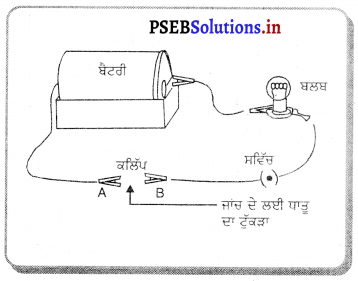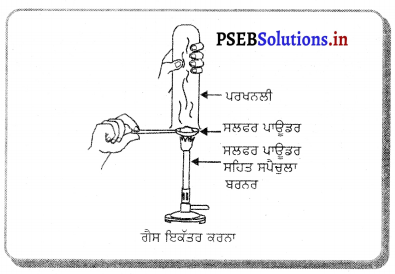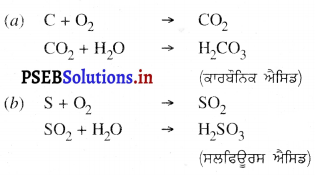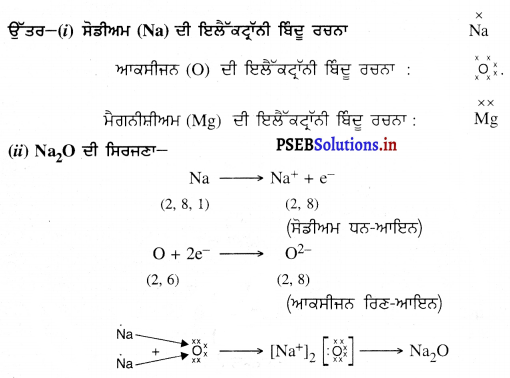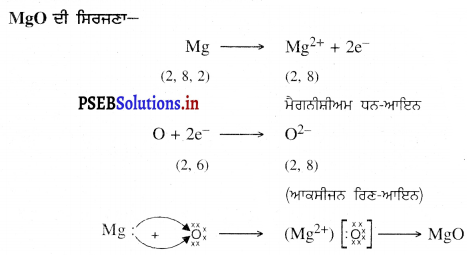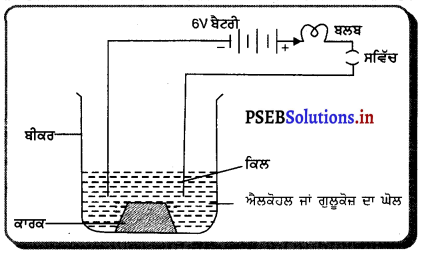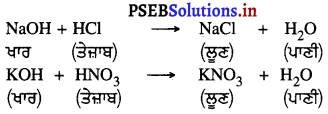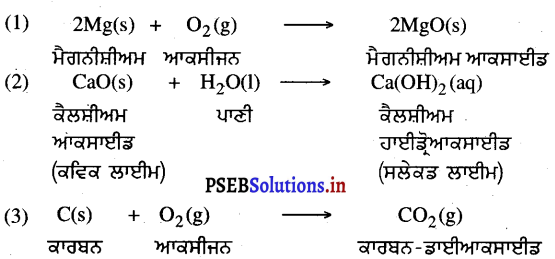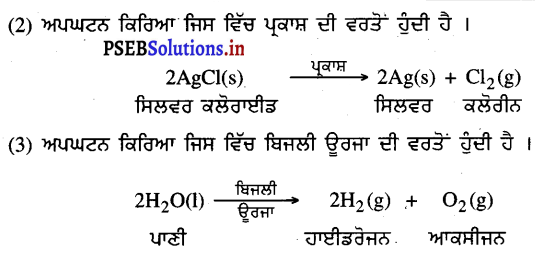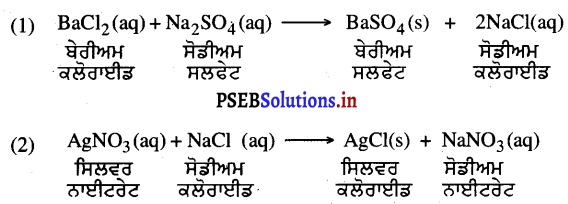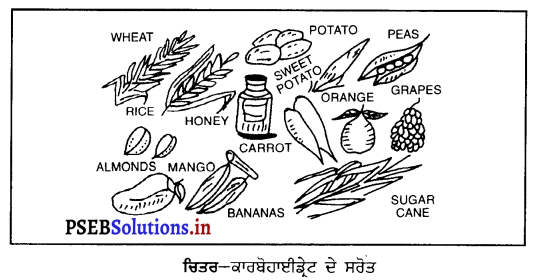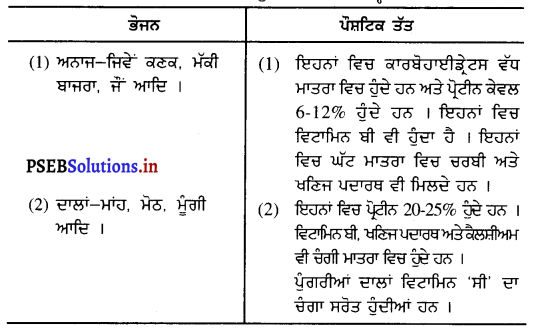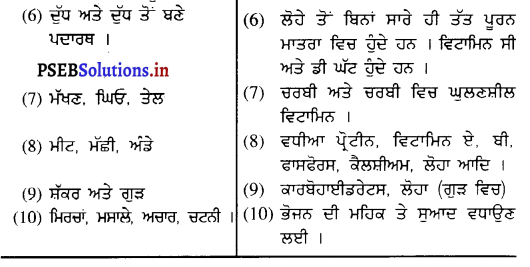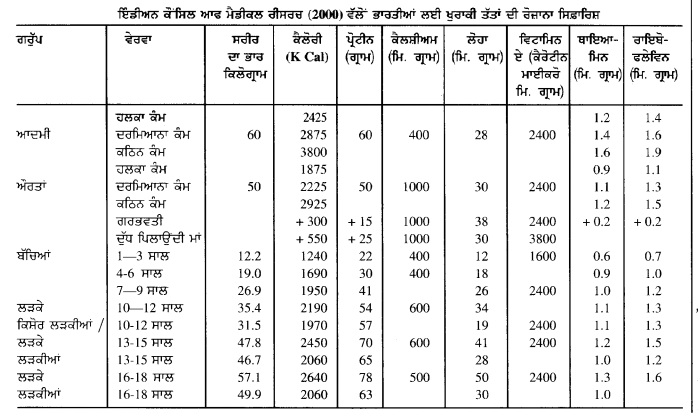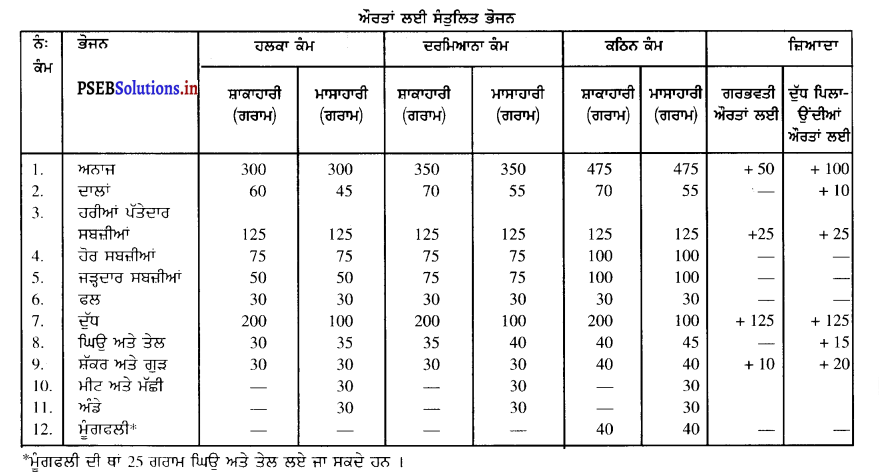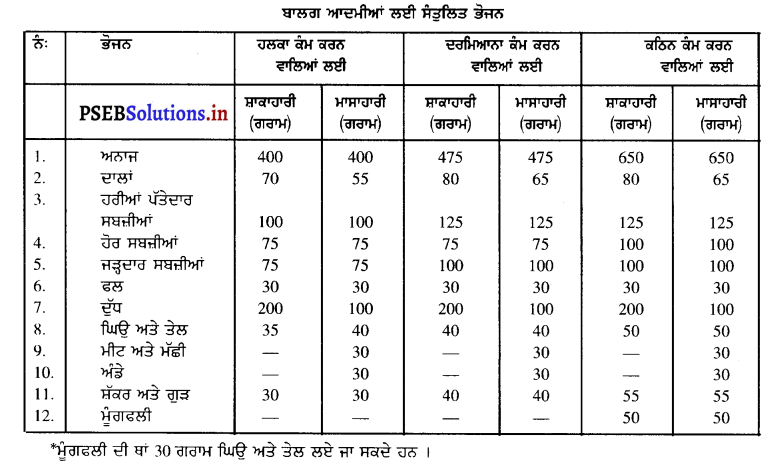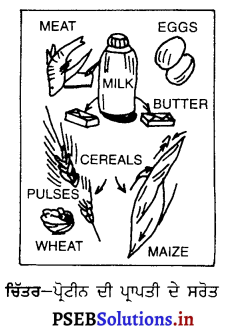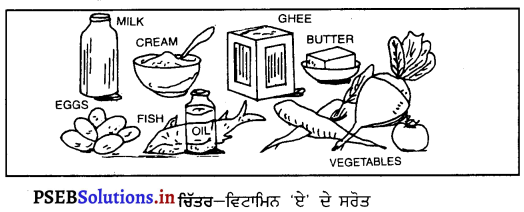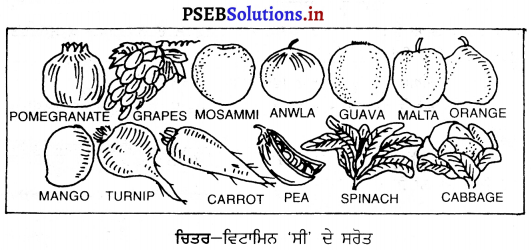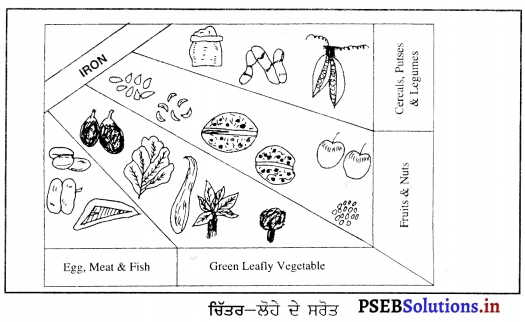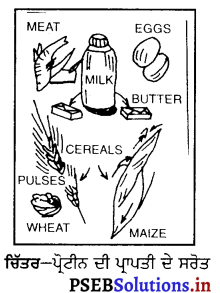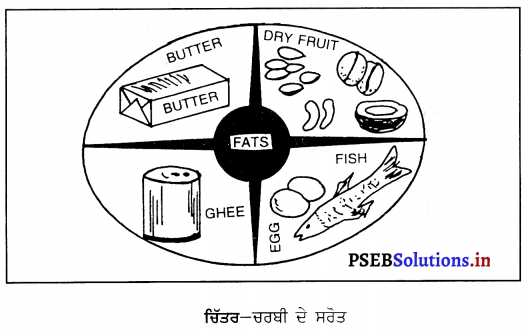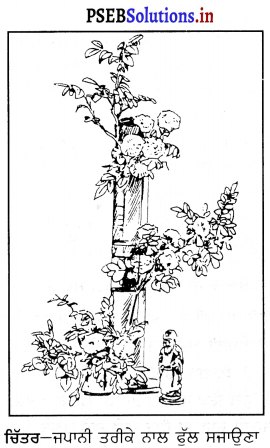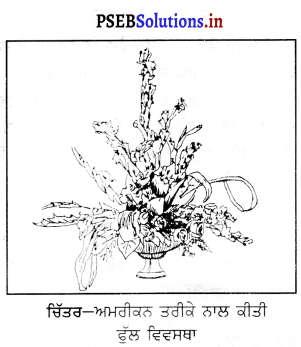Punjab State Board PSEB 10th Class Home Science Book Solutions Chapter 10 ਰੇਸ਼ਿਆਂ ਦਾ ਵਰਗੀਕਰਨ Textbook Exercise Questions and Answers.
PSEB Solutions for Class 10 Home Science Chapter 10 ਰੇਸ਼ਿਆਂ ਦਾ ਵਰਗੀਕਰਨ
Home Science Guide for Class 10 PSEB ਰੇਸ਼ਿਆਂ ਦਾ ਵਰਗੀਕਰਨ Textbook Questions and Answers
ਅਭਿਆਸ
ਵਸਤੂਨਿਸ਼ਠ ਪ੍ਰਸ਼ਨ
ਪ੍ਰਸ਼ਨ 1.
ਰੇਸ਼ਿਆਂ ਦੀ ਲੰਬਾਈ ਦੇ ਅਧਾਰ ‘ਤੇ ਉਨ੍ਹਾਂ ਨੂੰ ਕਿਹੜੀਆਂ ਸ਼੍ਰੇਣੀਆਂ ਵਿਚ ਵੰਡਿਆ ਜਾ ਸਕਦਾ ਹੈ ?
ਜਾਂ
ਛੋਟੇ ਰੇਸ਼ੇ ਅਤੇ ਲੰਬੇ ਰੇਸ਼ੇ ਕੀ ਹੁੰਦੇ ਹਨ ?
ਉੱਤਰ-
ਰੇਸ਼ਿਆਂ ਨੂੰ ਲੰਬਾਈ ਦੇ ਅਧਾਰ ‘ਤੇ ਦੋ ਸ਼੍ਰੇਣੀਆਂ ਵਿਚ ਵੰਡਿਆ ਜਾ ਸਕਦਾ ਹੈ –
- ਛੋਟੇ ਰੇਸ਼ੇ ਜਾਂ ਸਟੇਪਲ ਰੇਸ਼ੇ (Staple fibre-ਇਹਨਾਂ ਰੇਸ਼ਿਆਂ ਦੀ ਲੰਬਾਈ ਛੋਟੀ ਹੁੰਦੀ ਹੈ । ਇਸ ਦੀ ਲੰਬਾਈ ਇੰਚਾਂ ਜਾਂ ਸੈਂਟੀਮੀਟਰਾਂ ਵਿਚ ਮਾਪੀ ਜਾਂਦੀ ਹੈ । ਇਹ ਆਮ ਤੌਰ ‘ਤੇ 1/4 ਤੋਂ ਲੈ ਕੇ 18 ਇੰਚ ਤਕ ਲੰਮੇ ਹੁੰਦੇ ਹਨ । ਸਿਲਕ ਤੋਂ ਇਲਾਵਾ ਸਾਰੇ ਕੁਦਰਤੀ ਰੇਸ਼ੇ ਸਟੇਪਲ ਰੇਸ਼ੇ ਹਨ ।
- ਲੰਮੇ ਰੇਸ਼ੇ (ਫਿਲਾਮੈਂਟ (Filament_ਇਹਨਾਂ ਰੇਸ਼ਿਆਂ ਦੀ ਲੰਬਾਈ ਜ਼ਿਆਦਾ ਹੁੰਦੀ ਹੈ । ਇਸ ਨੂੰ ਮੀਟਰਾਂ ਵਿਚ ਨਾਪਿਆ ਜਾਂਦਾ ਹੈ । ਸਿਲਕ ਅਤੇ ਬਨਾਵਟੀ ਰੇਸ਼ੇ ਫਿਲਾਮੈਂਟ ਰੇਸ਼ੇ ਹੁੰਦੇ ਹਨ ।
ਪ੍ਰਸ਼ਨ 2.
ਕੁਦਰਤੀ ਫਿਲਾਮੈਂਟ ਰੇਸ਼ੇ ਦੀਆਂ ਦੋ ਉਦਾਹਰਨਾਂ ਦਿਉ ।
ਉੱਤਰ-
ਕੁਦਰਤੀ ਫਿਲਾਮੈਂਟ ਰੇਸ਼ੇ ਸਿਰਫ ਸਿਲਕ ਹੀ ਹੈ ।
ਪ੍ਰਸ਼ਨ 3. ਸੈਲੂਲੋਜ਼ ਰੇਸ਼ੇ ਕਿਹੜੇ-ਕਿਹੜੇ ਹਨ ?
ਉੱਤਰ-
ਸੈਲੂਲੋਜ਼ ਰੇਸ਼ੇ ਕਪਾਹ ਦੇ ਰੇਸ਼ਿਆਂ ਜਾਂ ਲੱਕੜੀ ਦੇ ਗੁੱਦੇ ਨੂੰ ਬਨਾਵਟੀ ਰੇਸ਼ੇ ਨਾਲ ਰਲਾ ਕੇ ਤਿਆਰ ਹੁੰਦੇ ਹਨ । ਰੇਆਨ ਦੀਆਂ ਵੱਖ-ਵੱਖ ਕਿਸਮਾਂ ਹਨ ਜਿਵੇਂ ਕਿ ਵਿਸਕੋਲ ਕਿਉਪਰਾਮੋਨੀਅਮ ਅਤੇ ਨੀਟਰੋ ਸੈਲਲੋਜ਼ ।

ਪ੍ਰਸ਼ਨ 4.
(i) ਕੁਦਰਤੀ ਰੇਸ਼ੇ ਕਿੱਥੋਂ-ਕਿੱਥੋਂ ਪ੍ਰਾਪਤ ਕੀਤੇ ਜਾਂਦੇ ਹਨ ?
(ii) ਕੁਦਰਤੀ ਰੇਸ਼ੇ ਕਿਹੜੇ-ਕਿਹੜੇ ਹੁੰਦੇ ਹਨ ?
ਉੱਤਰ-
(i) ਕੁਦਰਤੀ ਰੇਸ਼ੇ ਪੌਦਿਆਂ ਦੇ ਤਣਿਆਂ ਦੇ ਰੇਸ਼ਿਆਂ ਦੇ ਰੂਪ ਵਿਚ ਸਣ, ਪਟਸਨ ਅਤੇ ਕਪਾਹ ਤੋਂ ਪ੍ਰਾਪਤ ਹੁੰਦੇ ਹਨ । ਇਸ ਤੋਂ ਇਲਾਵਾ ਜਾਨਵਰਾਂ ਦੇ ਵਾਲਾਂ ਤੋਂ ਉੱਨ ਦੇ ਰੂਪ ਵਿਚ ਅਤੇ ਰੇਸ਼ਮ ਦੇ ਕੀੜਿਆਂ ਤੋਂ ਰੇਸ਼ਮ ਪ੍ਰਾਪਤ ਹੁੰਦਾ ਹੈ । ਕੱਚੀ ਧਾਤ ਜਾਂ ਖਣਿਜ ਪਦਾਰਥ ਦੇ ਰੂਪ ਵਿਚ ਐਸਬੈਸਟਾਸ ਦੇ ਰੂਪ ਵਿਚ ਮਿਲਦੇ ਹਨ ।
(ii) ਸਣ, ਪਟਸਨ, ਕਪਾਹ, ਰੇਸ਼ਮ ਆਦਿ ।
ਪ੍ਰਸ਼ਨ 5.
ਮਨੁੱਖ ਦੁਆਰਾ ਤਿਆਰ ਕੀਤੇ ਰੇਸ਼ਿਆਂ ਨੂੰ ਕਿਹੜੀਆਂ-ਕਿਹੜੀਆਂ ਸ਼੍ਰੇਣੀਆਂ ਵਿਚ ਵੰਡਿਆ ਜਾ ਸਕਦਾ ਹੈ ।
ਉੱਤਰ-
ਮਨੁੱਖ ਦੁਆਰਾ ਤਿਆਰ ਕੀਤੇ ਰੇਸ਼ਿਆਂ ਨੂੰ ਮੁੱਖ ਚਾਰ ਸ਼੍ਰੇਣੀਆਂ ਵਿਚ ਵੰਡਿਆ ਜਾ ਸਕਦਾ ਹੈ
- ਸੈਲੂਲੋਜ਼ ਦੇ ਪੁਨਰ ਨਿਰਮਾਣ ਤੋਂ ਪ੍ਰਾਪਤ ਹੋਣ ਵਾਲੇ ਬਨਾਵਟੀ ਰੇਸ਼ੇ-ਇਹ ਰੇਸ਼ੇ ਲੱਕੜੀ ਦੇ ਗੁੱਦੇ ਜਾਂ ਕਪਾਹ ਦੇ ਛੋਟੇ ਰੇਸ਼ਿਆਂ ਨੂੰ ਰਸਾਇਣਿਕ ਪਦਾਰਥਾਂ ਨਾਲ ਮਿਲਾ ਕੇ ਬਣਾਏ ਜਾਂਦੇ ਹਨ ।
- ਥਰਮੋਪਲਾਸਟਿਕ ਰੇਸ਼ੇ (Thermoplastic Fibres)-ਗਰਮ ਹੋਣ ਨਾਲ ਇਹ ਰੇਸ਼ੇ ਸੜਨ ਦੀ ਥਾਂ ਪਿਘਲ ਜਾਂਦੇ ਹਨ । ਇਸੇ ਲਈ ਇਨ੍ਹਾਂ ਨੂੰ ਥਰਮੋਪਲਾਸਟਿਕ ਰੇਸ਼ੇ ਕਿਹਾ ਜਾਂਦਾ ਹੈ, ਜਿਵੇਂ ਕਿ-ਨਾਈਲੋਨ, ਪੌਲਿਸਟਰ ਅਤੇ ਐਸੀਟੇਟ ਆਦਿ ।
- ਧਾਤ ਤੋਂ ਬਣੇ ਰੇਸ਼ੇ-ਗੋਟੇ, ਚਰੀ ਲਈ ਵਰਤੇ ਜਾਣ ਵਾਲੇ ਰੇਸ਼ੇ ਸੋਨਾ, ਚਾਂਦੀ, ਐਲਮੀਨੀਅਮ ਧਾਤਾਂ ਤੋਂ ਬਣਦੇ ਹਨ ।
- ਗਲਾਸ, ਫਾਇਬਰ/ਸ਼ੀਸ਼ੇ ਤੋਂ ਬਣੇ ਰੇਸ਼ੇ-ਇਹ ਰੇਸ਼ੇ ਸ਼ੀਸ਼ੇ ਨੂੰ ਪਿਘਲਾ ਕੇ ਬਣਦੇ ਹਨ ।
ਪ੍ਰਸ਼ਨ 6.
ਥਰਮੋਪਲਾਸਟਿਕ ਰੇਸ਼ਿਆਂ ਤੋਂ ਕੀ ਭਾਵ ਹੈ ?
ਜਾਂ
ਥਰਮੋਪਲਾਸਟਿਕ ਰੇਸ਼ੇ ਕੀ ਹੁੰਦੇ ਹਨ ?
ਉੱਤਰ-
ਥਰਮੋਪਲਾਸਟਿਕ ਰੇਸ਼ੇ ਬਣਾਵਟੀ ਰੇਸ਼ੇ ਹਨ ਭਾਵ ਕਿ ਮਨੁੱਖ ਦੁਆਰਾ ਬਣਾਏ ਹੋਏ । ਇਹ ਰੇਸ਼ੇ ਗਰਮੀ ਨਾਲ ਸੜਨ ਦੀ ਬਜਾਏ ਪਿਘਲ ਜਾਂਦੇ ਹਨ, ਇਸੇ ਕਰਕੇ ਇਨ੍ਹਾਂ ਨੂੰ ਥਰਮੋਪਲਾਸਟਿਕ ਰੇਸ਼ੇ ਕਿਹਾ ਜਾਂਦਾ ਹੈ ।
ਪ੍ਰਸ਼ਨ 7.
ਥਰਮੋਪਲਾਸਟਿਕ ਰੇਸ਼ਿਆਂ ਦੀਆਂ ਚਾਰ ਉਦਾਹਰਨਾਂ ਦਿਉ ।
ਉੱਤਰ-
ਨਾਈਲੋਨ, ਟੈਰੀਲੀਨ, ਪੌਲਿਸਟਰ, ਐਕਰੀਲਿਕ ਅਤੇ ਐਸੀਟੇਟ ਥਰਮੋਪਲਾਸਟਿਕ ਰੇਸ਼ਿਆਂ ਦੀਆਂ ਉਦਾਹਰਨਾਂ ਹਨ ।
ਪ੍ਰਸ਼ਨ 8.
ਰੇਔਨ ਕਿਸ ਪ੍ਰਕਾਰ ਦਾ ਰੇਸ਼ਾ ਹੈ ?
ਉੱਤਰ-
ਰੇਔਨ ਵੀ ਮਨੁੱਖ ਦੁਆਰਾ ਤਿਆਰ ਕੀਤਾ ਰੇਸ਼ਾ ਹੈ ਪਰ ਇਹ ਰੇਸ਼ੇ ਕੁਦਰਤੀ ਰੇਸ਼ਿਆਂ ਵਿਚ ਜਿਵੇਂ-ਕਪਾਹ ਜਾਂ ਪਟਸਨ ਜਾਂ ਸਣ ਦੇ ਗੁੱਦੇ ਵਿਚ ਰਸਾਇਣਿਕ ਪਦਾਰਥ ਮਿਲਾ ਕੇ ਤਿਆਰ ਕੀਤੇ ਜਾਂਦੇ ਹਨ ।
ਪ੍ਰਸ਼ਨ 9.
ਧਾਤ ਤੋਂ ਪ੍ਰਾਪਤ ਹੋਣ ਵਾਲੇ ਰੇਸ਼ੇ ਕਿਹੜੇ ਹਨ ?
ਉੱਤਰ-
ਗੋਟੇ ਅਤੇ ਜਰੀ ਦੇ ਰੇਸ਼ੇ ਸੋਨਾ, ਚਾਂਦੀ ਅਤੇ ਐਲੂਮੀਨੀਅਮ ਧਾਤਾਂ ਤੋਂ ਪ੍ਰਾਪਤ ਕੀਤੇ ਜਾਂਦੇ ਹਨ । ਇਨ੍ਹਾਂ ਧਾਤਾਂ ਨੂੰ ਪਿਘਲਾ ਕੇ ਬਾਰੀਕ ਰੇਸ਼ੇ ਤਿਆਰ ਕੀਤੇ ਜਾਂਦੇ ਹਨ । ਪਰ ਅੱਜ-ਕਲ੍ਹ ਸੋਨਾ-ਚਾਂਦੀ ਮਹਿੰਗੀਆਂ ਧਾਤਾਂ ਹੋਣ ਕਰਕੇ ਐਲੂਮੀਨੀਅਮ ਦੇ ਰੇਸ਼ੇ ਬਣਾ ਕੇ ਉਨ੍ਹਾਂ ਉੱਪਰ ਸੋਨੇ ਅਤੇ ਚਾਂਦੀ ਦੀ ਪਰਤ ਚੜ੍ਹਾਈ ਜਾਂਦੀ ਹੈ ।

ਪ੍ਰਸ਼ਨ 10.
ਪ੍ਰੋਟੀਨ ਵਾਲੇ ਰੇਸ਼ਿਆਂ ਦੀਆਂ ਦੋ ਉਦਾਹਰਨਾਂ ਦਿਉ ।
ਉੱਤਰ-
ਜਾਨਵਰਾਂ ਤੋਂ ਪ੍ਰਾਪਤ ਹੋਣ ਵਾਲੇ ਰੇਸ਼ੇ ਪ੍ਰੋਟੀਨ-ਯੁਕਤ ਰੇਸ਼ੇ ਹੁੰਦੇ ਹਨ ਜਿਵੇਂ ਕਿ ਜਾਨਵਰਾਂ-ਭੇਡਾਂ, ਊਠ ਅਤੇ ਖਰਗੋਸ਼ਾਂ ਦੇ ਵਾਲਾਂ ਤੋਂ ਬਣੀ ਉੱਨ ਪ੍ਰੋਟੀਨ-ਯੁਕਤ ਰੇਸ਼ਿਆਂ ਦੀਆਂ ਉਦਾਹਰਨਾਂ ਹਨ ਇਸੇ ਤਰ੍ਹਾਂ ਸਿਲਕ ਦੇ ਕੀੜਿਆਂ ਤੋਂ ਤਿਆਰ ਹੋਏ ਸਿਲਕ ਦੇ ਰੇਸ਼ੇ ਵੀ ਪ੍ਰੋਟੀਨ ਵਾਲੇ ਹੁੰਦੇ ਹਨ ।
ਪ੍ਰਸ਼ਨ 11.
ਮਿਸ਼ਰਤ ਰੇਸ਼ੇ ਕਿਹੜੇ ਹੁੰਦੇ ਹਨ ? ਕੋਈ ਚਾਰ ਉਦਾਹਰਨਾਂ ਦਿਉ ।
ਉੱਤਰ-
ਮਿਸ਼ਰਤ ਰੇਸ਼ੇ ਦੋ ਵੱਖ-ਵੱਖ ਤਰ੍ਹਾਂ ਦੇ ਰੇਸ਼ੇ ਮਿਲਾ ਕੇ ਤਿਆਰ ਹੁੰਦੇ ਹਨ, ਜਿਵੇਂਕਪਾਹ ਅਤੇ ਪਟਸਨ ਆਦਿ ਨਾਲ ਪੌਲਿਸਟਰ ਜਾਂ ਟੈਰੀਲੀਨ ਮਿਲਾ ਕੇ ਮਿਸ਼ਰਤ ਰੇਸ਼ੇ ਤਿਆਰ ਹੁੰਦੇ ਹਨ । ਇਸੇ ਤਰ੍ਹਾਂ ਉੱਨ ਅਤੇ ਐਕਰੀਲਿਕ ਰੇਸ਼ੇ ਮਿਲਾ ਕੇ ਕੈਸ਼ਲੋਨ ਤਿਆਰ ਕੀਤੀ ਜਾਂਦੀ ਹੈ ।
ਪ੍ਰਸ਼ਨ 12.
ਪੌਦਿਆਂ ਦੇ ਤਣਿਆਂ ਤੋਂ ਪ੍ਰਾਪਤ ਹੋਣ ਵਾਲੇ ਕੁਦਰਤੀ ਰੇਸ਼ੇ ਕਿਹੜੇ-ਕਿਹੜੇ ਹਨ ?
ਉੱਤਰ-
ਪੌਦਿਆਂ ਦੇ ਤਣਿਆਂ ਤੋਂ ਪ੍ਰਾਪਤ ਹੋਣ ਵਾਲੇ ਕੁਦਰਤੀ ਰੇਸ਼ੇ ਹੇਠ ਲਿਖੇ ਹਨਲਿਨਨ-ਜੋ ਫਲੈਕਸ ਪੌਦੇ ਦੇ ਤਣੇ ਤੋਂ ਪ੍ਰਾਪਤ ਹੁੰਦਾ ਹੈ । ਪਟਸਨ-ਇਹ ਜੂਟ ਦੇ ਪੌਦੇ ਦੇ ਤਣੇ ਤੋਂ ਪ੍ਰਾਪਤ ਹੁੰਦਾ ਹੈ । ਰੇਮੀ-ਇਹ ਵੀ ਪੌਦੇ ਦੇ ਤਣੇ ਤੋਂ ਪ੍ਰਾਪਤ ਹੁੰਦਾ ਹੈ । ਸਣ-ਇਹ ਰੇਸ਼ਾ ਵੀ ਪੌਦੇ ਦੇ ਤਣੇ ਤੋਂ ਪ੍ਰਾਪਤ ਕੀਤਾ ਜਾਂਦਾ ਹੈ ।
ਛੋਟੇ ਉੱਤਰਾਂ ਵਾਲੇ ਪ੍ਰਸ਼ਨ
ਪ੍ਰਸ਼ਨ 1.
ਮੂਲ ਗੁਣਾਂ ਤੋਂ ਇਲਾਵਾ ਰੇਸ਼ਿਆਂ ਵਿਚ ਕਿਹੜੇ-ਕਿਹੜੇ ਹੋਰ ਗੁਣ ਹੋ ਸਕਦੇ ਹਨ ?
ਉੱਤਰ-
ਰੇਸ਼ਿਆਂ ਵਿਚ ਉਨ੍ਹਾਂ ਦੇ ਮੂਲ ਗੁਣਾਂ ਤੋਂ ਇਲਾਵਾ ਹੇਠ ਲਿਖੇ ਗੁਣ ਵੀ ਹੋਣੇ ਜ਼ਰੂਰੀ ਹਨ
- ਦਿੱਖ (Luster)
- ਪਾਣੀ ਸੋਖਣ ਦੀ ਸਮਰੱਥਾ (Absorption of water)
- ਚਿਪਕਣਾ (Felting)
- ਅੱਗ-ਫੜਨ ਦੀ ਸਮਰੱਥਾ (Flammability)
- ਸੰਘਣਾਪਨ (Density)
- ਤਾਪ-ਪ੍ਰਤੀਰੋਧਕਤਾ (Resistance to heat).
- ਤੇਜ਼ਾਬ ਅਤੇ ਖਾਰਾਪਨ ਸਹਿਣ ਦੀ ਸ਼ਕਤੀ (Resistance to acid and alkalies)
- ਵੱਟ ਨਾ ਪੈਣ (Resilitience)
- ਵਲਦਾਰ ਹੋਣਾ (Crimp) ਆਦਿ ।
ਪ੍ਰਸ਼ਨ 2.
ਸੂਤੀ ਰੇਸ਼ੇ ਨੂੰ ਰੇਸ਼ਿਆਂ ਦਾ ਸਿਰਤਾਜ ਕਿਉਂ ਕਿਹਾ ਜਾਂਦਾ ਹੈ ?
ਜਾਂ
ਸੂਤੀ ਰੇਸ਼ਿਆਂ ਨੂੰ ਸਭ ਤੋਂ ਚੰਗਾ ਕਿਉਂ ਕਿਹਾ ਜਾਂਦਾ ਹੈ ?
ਉੱਤਰ-
ਸੂਤੀ ਰੇਸ਼ੇ ਨੂੰ ਰੇਸ਼ਿਆਂ ਦਾ ਸਿਰਤਾਜ ਕਿਹਾ ਜਾਂਦਾ ਹੈ ਕਿਉਂਕਿ ਇਸ ਰੇਸ਼ੇ ਵਿਚ ਬਹੁਤ ਗੁਣ ਹੁੰਦੇ ਹਨ ਜਿਵੇਂ ਕੁਦਰਤੀ ਚਮਕ ਦਾ ਹੋਣਾ, ਮਜ਼ਬੂਤ ਰੇਸ਼ਾ ਅਤੇ ਤਾਪ ਦਾ ਸੰਚਾਲਕ ਹੋਣ ਦੇ ਨਾਲ-ਨਾਲ ਇਸ ਵਿਚ ਪਾਣੀ ਸੋਖਣ ਦੀ ਸਮਰੱਥਾ ਵੀ ਹੁੰਦੀ ਹੈ । ਇਸੇ ਕਰਕੇ ਹੀ ਇਹ ਕੱਪੜੇ ਗਰਮੀਆਂ ਅਤੇ ਸਰਦੀਆਂ ਵਿਚ ਠੀਕ ਰਹਿੰਦੇ ਹਨ । ਇਸ ਰੇਸ਼ੇ ਦੇ ਕੱਪੜੇ ਚਮੜੀ ਲਈ ਸੁਖਦਾਇਕ ਹੁੰਦੇ ਹਨ । ਇਸ ਨੂੰ ਉਬਾਲਿਆ ਵੀ ਜਾ ਸਕਦਾ ਹੈ, ਇਸੇ ਕਰਕੇ ਹੀ ਹਸਪਤਾਲ ਵਿਚ ਪੱਟੀਆਂ ਬਣਾਉਣ ਲਈ ਵਰਤਿਆ ਜਾਂਦਾ ਹੈ । ਸੂਤੀ ਰੇਸ਼ਾ ਇਨ੍ਹਾਂ ਗੁਣਾਂ ਕਰਕੇ ਹੀ ਰੇਸ਼ਿਆਂ ਦਾ ਸਿਰਤਾਜ ਮੰਨਿਆ ਜਾਂਦਾ ਹੈ ।
ਪ੍ਰਸ਼ਨ 3.
ਕਿਹੜੇ ਗੁਣਾਂ ਕਾਰਨ ਸੂਤੀ ਕੱਪੜੇ ਨੂੰ ਗਰਮੀਆਂ ਵਿਚ ਪਹਿਨਿਆ ਜਾਂਦਾ
ਉੱਤਰ-
ਸੂਤੀ ਕੱਪੜੇ ਤਾਪ ਦੇ ਸੰਚਾਲਕ ਅਤੇ ਪਾਣੀ ਸੋਖਣ ਦੀ ਸਮਰੱਥਾ ਰੱਖਦੇ ਹਨ । ਜਿਸ ਨਾਲ ਇਹ ਸਰੀਰ ਦਾ ਪਸੀਨਾ ਸੋਖ ਲੈਂਦੇ ਹਨ । ਇਸੇ ਕਰਕੇ ਹੀ ਇਹਨਾਂ ਨੂੰ ਗਰਮੀਆਂ ਵਿਚ ਪਹਿਨਿਆ ਜਾਂਦਾ ਹੈ । ਇਸ ਤੋਂ ਇਲਾਵਾ ਤਾਪ ਦੇ ਸੰਚਾਲਕ ਹੋਣ ਕਰਕੇ ਤਾਪ ਇਨ੍ਹਾਂ ਵਿਚੋਂ ਲੰਘ ਜਾਂਦਾ ਹੈ, ਜੋ ਪਸੀਨਾ ਸੁੱਕਣ ਵਿਚ ਮਦਦ ਕਰਦੇ ਹਨ । ਇਹਨਾਂ ਦੋਹਾਂ ਗੁਣਾਂ ਕਰਕੇ ਇਹ ਰੇਸ਼ੇ ਠੰਢੇ ਹੁੰਦੇ ਹਨ ਅਤੇ ਗਰਮੀਆਂ ਵਿਚ ਸਭ ਤੋਂ ਸੁਖਾਵੇਂ ਰਹਿੰਦੇ ਹਨ । ਇਸ ਤੋਂ ਇਲਾਵਾ ਹਲਕੇ ਖਾਰ ਅਤੇ ਤੇਜ਼ਾਬਾਂ ਦਾ ਇਨ੍ਹਾਂ ‘ਤੇ ਕੋਈ ਅਸਰ ਨਹੀਂ ਹੁੰਦਾ ਜਿਸ ਕਰਕੇ ਪਸੀਨੇ ਨਾਲ ਖ਼ਰਾਬ ਨਹੀਂ ਹੁੰਦੇ ।

ਪ੍ਰਸ਼ਨ 4.
ਸੁਤੀ ਰੇਸ਼ਿਆਂ ਤੋਂ ਬਣਾਏ ਕੱਪੜੇ ਦੀ ਦੇਖਭਾਲ ਕਿਵੇਂ ਕੀਤੀ ਜਾਂਦੀ ਹੈ ਅਤੇ ਇਹ ਕੱਪੜਾ ਕਿੱਥੇ ਵਰਤਿਆ ਜਾਂਦਾ ਹੈ ?
ਉੱਤਰ-
- ਸੁਤੀ ਰੇਸ਼ਿਆਂ ਦੇ ਕੱਪੜਿਆਂ ਨੂੰ ਉਬਾਲ ਕੇ ਵੀ ਧੋਤਾ ਜਾ ਸਕਦਾ ਹੈ | ਪਰ ਰੰਗਦਾਰ ਸੂਤੀ ਕੱਪੜਿਆਂ ਨੂੰ ਉਬਾਲਣਾ ਨਹੀਂ ਚਾਹੀਦਾ ਅਤੇ ਨਾ ਹੀ ਤੇਜ਼ ਧੁੱਪ ਵਿਚ ਸੁਕਾਉਣਾ ਚਾਹੀਦਾ ਹੈ । ਜਦ ਕਿ ਸਫ਼ੈਦ ਕੱਪੜਿਆਂ ਨੂੰ ਧੁੱਪ ਵਿਚ ਸੁਕਾਉਣ ਨਾਲ ਜ਼ਿਆਦਾ ਸਫ਼ੈਦੀ ਆਉਂਦੀ ਹੈ ।
- ਸੁਤੀ ਰੇਸ਼ਿਆਂ ਉੱਪਰ ਖਾਰ ਦਾ ਕੋਈ ਮਾੜਾ ਅਸਰ ਨਹੀਂ ਹੁੰਦਾ ਸੋ ਕਿਸੇ ਵੀ ਸਾਬਣ ਨਾਲ ਧੋਤੇ ਜਾ ਸਕਦੇ ਹਨ ।
- ਸਤੀ ਕੱਪੜਿਆਂ ਉੱਪਰ ਰੰਗਕਾਟ ਦਾ ਵੀ ਕੋਈ ਮਾੜਾ ਪ੍ਰਭਾਵ ਨਹੀਂ ਪੈਂਦਾ । ਸੋ ਖ਼ਾਸ ਕਰ ਕਲੋਰੀਨ ਰੰਗਕਾਟ ਵਰਤਣੇ ਚਾਹੀਦੇ ਹਨ । ਤੇਜ਼ ਰੰਗਕਾਟ ਕੱਪੜੇ ਨੂੰ ਕਮਜ਼ੋਰ ਕਰ ਦਿੰਦੇ ਹਨ ।
- ਸੂਤੀ ਕੱਪੜਿਆਂ ਨੂੰ ਪੂਰਾ ਸੁਕਾ ਕੇ ਹੀ ਅਲਮਾਰੀ ਵਿਚ ਸਾਂਭਣਾ ਚਾਹੀਦਾ ਹੈ ਨਹੀਂ ਤਾਂ ਉੱਲੀ ਲੱਗ ਸਕਦੀ ਹੈ ।
- ਇਨ੍ਹਾਂ ਨੂੰ ਸਿਲੀ-ਸਿਲ੍ਹੀ ਤੇਜ਼ ਗਰਮ ਪੈਂਸ ਨਾਲ ਪ੍ਰੈੱਸ ਕੀਤਾ ਜਾ ਸਕਦਾ ਹੈ ਜਿਸ ਨਾਲ ਕੱਪੜੇ ਦੇ ਪੂਰੇ ਵੱਟ ਨਿਕਲ ਕੇ ਚਮਕ ਆ ਜਾਂਦੀ ਹੈ । ਸੂਤੀ ਰੇਸ਼ੇ ਪਹਿਨਣ ਵਾਲੇ ਕੱਪੜਿਆਂ, ਚਾਦਰਾਂ, ਖੇਸ, ਮੇਜਪੋਸ਼, ਤੌਲੀਏ ਅਤੇ ਪਰਦੇ ਆਦਿ ਲਈ ਵਰਤੇ ਜਾਂਦੇ ਹਨ ।
ਪ੍ਰਸ਼ਨ 5.
ਸੂਤੀ ਰੇਸ਼ੇ ਦੇ ਗੁਣ ਦੱਸੋ ।
ਉੱਤਰ-
ਸਤੀ ਰੇਸ਼ਾ ਕਪਾਹ ਦੇ ਪੌਦੇ ਤੋਂ ਤਿਆਰ ਹੁੰਦਾ ਹੈ । ਇਸ ਰੇਸ਼ੇ ਵਿਚ 87 ਤੋਂ 9090 ਸੈਲੂਲੋਜ਼, 5 ਤੋਂ 8% ਪਾਣੀ ਅਤੇ ਬਾਕੀ ਅਸ਼ੁੱਧੀਆਂ ਹੁੰਦੀਆਂ ਹਨ । ਸੂਤੀ ਰੇਸ਼ੇ ਦੇ ਗੁਣ ਹੇਠ ਲਿਖੇ ਹਨ
- ਸੂਤੀ ਰੇਸ਼ੇ ਦੀ ਲੰਬਾਈ ਅੱਧੇ ਇੰਚ ਤੋਂ ਦੋ ਇੰਚ ਤਕ ਹੁੰਦੀ ਹੈ ਅਤੇ ਆਮ ਤੌਰ ‘ਤੇ ਇਸ ਦਾ ਰੰਗ ਚਿੱਟਾ ਹੁੰਦਾ ਹੈ ।
- ਇਸ ਰੇਸ਼ੇ ਵਿਚ ਕੁਦਰਤੀ ਚਮਕ ਨਹੀਂ ਹੁੰਦੀ ।
- ਇਹ ਇਕ ਮਜ਼ਬੂਤ ਅਤੇ ਹੰਢਣਸਾਰ ਰੇਸ਼ਾ ਹੈ ।
- ਇਸ ਰੇਸ਼ੇ ਵਿਚ ਪਾਣੀ ਸੋਖਣ ਦੀ ਸਮਰੱਥਾ ਕਾਫ਼ੀ ਹੁੰਦੀ ਹੈ । ਜਿਸ ਕਰਕੇ ਇਹ ਸਰੀਰ ਦਾ ਪਸੀਨਾ ਸੋਖ ਲੈਂਦਾ ਹੈ । ਇਸ ਗੁਣ ਕਰਕੇ ਹੀ ਤੌਲੀਏ ਸੂਤੀ ਰੇਸ਼ੇ ਦੇ ਬਣਾਏ ਜਾਂਦੇ ਹਨ ।
- ਇਹ ਰੇਸ਼ਾ ਤਾਪ ਦਾ ਵਧੀਆ ਸੰਚਾਲਕ ਹੈ । ਗਰਮੀ ਇਸ ਵਿਚੋਂ ਲੰਘ ਸਕਦੀ ਹੈ । ਸੂਤੀ ਰੇਸ਼ੇ ਦੀ ਪਾਣੀ ਸੋਖਣ ਦੀ ਸਮਰੱਥਾ ਅਤੇ ਤਾਪ ਸੰਚਾਲਕਤਾ ਕਾਰਨ ਹੀ ਸੂਤੀ ਕੱਪੜੇ ਗਰਮੀਆਂ ਵਿਚ ਪਹਿਨਣ ਲਈ ਸਭ ਤੋਂ ਅਰਾਮਦਾਇਕ ਹੁੰਦੇ ਹਨ ।
ਪ੍ਰਸ਼ਨ 6.
ਲਿਨਨ ਤੇ ਸੂਤੀ ਕੱਪੜੇ ਵਿਚ ਕੀ ਸਮਾਨਤਾ ਹੈ ?
ਉੱਤਰ-
ਲਿਨਨ ਤੇ ਸੂਤੀ ਕੱਪੜੇ ਵਿਚ ਹੇਠ ਲਿਖੀਆਂ ਸਮਾਨਤਾਵਾਂ ਹਨ
- ਇਹ ਦੋਵੇਂ ਰੇਸ਼ੇ ਕੁਦਰਤੀ ਰੇਸ਼ੇ ਹਨ । ਸੂਤੀ ਰੇਸ਼ਾ ਕਪਾਹ ਤੋਂ ਬਣਦਾ ਹੈ ਅਤੇ ਲਿਨਨ | ਫਲੈਕਸ ਪੌਦੇ ਦੇ ਤਣੇ ਤੋਂ ਤਿਆਰ ਹੁੰਦਾ ਹੈ ।
- ਲਿਨਨ ਅਤੇ ਸੂਤੀ ਰੇਸ਼ੇ ਦੋਹਾਂ ਵਿਚ ਪਾਣੀ ਸੋਖਣ ਦੀ ਸਮਰੱਥਾ ਵੱਧ ਹੁੰਦੀ ਹੈ ।
- ਦੋਵੇਂ ਰੇਸ਼ੇ ਤਾਪ ਦੇ ਵਧੀਆ ਸੰਚਾਲਕ ਹਨ ।
- ਲਿਨਨ ਅਤੇ ਸੂਤੀ ਦੋਵੇਂ ਰੇਸ਼ੇ ਮਜ਼ਬੂਤ ਹੁੰਦੇ ਹਨ । ਇਨ੍ਹਾਂ ਦੀ ਗਿੱਲੇ ਹੋਣ ‘ਤੇ ਮਜ਼ਬੂਤੀ ਹੋਰ ਵੀ ਵੱਧ ਜਾਂਦੀ ਹੈ ।
ਪ੍ਰਸ਼ਨ 7.
ਲਿਨਨ ਦੇ ਕੱਪੜੇ ਦੀਆਂ ਵਿਸ਼ੇਸ਼ਤਾਈਆਂ ਦੱਸੋ ।
ਜਾਂ
ਲਿਨਨ ਦੀ ਵਰਤੋਂ ਅਤੇ ਇਸ ਦੀ ਦੇਖਭਾਲ ਬਾਰੇ ਦੱਸੋ ।
ਉੱਤਰ-
ਸੂਤੀ ਕੱਪੜੇ ਦੀ ਤਰ੍ਹਾਂ ਲਿਨਨ ਨੂੰ ਜਲਾਉਣ ਸਮੇਂ ਕਾਗਜ਼ ਦੇ ਸੜਨ ਵਰਗੀ ਗੰਧ ਹੁੰਦੀ ਹੈ ਅਤੇ ਅੱਗ ਤੋਂ ਬਾਹਰ ਕੱਢਣ ਤੇ ਆਪਣੇ ਆਪ ਥੋੜੀ ਦੇਰ ਜਲਦਾ ਰਹਿੰਦਾ ਹੈ | ਜਲਣ ਤੋਂ ਬਾਅਦ ਸਲੇਟੀ ਰੰਗ ਦੀ ਸੁਆਹ ਬਣ ਜਾਂਦੀ ਹੈ । ਲਿਨਨ ਨੂੰ ਦਰਮਿਆਨੀ ਤੋਂ ਤੇਜ਼ ਪ੍ਰੈੱਸ | ਨਾਲ ਐੱਸ ਕੀਤਾ ਜਾ ਸਕਦਾ ਹੈ । ਇਸ ਦੇ ਰੇਸ਼ੇ ਮਜ਼ਬੂਤ ਅਤੇ ਹੰਢਣਸਾਰ ਹੁੰਦੇ ਹਨ । ਇਸ ਲਈ ਬਿਸਤਰਿਆਂ ਦੀਆਂ ਚਾਦਰਾਂ ਆਦਿ ਬਣਾਈਆਂ ਜਾਂਦੀਆਂ ਹਨ । ਲਿਨਨ ਉੱਤੇ ਖਾਰ ਦਾ | ਅਸਰ ਘੱਟ ਹੁੰਦਾ ਹੈ । ਇਸ ਰੇਸ਼ੇ ਵਿਚ ਕੁਦਰਤੀ ਚਮਕ ਹੁੰਦੀ ਹੈ ।
ਪ੍ਰਸ਼ਨ 8.
ਲਿਨਨ ਦੇ ਕੱਪੜੇ ਕਿਹੜੀ ਰੁੱਤ ਵਿਚ ਪਹਿਨੇ ਜਾਂਦੇ ਹਨ ਅਤੇ ਕਿਉਂ ? ਇਹਨਾਂ ਦੀ ਦੇਖਭਾਲ ਕਿਵੇਂ ਕਰੋਗੇ ?
ਉੱਤਰ-
ਲਿਨਨ ਦੇ ਕੱਪੜੇ ਗਰਮੀਆਂ ਵਿਚ ਹੀ ਪਹਿਨੇ ਜਾਂਦੇ ਹਨ । ਕਿਉਂਕਿ ਇਸ ਦੇ | ਰੇਸ਼ਿਆਂ ਵਿਚ ਪਾਣੀ ਸੋਖਣ ਦੀ ਸਮਰੱਥਾ ਅਤੇ ਤਾਪ ਸੰਚਾਲਕਤਾ ਵੱਧ ਹੁੰਦੀ ਹੈ । ਜਿਸ ਨਾਲ | ਇਹ ਗਰਮੀਆਂ ਵਿਚ ਠੰਢਕ ਪਹੁੰਚਾਉਂਦੇ ਹਨ ।
ਲਿਨਨ ਦੇ ਕੱਪੜਿਆਂ ਦੀ ਦੇਖਭਾਲ ਹੇਠ ਲਿਖੇ ਤਰੀਕੇ ਨਾਲ ਕੀਤੀ ਜਾ ਸਕਦੀ ਹੈ –
- ਇਹ ਰੇਸ਼ੇ ਮਜ਼ਬੂਤ ਹੋਣ ਕਰਕੇ ਰਗੜ ਕੇ ਜਾਂ ਥਾਪੀ ਨਾਲ ਧੋਤੇ ਜਾ ਸਕਦੇ ਹਨ |ਪਰ | ਇਹਨਾਂ ਨੂੰ ਉਬਾਲਣਾ ਨਹੀਂ ਚਾਹੀਦਾ ਕਿਉਂਕਿ ਗਰਮੀ ਨਾਲ ਖ਼ਰਾਬ ਹੋ ਜਾਂਦੇ ਹਨ ।
- ਲਿਨਨ ਦੇ ਰੇਸ਼ਿਆਂ ‘ਤੇ ਖਾਰ ਦਾ ਕੋਈ ਅਸਰ ਨਹੀਂ ਹੁੰਦਾ । ਇਸ ਕਰਕੇ ਕਿਸੇ ਵੀ ਸਾਬਣ ਨਾਲ ਧੋਤੇ ਜਾ ਸਕਦੇ ਹਨ ।
- ਇਹਨਾਂ ਨੂੰ ਸਿਲੇ-ਸਿਲ੍ਹੇ ਹੀ ਪ੍ਰੈੱਸ ਕਰਨਾ ਚਾਹੀਦਾ ਹੈ ।
- ਲਿਨਨ ਦੇ ਰੰਗ ਪੱਕੇ ਨਹੀਂ ਹੁੰਦੇ । ਇਸ ਲਈ ਇਹਨਾਂ ਕੱਪੜਿਆਂ ਨੂੰ ਛਾਂ ਵਿਚ ਸੁਕਾਉਣਾ | ਚਾਹੀਦਾ ਹੈ ।
- ਲਿਨਨ ਦੇ ਕੱਪੜੇ ਨੂੰ ਕੀੜਾ ਬਹੁਤ ਜਲਦੀ ਲਗਦਾ ਹੈ । ਇਸ ਕਰਕੇ ਧੋ ਕੇ ਚੰਗੀ ਤਰ੍ਹਾਂ | ਸੁਕਾ ਕੇ ਸੁੱਕੀ ਜਗ੍ਹਾ ‘ਤੇ ਸੰਭਾਲਣਾ ਚਾਹੀਦਾ ਹੈ ।
ਪ੍ਰਸ਼ਨ 9.
ਸੂਤੀ ਅਤੇ ਲਿਨਨ ਤੋਂ ਇਲਾਵਾ ਹੋਰ ਕਿਹੜੇ ਕੁਦਰਤੀ ਰੂਪ ਵਿਚ ਮਿਲਣ ਵਾਲੇ ਰੇਸ਼ੇ ਹਨ ?
ਉੱਤਰ-
ਸੂਤੀ ਅਤੇ ਲਿਨਨ ਤੋਂ ਇਲਾਵਾ ਪਟਸਨ, ਨਾਰੀਅਲ ਦੇ ਰੇਸ਼ੇ, ਕਪੋਕ, ਰੇਮੀ, ਸਣ, ਪਿੰਨਾ ਅਤੇ ਸਾਈਸਲ ਰੇਸ਼ੇ ਹਨ, ਜੋ ਕੁਦਰਤੀ ਰੂਪ ਵਿਚ ਪ੍ਰਾਪਤ ਹੁੰਦੇ ਹਨ ।
- ਪਟਸਨ-ਇਹ ਰੇਸ਼ਾ ਜੂਟ ਦੇ ਪੌਦੇ ਦੇ ਤਣੇ ਤੋਂ ਮਿਲਦਾ ਹੈ । ਇਹ ਰੇਸ਼ਾ ਜ਼ਿਆਦਾ ਮਜ਼ਬੂਤ ਨਹੀਂ ਹੁੰਦਾ ਅਤੇ ਇਸ ਵਿਚ ਕੁਦਰਤੀ ਚਮਕ ਹੁੰਦੀ ਹੈ । ਇਹ ਰੇਸ਼ੇ ਥੋੜੇ ਖੁਰਦਰੇ ਹੁੰਦੇ ਹਨ, ਇਹ ਆਮ ਤੌਰ ‘ਤੇ ਸਜਾਵਟੀ ਸਾਮਾਨ, ਥੈਲੇ, ਬੋਰੀਆਂ, ਮੈਟ ਤੇ ਗਲੀਚੇ ਆਦਿ ਲਈ ਵਰਤਿਆ ਜਾਂਦਾ ਹੈ । ਪਰ ਅੱਜ-ਕਲ੍ਹ ਇਸ ਵਿਚ ਥੋੜ੍ਹਾ ਸੂਤੀ ਜਾਂ ਲਿਨਨ ਦੇ ਰੇਸ਼ੇ ਮਿਲਾ ਕੇ ਇਸ ਨੂੰ ਪੋਸ਼ਾਕਾਂ ਲਈ ਪ੍ਰਯੋਗ ਕੀਤਾ ਜਾਂਦਾ ਹੈ ।
- ਨਾਰੀਅਲ ਦੇ ਰੇਸ਼ੇ (P.S.E.B. 2007IA)-ਇਹ ਰੇਸ਼ੇ ਨਾਰੀਅਲ ਦੇ ਬੀਜ ਦੇ ਛਿਲਕੇ ਤੋਂ ਪ੍ਰਾਪਤ ਕੀਤੇ ਜਾਂਦੇ ਹਨ । ਗਿਰੀ ਅਤੇ ਬਾਹਰਲੇ ਛਿਲਕੇ ਦੇ ਵਿਚਕਾਰ ਇਹ ਰੇਸ਼ੇ ਹੁੰਦੇ ਹਨ । ਇਹ ਭੂਰੇ ਰੰਗ ਦੇ ਹੁੰਦੇ ਹਨ ਅਤੇ ਇਨ੍ਹਾਂ ਨੂੰ ਆਮ ਤੌਰ ‘ਤੇ ਰੰਗਿਆ ਨਹੀਂ ਜਾਂਦਾ । ਇਹ ਆਮ ਤੌਰ ‘ਤੇ ਟਾਟ, ਸੋਫਿਆਂ ਅਤੇ ਗੱਦਿਆਂ ਵਿਚ ਭਰਨ ਅਤੇ ਜੁੱਤੀਆਂ ਦੇ ਤਲੇ ਬਣਾਉਣ ਦੇ ਕੰਮ ਆਉਂਦਾ ਹੈ ।
- ਕਪੋਕ–ਇਹ ਕਪੋਕ ਬੂਟੇ ਦੇ ਬੀਜਾਂ ਦੇ ਵਾਲਾਂ ਤੋਂ ਪ੍ਰਾਪਤ ਹੁੰਦਾ ਹੈ । ਇਹ ਹਲਕਾ, ਨਰਮ ਅਤੇ ਹਵਾ ਵਿਚ ਉੱਡਣ ਵਾਲਾ ਹੁੰਦਾ ਹੈ । ਇਸ ਰੇਸ਼ੇ ਨੂੰ ਜ਼ਿਆਦਾਤਰ ਸਰਾਹਣਿਆਂ, ਸੋਫਿਆਂ ਅਤੇ ਗੱਦਿਆਂ ਵਿਚ ਭਰਨ ਲਈ ਵਰਤਿਆ ਜਾਂਦਾ ਹੈ । ਇਹ ਗਿੱਲਾ ਹੋਣ ‘ਤੇ ਜਲਦੀ ਸੁੱਕ ਜਾਂਦਾ ਹੈ ।
- ਰੇਮੀ-ਇਹ ਵੀ ਪੌਦੇ ਦੇ ਤਣੇ ਤੋਂ ਮਿਲਣ ਵਾਲਾ ਰੇਸ਼ਾ ਹੈ । ਇਸ ਨੂੰ ਲਿਨਨ ਦੀ ਥਾਂ ਵਰਤਿਆ ਜਾਂਦਾ ਹੈ । ਇਸ ਦੇ ਰੇਸ਼ੇ ਲੰਮੇ, ਮਜ਼ਬੂਤ, ਚਮਕਦਾਰ ਅਤੇ ਸਫ਼ੈਦ ਰੰਗ ਦੇ ਹੁੰਦੇ ਹਨ ਪਰ ਇਹਨਾਂ ਵਿਚ ਅਕੜਾਅ ਜ਼ਿਆਦਾ ਹੁੰਦਾ ਹੈ ।
- ਸਣ-ਇਹ ਵੀ ਪੌਦੇ ਦੇ ਤਣੇ ਤੋਂ ਮਿਲਣ ਵਾਲਾ ਰੇਸ਼ਾ ਹੈ ਪਰ ਇਹ ਲਿਨਨ ਅਤੇ ਪਟਸਨ ਤੋਂ ਮਜ਼ਬੂਤ ਹੁੰਦਾ ਹੈ । ਇਹ ਲੰਮਾ, ਮਜ਼ਬੂਤ ਅਤੇ ਭੂਰੇ ਰੰਗ ਦਾ ਰੇਸ਼ਾ ਹੈ । ਆਮ ਤੌਰ ‘ਤੇ ਰੱਸੀਆਂ, ਡੋਰੀਆਂ ਅਤੇ ਵਧੀਆ ਕੱਪੜਾ ਬਣਾਉਣ ਲਈ ਵੀ ਵਰਤਿਆ ਜਾਂਦਾ ਹੈ ।
- ਪਿੰਨਾ-ਇਹ ਰੇਸ਼ਾ ਅਨਾਨਾਸ ਦੇ ਪੱਤਿਆਂ ਤੋਂ ਮਿਲਦਾ ਹੈ । ਇਹ ਚਿੱਟੇ ਤੋਂ ਕਰੀਮ ਰੰਗ ਦਾ ਬਾਰੀਕ, ਚਮਕਦਾਰ ਅਤੇ ਮਜ਼ਬੂਤ ਰੇਸ਼ਾ ਹੈ । ਇਸ ਨੂੰ ਬੈਗ ਜਾਂ ਹੋਰ ਅਜਿਹਾ ਸਾਮਾਨ ਬਣਾਉਣ ਲਈ ਵਰਤਿਆ ਜਾਂਦਾ ਹੈ ।
- ਸਾਈਸਲ-ਇਹ ਰੇਸ਼ਾ ਅਜੇਣ ਨਾਮ ਦੇ ਪੌਦੇ ਦੇ ਪੱਤਿਆਂ ਤੋਂ ਮਿਲਦਾ ਹੈ । ਇਸ ਰੇਸ਼ੇ ਨੂੰ ਤੇਜ਼ ਰੰਗਾਂ ਵਿਚ ਰੰਗ ਕੇ ਗਲੀਚੇ, ਮੈਟ, ਰੱਸੀਆਂ ਅਤੇ ਬੁਰਸ਼ ਆਦਿ ਬਣਾਏ ਜਾਂਦੇ ਹਨ ।
ਪ੍ਰਸ਼ਨ 10.
ਜਾਨਵਰਾਂ ਤੋਂ ਪ੍ਰਾਪਤ ਹੋਣ ਵਾਲੇ ਮੁੱਖ ਰੇਸ਼ੇ ਕਿਹੜੇ ਹਨ ?
ਉੱਤਰ-
ਜਾਨਵਰਾਂ ਤੋਂ ਪ੍ਰਾਪਤ ਹੋਣ ਵਾਲੇ ਮੁੱਖ ਰੇਸ਼ੇ ਉੱਨ ਅਤੇ ਉੱਨ ਦੀਆਂ ਵੱਖ-ਵੱਖ ਕਿਸਮਾਂ; ਜਿਵੇਂ-ਮੈਰੀਨੋ, ਲਾਮਾ, ਹੀਰ, ਪਸ਼ਮੀਨਾਂ ਅਤੇ ਕਸ਼ਮੀਅਰ ਉੱਨ । ਸਿਲਕ ਜੋ ਰੇਸ਼ਮ ਦੇ ਕੀੜੇ ਦੀ ਤਾਰ ਤੋਂ ਪ੍ਰਾਪਤ ਹੁੰਦਾ ਹੈ । ਫਰ-ਜੋ ਮਿੰਕ ਅਤੇ ਅੰਗੋਰਾ ਖਰਗੋਸ਼ ਦੇ ਵਾਲਾਂ ਤੋਂ ਪ੍ਰਾਪਤ ਹੁੰਦੀ ਹੈ ।

ਪ੍ਰਸ਼ਨ 11.
ਜਾਨਵਰਾਂ ਦੇ ਰੇਸ਼ੇ ਜਾਨਵਰਾਂ ਦੇ ਕਿਸ ਭਾਗ ਤੋਂ ਪ੍ਰਾਪਤ ਕੀਤੇ ਜਾਂਦੇ ਹਨ ?
ਉੱਤਰ-
ਜਾਨਵਰਾਂ ਦੇ ਰੇਸ਼ੇ ਜਾਨਵਰਾਂ ਦੇ ਵੱਖ-ਵੱਖ ਭਾਗਾਂ ਤੋਂ ਪ੍ਰਾਪਤ ਕੀਤੇ ਜਾਂਦੇ ਹਨ ਜਿਵੇਂ ਹੇਠਾਂ ਦੱਸਿਆ ਹੈ –
| ਰੇਸ਼ੇ |
ਜਾਨਵਰ ਅਤੇ ਸਰੀਰ ਦਾ ਹਿੱਸਾ ਜਿੱਥੋਂ ਪ੍ਰਾਪਤ ਕੀਤੇ ਜਾਂਦੇ ਹਨ |
| 1. ਉੱਨ ਅਤੇ ਇਸ ਦੀਆਂ ਕਿਸਮਾਂ ਜਿਵੇਂ ਮੈਰੀਨੋ, ਮੁਹੇਰ, ਲਾਮਾ, ਪਸ਼ਮੀਨਾ ਕਸ਼ਮੀਅਰ ਉੱਨ । |
ਭੇਡ ਦੇ ਵਾਲਾਂ ਤੋਂ ਅਤੇ ਖ਼ਾਸ ਕਿਸਮ ਦੀ ਉੱਨ ਖ਼ਾਸ ਕਿਸਮ ਦੀਆਂ ਭੇਡਾਂ ਅੰਗੋਰਾ ਅਤੇ ਕਸ਼ਮੀਰੀ ਬੱਕਰੀ, ਊਠ, ਲਾਮਾ ਅਤੇ ਖਰਗੋਸ਼ ਦੇ ਵਾਲਾਂ ਤੋਂ ਮਿਲਦੀ ਹੈ । |
| 2. ਸਿਲਕ |
ਰੇਸ਼ਮ ਦੇ ਕੀੜੇ ਦੀ ਲਾਰ ਤੋਂ ਪ੍ਰਾਪਤ ਹੁੰਦੀ ਹੈ । |
| 3. ਫਰ |
ਮਿੰਕ ਅਤੇ ਅੰਗੋਰਾ ਜਾਨਵਰਾਂ ਦੀ ਚਮੜੀ ਦੇ ਵਾਲਾਂ ਤੋਂ । |
ਪ੍ਰਸ਼ਨ 12.
ਸਿਲਕ ਕਿਸ ਜਾਨਵਰ ਤੋਂ ਅਤੇ ਕਿਵੇਂ ਪ੍ਰਾਪਤ ਕੀਤੀ ਜਾਂਦੀ ਹੈ ?
ਉੱਤਰ-
ਸਿਲਕ ਜਾਨਵਰ ਵਰਗ ਦਾ ਰੇਸ਼ਾ ਹੈ । ਇਹ ਰੇਸ਼ਮ ਦੇ ਕੀੜੇ ਦੀ ਲਾਰ ਤੋਂ ਬਣਦਾ ਹੈ । ਇਹ ਪ੍ਰੋਟੀਨ ਯੁਕਤ ਰੇਸ਼ਾ ਹੈ । ਰੇਸ਼ਮ ਦਾ ਕੀੜਾ ਜੋ ਕਿ ਸ਼ਹਿਤੂਤ ਦੇ ਪੱਤਿਆਂ ‘ਤੇ ਪਲਦਾ ਹੈ ਅਤੇ ਮੂੰਹ ਵਿਚੋਂ ਇਕ ਲਾਰ ਜਿਹੀ ਕੱਢਦਾ ਹੈ ਜੋ ਹਵਾ ਦੇ ਸੰਪਰਕ ਵਿਚ ਆ ਕੇ ਜੰਮ ਜਾਂਦੀ ਹੈ ਅਤੇ ਰੇਸ਼ੇ ਦਾ ਰੂਪ ਧਾਰ ਲੈਂਦੀ ਹੈ । ਇਹ ਰੇਸ਼ਾ ਲਾਰਵੇ ਦੇ ਆਸ-ਪਾਸ ਲਿਪਟ ਕੇ ਇਕ ਖੋਲ ਜਿਹਾ ਬਣਾ ਲੈਂਦਾ ਹੈ, ਇਸ ਨੂੰ ਕੋਕੂਨ ਕਿਹਾ ਜਾਂਦਾ ਹੈ । ਲਾਰਵਾ ਅੱਠ ਹਫਤਿਆਂ ਦਾ ਹੋ ਕੇ ਲਾਰ ਕੱਢਣ ਲਗਦਾ ਹੈ ਅਤੇ ਆਪਣੇ ਖੋਲ ਵਿਚ ਹੀ ਬੰਦ ਹੋ ਜਾਂਦਾ ਹੈ ।
ਇਸ ਕੋਕੂਨ ਵਿਚ ਤਕਰੀਬਨ 18003600 ਮੀਟਰ ਲੰਮਾ ਧਾਗਾ ਹੁੰਦਾ ਹੈ । ਧਾਗੇ ਦਾ ਰੰਗ ਕਦੇ-ਕਦੇ ਸਫ਼ੈਦ ਪੀਲਾ ਅਤੇ ਕਦੇ-ਕਦੇ ਹਰਾ ਹੁੰਦਾ ਹੈ । ਲਾਰਵੇ ਦੇ ਵੱਧ ਕੇ ਬਾਹਰ ਨਿਕਲਣ ਤੋਂ ਪਹਿਲਾਂ ਹੀ ਇਹਨਾਂ ਕੋਕੂਨਾਂ ਨੂੰ ਇਕੱਠੇ ਕਰਕੇ ਪਾਣੀ ਵਿਚ ਉਬਾਲ ਲਿਆ ਜਾਂਦਾ ਹੈ, ਇਸ ਨਾਲ ਰੇਸ਼ੇ ‘ਤੇ ਲੱਗੀ ਗੂੰਦ ਉੱਤਰ ਜਾਂਦੀ ਹੈ ਅਤੇ ਲਾਰਵਾ ਅੰਦਰ ਮਰ ਜਾਂਦਾ ਹੈ ।
ਫਿਰ ਰੇਸ਼ੇ ਨੂੰ ਉਤਾਰਿਆ ਜਾਂਦਾ ਹੈ । ਇਹ ਰੇਸ਼ਾ ਬਹੁਤ ਨਰਮ ਹੁੰਦਾ ਹੈ । ਇਸ ਲਈ 3 ਤੋਂ 6 ਰੇਸ਼ੇ ਇਕੱਠੇ ਕਰ ਕੇ ਲਪੇਟ ਕੇ ਲੜੀਆਂ ਬਣਾਈਆਂ ਜਾਂਦੀਆਂ ਹਨ । ਰੇਸ਼ਿਆਂ ਦੀ ਗਿਣਤੀ ਧਾਗੇ ਦੀ ਮੋਟਾਈ ਮੁਤਾਬਿਕ ਲਈ ਜਾਂਦੀ ਹੈ । ਫਿਰ ਇਸ ਧਾਗੇ ਤੋਂ ਕੱਪੜਾ ਤਿਆਰ ਕੀਤਾ ਜਾਂਦਾ ਹੈ । ਕੀੜੇ ਪਾਲਣ ਅਤੇ ਸਿਲਕ ਤਿਆਰ ਕਰਨ ਨੂੰ ਮੈਰੀਕਲਚਰ ਕਿਹਾ ਜਾਂਦਾ ਹੈ ।
ਪ੍ਰਸ਼ਨ 13.
ਰੇਸ਼ਿਆਂ ਦੀ ਪ੍ਰਾਪਤੀ ਦੇ ਸਾਧਨ ਅਨੁਸਾਰ ਉਨ੍ਹਾਂ ਦਾ ਵਰਗੀਕਰਨ ਕਰੋ ।
ਤੰਤੂਆਂ ਦਾ ਵਿਸਤਰਿਤ ਵਰਗੀਕਰਨ ਕਰੋ ।
ਉੱਤਰ-
ਸਾਧਨਾਂ ਦੇ ਆਧਾਰ ‘ਤੇ ਰੇਸ਼ਿਆਂ ਦੀ ਪ੍ਰਾਪਤੀ ਦਾ ਵਰਗੀਕਰਨ ਹੇਠ ਦਿੱਤਾ ਹੈ –
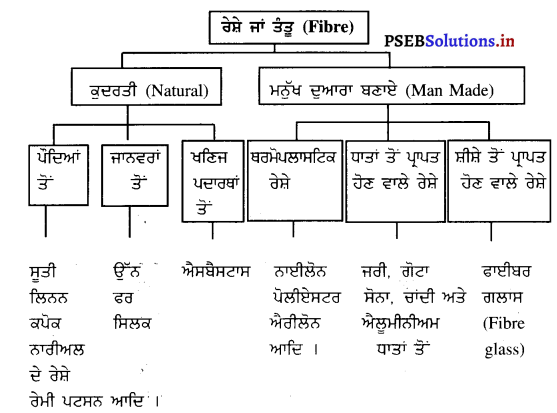
ਪ੍ਰਸ਼ਨ 14.
ਰੇਸ਼ਮ ਨੂੰ ਕਿਨ੍ਹਾਂ ਗੁਣਾਂ ਕਾਰਨ ਕੱਪੜਿਆਂ ਦੀ ਰਾਣੀ ਮੰਨਿਆ ਜਾਂਦਾ ਹੈ ?
ਜਾਂ
ਸਿਲਕ ਨੂੰ ਕੱਪੜਿਆਂ ਦੀ ਰਾਣੀ ਕਿਉਂ ਕਿਹਾ ਜਾਂਦਾ ਹੈ ?
ਉੱਤਰ-
ਰੇਸ਼ਮ ਕੁਦਰਤੀ ਰੇਸ਼ਿਆਂ ਵਿਚ ਸਭ ਤੋਂ ਲੰਮਾ ਰੇਸ਼ਾ ਹੈ । ਇਹ ਰੇਸ਼ਾ ਮਜ਼ਬੂਤ ਅਤੇ ਲਚਕਦਾਰ ਹੁੰਦਾ ਹੈ । ਪਰ ਗਿੱਲਾ ਹੋ ਕੇ ਕਮਜ਼ੋਰ ਹੋ ਜਾਂਦਾ ਹੈ । ਇਸ ਰੇਸ਼ੇ ਵਿਚ ਚਮਕ ਸਭ ਤੋਂ ਵੱਧ ਹੁੰਦੀ ਹੈ ਜਿਸ ਨਾਲ ਵੇਖਣ ਨੂੰ ਸੋਹਣਾ ਲੱਗਦਾ ਹੈ । ਇਸੇ ਲਈ ਇਸ ਨੂੰ ਕੱਪੜਿਆਂ ਦੀ ਰਾਣੀ ਕਿਹਾ ਜਾਂਦਾ ਹੈ ।
ਪ੍ਰਸ਼ਨ 15.
ਸਿਲਕ ਦੀਆਂ ਵਿਸ਼ੇਸ਼ਤਾਈਆਂ ਦੱਸੋ ।
ਉੱਤਰ-
ਸਿਲਕ ਦੀਆਂ ਵਿਸ਼ੇਸ਼ਤਾਈਆਂ ਹੇਠ ਲਿਖੀਆਂ ਹਨ
- ਬਣਤਰ-ਖੁਰਦਬੀਨ ਹੇਠਾਂ ਇਸ ਦੇ ਰੇਸ਼ੇ ਚਮਕਦਾਰ ਅਤੇ ਦੂਹਰੇ ਧਾਗੇ ਦੇ ਬਣੇ ਦਿਖਾਈ ਦਿੰਦੇ ਹਨ ਜਿਸ ਉੱਪਰ ਥਾਂ-ਥਾਂ ਗੰਦ ਦੇ ਧੱਬੇ ਲੱਗੇ ਹੁੰਦੇ ਹਨ ।
- ਲੰਬਾਈ-ਇਹ ਕੁਦਰਤੀ ਰੇਸ਼ਿਆਂ ਵਿਚੋਂ ਸਭ ਤੋਂ ਲੰਮਾ ਰੇਸ਼ਾ ਹੈ । ਇਸ ਰੇਸ਼ੇ ਦੀ ਲੰਬਾਈ ਲਗਪਗ 750 ਤੋਂ 1100 ਮੀਟਰ ਤਕ ਹੁੰਦੀ ਹੈ ।
- ਦਿਖ-ਇਸ ਰੇਸ਼ੇ ਦੀ ਸਭ ਤੋਂ ਵੱਧ ਚਮਕ ਹੁੰਦੀ ਹੈ ।
- ਮਜ਼ਬੂਤੀ-ਕੁਦਰਤੀ ਰੂਪ ਵਿਚ ਮਿਲਣ ਵਾਲੇ ਸਭ ਰੇਸ਼ਿਆਂ ਤੋਂ ਇਹ ਮਜ਼ਬੂਤ ਹੁੰਦਾ ਹੈ ਪਰ ਗਿੱਲਾ ਹੋ ਕੇ ਕਮਜ਼ੋਰ ਹੋ ਜਾਂਦਾ ਹੈ ।
- ਰੰਗ-ਇਸ ਦਾ ਰੰਗ ਸਫ਼ੈਦ ਪੀਲਾ ਜਾਂ ਸਲੇਟੀ ਹੁੰਦਾ ਹੈ ।
- ਲਚਕੀਲਾਪਨ-ਇਹ ਰੇਸ਼ਾ ਲਚਕਦਾਰ ਹੁੰਦਾ ਹੈ, ਇਸ ਲਈ ਇਸ ਵਿਚ ਵਟ ਘੱਟ ਪੈਂਦੇ ਹਨ ।
- ਪਾਣੀ ਸੋਖਣ ਦੀ ਸਮਰੱਥਾ-ਇਹ ਰੇਸ਼ਾ ਆਸਾਨੀ ਨਾਲ ਪਾਣੀ ਸੋਖ ਲੈਂਦਾ ਹੈ ਅਤੇ ਜਲਦੀ ਹੀ ਸੁੱਕ ਜਾਂਦਾ ਹੈ ।
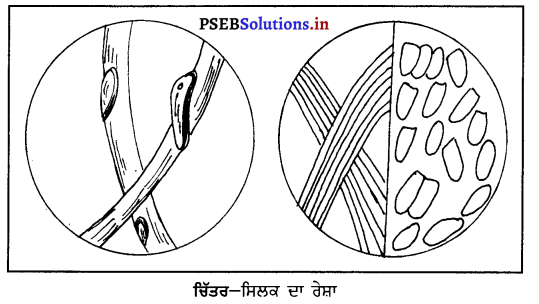
8. ਤਾਪ ਸੰਚਾਲਕਤਾ-ਇਸ ਵਿਚੋਂ ਤਾਪ ਨਿਕਲ ਨਹੀਂ ਸਕਦਾ ਇਸ ਕਰਕੇ ਇਹ ਤਾਪ ਦਾ ਸੰਚਾਲਕ ਨਹੀਂ ਹੈ । ਇਸੇ ਕਰਕੇ ਗਰਮੀਆਂ ਵਿਚ ਨਹੀਂ ਪਾਇਆ ਜਾਂਦਾ ।
9. ਅਮਲ ਦਾ ਅਸਰ-ਹਲਕੇ ਅਮਲ ਦਾ ਕੋਈ ਬੁਰਾ ਅਸਰ ਨਹੀਂ ਹੁੰਦਾ ।
10. ਖਾਰ ਦਾ ਅਸਰ-ਹਲਕੀ ਖਾਰ ਵੀ ਇਸ ਰੇਸ਼ੇ ਨੂੰ ਖ਼ਰਾਬ ਕਰ ਦਿੰਦੀ ਹੈ, ਇਸ ਲਈ ਕਲੋਰੀਨ ਯੁਕਤ ਰੰਗਕਾਟ ਨਹੀਂ ਵਰਤਣੇ ਚਾਹੀਦੇ ।
11. ਰੰਗਾਈ-ਇਸ ਰੇਸ਼ੇ ‘ਤੇ ਰੰਗ ਜਲਦੀ ਤੇ ਪੱਕਾ ਚੜ੍ਹਦਾ ਹੈ, ਇਸ ਲਈ ਹਰ ਤਰ੍ਹਾਂ ਦੇ ਰੰਗ ਨਾਲ ਰੰਗਿਆ ਜਾ ਸਕਦਾ ਹੈ ।
12. ਤਾਪ ਨਾਲ-ਸਿਲਕ ਦੇ ਜਲਣ ਤੇ ਵਾਲ ਜਾਂ ਖੰਭ ਸੜਨ ਦੀ ਗੰਧ ਆਉਂਦੀ ਹੈ ।
ਅੱਗ ਤੋਂ ਬਾਹਰ ਕੱਢਣ ‘ਤੇ ਆਪਣੇ ਆਪ ਬੁੱਝ ਜਾਂਦੀ ਹੈ ਅਤੇ ਸੜਨ ਪਿੱਛੋਂ ਉਘੜ-ਦੁਗੜ ਕਾਲਾ ਮਣਕਾ ਜਿਹਾ ਬਣ ਜਾਂਦਾ ਹੈ । ਇਸ ਲਈ ਗਰਮ ਪਾਣੀ ਨਾਲ ਧੋਣ, ਧੁੱਪ ਵਿਚ ਸੁਕਾਉਣ ਅਤੇ ਗਰਮ ਸ ਨਾਲ ਪਿੱਸ ਕਰਨ ਨਾਲ ਖ਼ਰਾਬ ਹੋ ਜਾਂਦਾ ਹੈ ।
ਪ੍ਰਸ਼ਨ 16.
ਸਿਲਕ ਅਤੇ ਉੱਨ ਦੋਨੋਂ ਹੀ ਤਾਪ ਦੇ ਕੁਚਾਲਕ ਹਨ ਪਰ ਫਿਰ ਉੱਨ ਜ਼ਿਆਦਾ ਨਿੱਘੀ ਕਿਉਂ ਹੈ ?
ਉੱਤਰ-
ਉੱਨ ਅਤੇ ਸਿਲਕ ਦੋਵੇਂ ਹੀ ਕੁਦਰਤੀ ਅਤੇ ਜਾਨਵਰਾਂ ਤੋਂ ਪ੍ਰਾਪਤ ਰੇਸ਼ੇ ਹਨ । ਇਸ ਤੋਂ ਇਲਾਵਾ ਦੋਵੇਂ ਹੀ ਤਾਪ ਦੇ ਕੁਚਾਲਕ ਹਨ ਅਤੇ ਦੋਹਾਂ ਦੀ ਵਰਤੋਂ ਸਰਦੀਆਂ ਵਿਚ ਕੀਤੀ ਜਾਂਦੀ ਹੈ ਪਰ ਫਿਰ ਵੀ ਸਿਲਕ ਨਾਲੋਂ ਉੱਨ ਜ਼ਿਆਦਾ ਨਿੱਘੀ ਹੈ ਕਿਉਂਕਿ ਸਿਲਕ ਦਾ ਕੱਪੜਾ ਪਤਲਾ ਅਤੇ ਉੱਪਰਲੀ ਸਤੂ ਮੁਲਾਇਮ ਹੋਣ ਕਰਕੇ ਬਾਹਰ ਵਾਲੀ ਠੰਢ ਨਾਲ ਠਰ ਜਾਂਦਾ ਹੈ । ਪਰ ਉੱਨ ਦਾ ਕੱਪੜਾ ਮੋਟਾ ਅਤੇ ਖੁਰਦਰਾ ਹੋਣ ਕਰਕੇ ਠਰਦਾ ਨਹੀਂ ਅਤੇ ਸਰੀਰ ਦੀ ਗਰਮੀ ਬਾਹਰ ਨਹੀਂ ਆਉਣ ਦਿੰਦਾ । ਇਸ ਕਰਕੇ ਉੱਨ ਸਿਲਕ ਨਾਲੋਂ ਵਧੇਰੇ ਨਿੱਘੀ ਹੁੰਦੀ ਹੈ ।

ਪ੍ਰਸ਼ਨ 17.
ਉੱਨ ਵਿਚ ਅਜਿਹਾ ਕਿਹੜਾ ਤੱਤ ਹੁੰਦਾ ਹੈ ਜੋ ਦੂਸਰੇ ਰੇਸ਼ਿਆਂ ਵਿਚ ਨਹੀਂ ਹੁੰਦਾ ਅਤੇ ਰਚਨਾ ਬਾਰੇ ਦੱਸੋ ।
ਉੱਤਰ-
ਉੱਨ ਵਿਚ ਇਕ ਖ਼ਾਸ ਵਿਸ਼ੇਸ਼ਤਾ ਹੈ ਜੋ ਬਾਕੀ ਰੇਸ਼ਿਆਂ ਵਿਚ ਨਹੀਂ ਹੁੰਦੀ । ਉੱਨ ਦੇ ਰੇਸ਼ੇ ਵਿਚ ਲਹਿਰੀਆ ਹੁੰਦਾ ਹੈ ਜਿਸ ਨੂੰ ਕਰੰਪ (crimp) ਕਿਹਾ ਜਾਂਦਾ ਹੈ |ਲਹਿਰੀਏ ਦੀ ਗਿਣਤੀ ਰੇਸ਼ੇ ਦੀ ਮਜ਼ਬੂਤੀ ਅਤੇ ਆਕਾਰ ‘ਤੇ ਨਿਰਭਰ ਕਰਦੀ ਹੈ । ਰੇਸ਼ਾ ਜਿੰਨਾ ਬਾਰੀਕ ਹੋਵੇ ਉੱਨਾ ਹੀ ਮਜ਼ਬੂਤ ਹੁੰਦਾ ਹੈ । ਇਸ ਵਿਸ਼ੇਸ਼ਤਾ ਕਰਕੇ ਰੇਸ਼ੇ ਇਕ-ਦੂਜੇ ਨਾਲ ਜੁੜ ਜਾਂਦੇ ਹਨ ਜਿਸ ਨੂੰ ਫੈਲਟਿੰਗ (Felting) ਕਿਹਾ ਜਾਂਦਾ ਹੈ । ਇਸ ਵਿਸ਼ੇਸ਼ਤਾ ਕਰਕੇ ਇਸ ਤੋਂ ਨਮਦਾ, ਕੰਬਲ, ਗਲੀਚੇ ਆਦਿ ਬਣਦੇ ਹਨ । ਰਚਨਾ-ਉੱਨ ਦਾ ਮੁੱਖ ਤੱਤ ਕਿਰੋਟਿਨ ਨਾਮ ਦਾ ਪ੍ਰੋਟੀਨ ਹੈ ਜਿਸ ਵਿਚ ਕਾਰਬਨ, ਹਾਈਡਰੋਜਨ, ਆਕਸੀਜਨ ਅਤੇ ਨਾਈਟਰੋਜਨ ਤੋਂ ਇਲਾਵਾ ਸਲਫਰ ਵੀ ਹੁੰਦੀ ਹੈ ।
ਪ੍ਰਸ਼ਨ 18.
ਸਿਲਕ ਅਤੇ ਉੱਨ ਦੇ ਗੁਣਾਂ ਵਿਚ ਸਮਾਨਤਾ ਕਿਉਂ ਹੈ ?
ਉੱਤਰ-
ਸਿਲਕ ਅਤੇ ਉੱਨ ਦੋਵੇਂ ਰੇਸ਼ੇ ਕੁਦਰਤੀ ਅਤੇ ਜਾਨਵਰਾਂ ਤੋਂ ਪ੍ਰਾਪਤ ਹੁੰਦੇ ਹਨ । ਦੋਵੇਂ ਰੇਸ਼ੇ ਪ੍ਰੋਟੀਨ ਯੁਕਤ ਹਨ ਅਤੇ ਇਨ੍ਹਾਂ ਵਿਚ ਕਾਰਬਨ, ਹਾਈਡਰੋਜਨ, ਆਕਸੀਜਨ ਅਤੇ ਨਾਈਟਰੋਜਨ ਹੁੰਦੇ ਹਨ । ਇਸ ਲਈ ਇਹਨਾਂ ਵਿਚ ਕਈ ਸਮਾਨਤਾਵਾਂ ਹਨ ਜਿਵੇਂ ਕਿ ਇਨ੍ਹਾਂ ਦੀ ਵਰਤੋਂ ਸਰਦੀਆਂ ਵਿਚ ਹੀ ਕੀਤੀ ਜਾਂਦੀ ਹੈ । ਦੋਵੇਂ ਹੀ ਤਾਪ ਦੇ ਕੁਚਾਲਕ ਹਨ । ਇਹਨਾਂ ਰੇਸ਼ਿਆਂ ਨੂੰ ਕੀੜਾ ਜਲਦੀ ਲਗ ਜਾਂਦਾ ਹੈ । ਦੋਹਾਂ ਦੀ ਬਹੁਤ ਸੰਭਾਲ ਕਰਨੀ ਪੈਂਦੀ ਹੈ । ਇਸ ਤੋਂ ਇਲਾਵਾ ਇਹਨਾਂ ਉੱਪਰ ਤਾਪ ਦਾ ਮਾੜਾ ਅਸਰ ਹੁੰਦਾ ਹੈ ।
ਪ੍ਰਸ਼ਨ 19.
ਸੁਤੀ ਅਤੇ ਲਿਨਨ ਦੇ ਰੇਸ਼ਿਆਂ ਦੇ ਗੁਣਾਂ ਵਿਚ ਸਮਾਨਤਾ ਕਿਉਂ ਹੈ ?
ਜਾਂ
ਸੂਤੀ ਅਤੇ ਲਿਨਨ ਦੇ ਰੇਸ਼ਿਆਂ ਦੇ ਗੁਣਾਂ ਵਿੱਚ ਕੀ ਸਮਾਨਤਾ ਹੈ ?
ਜਾਂ
ਲਿਨਨ ਤੇ ਸੂਤੀ ਕੱਪੜੇ ਵਿਚ ਕੀ ਸਮਾਨਤਾ ਹੈ ?
ਉੱਤਰ-
ਇਹ ਦੋਵੇਂ ਰੇਸ਼ੇ ਕੁਦਰਤੀ ਅਤੇ ਪੌਦਿਆਂ ਤੋਂ ਮਿਲਦੇ ਹਨ । ਸੂਤੀ ਰੇਸ਼ਾ ਕਪਾਹ ਦੇ ਰੂ ਤੋਂ ਬਣਦਾ ਹੈ ਅਤੇ ਲਿਨਨ ਦਾ ਰੇਸ਼ਾ ਫਲੈਕਸ ਪੌਦੇ ਦੇ ਤਣੇ ਅਤੇ ਟਾਹਣੀਆਂ ਤੋਂ ਪ੍ਰਾਪਤ ਹੁੰਦੇ ਹਨ । ਇਹਨਾਂ ਦੋਹਾਂ ਰੇਸ਼ਿਆਂ ਵਿਚ ਸੈਲੂਲੋਜ਼ ਵੱਧ ਹੁੰਦਾ ਹੈ । ਇਸ ਕਰਕੇ ਇਹਨਾਂ ਵਿਚ ਕਾਫ਼ੀ ਸਮਾਨਤਾ ਹੈ; ਜਿਵੇਂ ਦੋਵੇਂ ਰੇਸ਼ਿਆਂ ਦੀ ਲੰਬਾਈ ਛੋਟੀ ਹੁੰਦੀ ਹੈ । ਇਹ ਰੇਸ਼ੇ ਮਜ਼ਬੂਤ ਹੁੰਦੇ ਹਨ ਅਤੇ ਪਾਣੀ ਸੋਖਣ ਦੀ ਸਮਰੱਥਾ ਵੀ ਵੱਧ ਹੁੰਦੀ ਹੈ । ਇਹ ਦੋਵੇਂ ਰੇਸ਼ੇ ਹੀ ਤਾਪ ਦੇ ਸੰਚਾਲਕ ਹਨ ਜਿਸ ਕਰਕੇ ਗਰਮੀਆਂ ਵਿਚ ਪਹਿਨਣ ਲਈ ਆਰਾਮਦਾਇਕ ਹੁੰਦੇ ਹਨ ।
ਪ੍ਰਸ਼ਨ 20.
ਉੱਨੀ ਕੱਪੜਿਆਂ ਦੀ ਦੇਖ-ਭਾਲ ਕਿਵੇਂ ਕਰੋਗੇ ?
ਜਾਂ
ਉੱਨ ਦੀ ਦੇਖਭਾਲ ਬਾਰੇ ਵਿਸਤਾਰ ਨਾਲ ਦੱਸੋ ।
ਉੱਤਰ-
ਊਨੀ ਰੇਸ਼ੇ ਕਮਜ਼ੋਰ ਹੁੰਦੇ ਹਨ ਅਤੇ ਗਿੱਲੇ ਹੋ ਕੇ ਹੋਰ ਵੀ ਕਮਜ਼ੋਰ ਹੋ ਜਾਂਦੇ ਹਨ । ਇਸ ਲਈ ਬਹੁਤ ਧਿਆਨ ਨਾਲ ਧੋਣਾ ਚਾਹੀਦਾ ਹੈ । ਗਿੱਲਾ ਹੋਣ ਨਾਲ ਕੱਪੜਾ ਭਾਰਾ ਹੋ ਜਾਂਦਾ ਹੈ ਅਤੇ ਇਹਨਾਂ ਨੂੰ ਲਟਕਾ ਕੇ ਨਹੀਂ ਸੁਕਾਉਣਾ ਚਾਹੀਦਾ ਕਿਉਂਕਿ , ਭਾਰੇ ਹੋਣ ਕਰਕੇ ਇਹਨਾਂ ਦਾ ਅਕਾਰ ਵਿਗੜ ਜਾਂਦਾ ਹੈ । ਉੱਨ ਦੇ ਕੱਪੜਿਆਂ ਨੂੰ ਜ਼ਿਆਦਾ ਦੇਰ ਤਕ ਭਿਉਂ ਕੇ ਨਹੀਂ ਰੱਖਣਾ ਚਾਹੀਦਾ ਅਤੇ ਨਾ ਹੀ ਰਗੜ ਕੇ ਧੋਣਾ ਚਾਹੀਦਾ ਹੈ । ਇਸ ਲਈ ਪਾਣੀ ਦੇ ਤਾਪਮਾਨ ਦਾ ਵੀ ਧਿਆਨ ਰੱਖਣਾ ਜ਼ਰੂਰੀ ਹੈ ਕਿ ਪਾਣੀ ਨਾ ਜ਼ਿਆਦਾ ਗਰਮ ਅਤੇ ਨਾ ਹੀ ਠੰਢਾ ਹੋਣਾ ਚਾਹੀਦਾ ਹੈ |
ਉਨੀ ਕੱਪੜੇ ਨੂੰ ਸੁਕਾਉਣ ਲਈ ਅਖ਼ਬਾਰ ਜਾਂ ਕਾਗਜ਼ ਤੇ ਧੋਣ ਤੋਂ ਪਹਿਲੋਂ ਕੱਪੜੇ ਦੇ ਆਕਾਰ ਦਾ ਖਾਕਾ ਬਣਾ ਕੇ ਪੱਧਰੀ ਥਾਂ ਤੇ ਰੱਖ ਕੇ ਸੁਕਾਉਣਾ ਚਾਹੀਦਾ ਹੈ| ਜੇ ਹੋ ਸਕੇ ਤਾਂ ਡਰਾਈਕਲੀਨ ਕਰਵਾ ਲੈਣਾ ਚਾਹੀਦਾ ਹੈ : ਉਨੀ ਕੱਪੜੇ ਨੂੰ ਪ੍ਰੈੱਸ ਵੀ ਬਹੁਤ ਧਿਆਨ ਨਾਲ ਕਰਨਾ ਚਾਹੀਦਾ ਹੈ । ਕੱਪੜੇ ਤੇ ਸਿੱਧੀ ਪ੍ਰੈੱਸ ਨਹੀਂ ਕਰਨੀ ਚਾਹੀਦੀ । ਸਿੱਲਾ ਜਿਹਾ ਸੂਤੀ ਕੱਪੜਾ ਵਿਛਾ ਕੇ ਹਲਕੀ ਗਰਮ ਸ ਕਰਨੀ ਚਾਹੀਦੀ ਹੈ । ਇਹਨਾਂ ਕੱਪੜਿਆਂ ਨੂੰ ਚੰਗੀ ਤਰ੍ਹਾਂ ਸੁਕਾ ਕੇ ਸੁੱਕੀ ਥਾਂ ‘ਤੇ ਸੰਭਾਲ ਕੇ ਰੱਖਣਾ ਚਾਹੀਦਾ ਹੈ ਕਿਉਂਕਿ ਉੱਨੀ ਰੇਸ਼ੇ ਨੂੰ ਕੀੜਾ ਜਲਦੀ ਲਗ ਜਾਂਦਾ ਹੈ ।
ਪ੍ਰਸ਼ਨ 21.
ਐਸਬੈਸਟਾਸ ਕਿਹੋ ਜਿਹਾ ਰੇਸ਼ਾ ਹੈ ?
ਉੱਤਰ-
ਇਹ ਕੁਦਰਤੀ ਰੂਪ ਵਿਚ ਮਿਲਣ ਵਾਲਾ ਰੇਸ਼ਾ ਹੈ । ਇਹ ਕੱਚੀ ਧਾਤ ਜਾਂ ਖਣਿਜ ਪਦਾਰਥ ਤੋਂ ਪ੍ਰਾਪਤ ਹੁੰਦਾ ਹੈ । ਇਹ ਅੱਗ ਵਿਚ ਰੱਖਣ ‘ਤੇ ਸਦਾ ਨਹੀਂ । ਇਸ ਉੱਪਰ ਤੇਜ਼ਾਬ ਅਤੇ ਖਾਰ ਦਾ ਕੋਈ ਅਸਰ ਨਹੀਂ ਹੁੰਦਾ । ਅੱਗ ਬੁਝਾਉਣ ਲਈ ਵਰਤੇ ਜਾਣ ਵਾਲੇ ਕੱਪੜੇ ਵੀ ਇਸ ਰੇਸ਼ੇ ਤੋਂ ਬਣਾਏ ਜਾਂਦੇ ਹਨ । ਆਮ ਪਹਿਨਣ ਵਾਲੇ ਕੱਪੜੇ ਇਸ ਤੋਂ ਨਹੀਂ ਬਣਾਏ ਜਾਂਦੇ ।
ਪ੍ਰਸ਼ਨ 22.
ਅਜਿਹੀ ਰੇਔਨ ਦਾ ਨਾਂ ਦੱਸੋ ਜੋ ਥਰਮੋਪਲਾਸਟਿਕ ਵੀ ਹੈ ?
ਉੱਤਰ-
ਐਸੀਟੇਟ ਰੇਔਨ ਦੇ ਰੇਸ਼ੇ ਥਰਮੋਪਲਾਸਟਿਕ ਰੇਸ਼ਿਆਂ ਨਾਲ ਮੇਲ ਖਾਂਦੇ ਹਨ । ਇਹ ਰੇਸ਼ੇ ਵੇਖਣ ਨੂੰ ਨਰਮ ਅਤੇ ਚਮਕਦਾਰ ਹੁੰਦੇ ਹਨ ਅਤੇ ਆਮ ਤੌਰ ‘ਤੇ ਘਰੇਲੂ ਪੁਸ਼ਾਕਾਂ ਅਤੇ ਵਸਤਰ ਬਣਾਉਣ ਦੇ ਕੰਮ ਆਉਂਦਾ ਹੈ ।
ਪ੍ਰਸ਼ਨ 23.
ਬਨਾਉਟੀ ਤਰੀਕੇ ਨਾਲ ਰੇਸ਼ਾ ਕਿਵੇਂ ਬਣਾਇਆ ਜਾਂਦਾ ਹੈ ?
ਉੱਤਰ-
ਬਨਾਉਟੀ ਤਰੀਕੇ ਨਾਲ ਰੇਸ਼ਾ ਤਿਆਰ ਕਰਨ ਲਈ ਰਸਾਇਣਿਕ ਪਦਾਰਥਾਂ ਨੂੰ ਨਿਯੰਤਰਿਤ ਹਾਲਤਾਂ ਵਿਚ ਕਿਰਿਆ ਕਰਕੇ ਰੇਸ਼ੇ ਬਣਾਏ ਜਾਂਦੇ ਹਨ । ਫਿਰ ਬਾਰੀਕ ਛੇਕਾਂ ਵਾਲੀ ਛਾਣਨੀ ਵਿਚੋਂ ਕੱਢਿਆ ਜਾਂਦਾ ਹੈ । ਇਹ ਭਾਗ ਹਵਾ ਦੇ ਸੰਪਰਕ ਵਿਚ ਆ ਕੇ ਰੇਸ਼ਿਆਂ ਦਾ ਰੂਪ ਧਾਰ ਲੈਂਦੇ ਹਨ ।
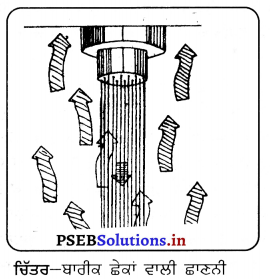
ਪ੍ਰਸ਼ਨ 24.
ਥਰਮੋਪਲਾਸਟਿਕ ਰੇਸ਼ਿਆਂ ਦੇ ਮੁੱਖ ਗੁਣ ਦੱਸੋ ।
ਉੱਤਰ-
ਥਰਮੋਪਲਾਸਟਿਕ ਰੇਸ਼ਾ ਕਾਰਬਨ, ਹਾਈਡਰੋਜਨ, ਆਕਸੀਜਨ ਅਤੇ ਨਾਈਟਰੋਜਨ ਤੱਤਾਂ ਤੋਂ ਮਿਲ ਕੇ ਬਣਦਾ ਹੈ ।
ਇਸ ਰੇਸ਼ੇ ਦੀਆਂ ਵਿਸ਼ੇਸ਼ਤਾਵਾਂ ਹੇਠ ਲਿਖੀਆਂ ਹਨ –
- ਇਹ ਫਿਲਾਮੈਂਟ ਰੇਸ਼ੇ ਹੁੰਦੇ ਹਨ । ਇਨ੍ਹਾਂ ਦੀ ਲੰਬਾਈ ਇੱਛਾ ਅਨੁਸਾਰ ਰੱਖੀ ਜਾ ਸਕਦੀ ਹੈ ।
- ਇਹ ਰੇਸ਼ੇ ਮਜ਼ਬੂਤ ਅਤੇ ਚਮਕਦਾਰ ਹੁੰਦੇ ਹਨ ਅਤੇ ਇਸ ਦੇ ਕੱਪੜੇ ਹੰਢਣਸਾਰ ਹੁੰਦੇ ਹਨ ।
- ਇਹਨਾਂ ਰੇਸ਼ਿਆਂ ਦੀ ਪਾਣੀ ਸੋਖਣ ਦੀ ਸਮਰੱਥਾ ਬਹੁਤ ਘੱਟ ਹੁੰਦੀ ਹੈ । ਇਸ ਲਈ ਇਹ ਜਲਦੀ ਸੁੱਕ ਜਾਂਦੇ ਹਨ । ਇਸ ਕਰਕੇ ਇਹ ਕੱਪੜੇ ਪਸੀਨਾ ਵੀ ਨਹੀਂ ਸੋਖਦੇ ।
- ਇਹ ਰੇਸ਼ੇ ਤਾਪ ਦੇ ਕੁਚਾਲਕ ਹੁੰਦੇ ਹਨ, ਇਸ ਕਰਕੇ ਗਰਮੀਆਂ ਵਿਚ ਨਹੀਂ ਵਰਤੇ ਜਾਂਦੇ ।
- ਥਰਮੋਪਲਾਸਟਿਕ ਰੇਸ਼ਿਆਂ ‘ਤੇ ਖਾਰ ਦਾ ਕੋਈ ਅਸਰ ਨਹੀਂ ਹੁੰਦਾ, ਜਦ ਕਿ ਤੇਜ਼ਾਬ ਵਿਚ ਇਹ ਰੇਸ਼ੇ ਘੁਲ ਜਾਂਦੇ ਹਨ ।
- ਥਰਮੋਪਲਾਸਟਿਕ ਰੇਸ਼ੇ ਤਾਪ ਨਾਲ ਪਿਘਲ ਜਾਂਦੇ ਹਨ ਅਤੇ ਜਲਣ ’ਤੇ ਪਲਾਸਟਿਕ ਦੇ ਸੜਨ ਵਰਗੀ ਗੰਧ ਆਉਂਦੀ ਹੈ । ਇਹ ਜ਼ਿਆਦਾ ਗਰਮੀ ਨਹੀਂ ਸਹਾਰ ਸਕਦੇ, ਇਸ ਲਈ ਘੱਟ ਗਰਮ ਪ੍ਰੈੱਸ ਨਾਲ ਪ੍ਰੈੱਸ ਕਰਨੇ ਚਾਹੀਦੇ ਹਨ ।
- ਇਹਨਾਂ ਰੇਸ਼ਿਆਂ ਨੂੰ ਕੋਈ ਉੱਲੀ ਜਾਂ ਟਿੱਡੀ ਆਦਿ ਨਹੀਂ ਲਗਦੀ !
ਪ੍ਰਸ਼ਨ 25.
ਥਰਮੋਪਲਾਸਟਿਕ ਰੇਸ਼ਿਆਂ ਦੀ ਵਰਤੋਂ ਦਿਨ-ਪ੍ਰਤੀ-ਦਿਨ ਕਿਉਂ ਵੱਧ ਰਹੀ ਹੈ ?
ਉੱਤਰ-
ਥਰਮੋਪਲਾਸਟਿਕ ਰੇਸ਼ੇ ਮਜ਼ਬੂਤ, ਲਚਕਦਾਰ, ਹੰਢਣਸਾਰ, ‘ਧੋਣ ਅਤੇ ਸੰਭਾਲਣ ਵਿਚ ਆਸਾਨ ਹੁੰਦੇ ਹਨ । ਇਸ ਲਈ ਇਸ ਨੂੰ ਜੁਰਾਬਾਂ, ਖੇਡਾਂ ਲਈ ਪਹਿਨਣ ਵਾਲੇ ਕੱਪੜੇ ਅਤੇ ਆਮ ਪਹਿਨਣ ਵਾਲੇ ਕੱਪੜਿਆਂ ਲਈ ਵਰਤਿਆ ਜਾਂਦਾ ਹੈ । ਮਜ਼ਬੂਤੀ ਕਾਰਨ ਇਸ ਦੀਆਂ ਰੱਸੀਆਂ, ਡੋਰੀਆਂ ਆਦਿ ਵੀ ਬਣਾਈਆਂ ਜਾਂਦੀਆਂ ਹਨ । ਇਸ ਨੂੰ ਦੂਸਰੇ ਰੇਸ਼ਿਆਂ ਨਾਲ ਮਿਲਾ ਕੇ ਵੀ ਵਰਤਿਆ ਜਾਂਦਾ ਹੈ । ਇਸ ਰੇਸ਼ੇ ਦੀ ਮਜ਼ਬੂਤੀ ਕਾਰਨ ਹੀ ਇਸ ਦੀ ਵਰਤੋਂ ਦਿਨ-ਬ-ਦਿਨ ਵਧਦੀ ਜਾ ਰਹੀ ਹੈ ।

ਪ੍ਰਸ਼ਨ 26.
ਮਿਸ਼ਰਤ ਰੇਸ਼ੇ ਬਣਾਉਣ ਦੇ ਕੀ ਲਾਭ ਹਨ ?
ਉੱਤਰ-
ਮਿਸ਼ਰਤ ਰੇਸ਼ੇ ਬਣਾਉਣ ਨਾਲ ਉਨ੍ਹਾਂ ਦੀ ਮਜ਼ਬੂਤੀ ਅਤੇ ਹੰਢਣਸਾਰਤਾ ਵੱਧ ਜਾਂਦੀ ਹੈ । ਇਸਦੇ ਨਾਲ ਇਨ੍ਹਾਂ ਦੀ ਸਾਂਭ-ਸੰਭਾਲ ਵੀ ਸੌਖੀ ਹੋ ਜਾਂਦੀ ਹੈ । ਮਿਸ਼ਰਤ ਰੇਸ਼ੇ ਸਸਤੇ ਵੀ ਹੁੰਦੇ ਹਨ ਅਤੇ ਦਾਗ ਵੀ ਘੱਟ ਲੱਗਦੇ ਹਨ । ਇਹਨਾਂ ਦੇ ਰੰਗ ਵੀ ਪੱਕੇ ਹੁੰਦੇ ਹਨ ਅਤੇ ਵੇਖਣ ਨੂੰ ਵੀ ਸੋਹਣੇ ਲੱਗਦੇ ਹਨ ।
ਪ੍ਰਸ਼ਨ 27.
ਬਨਾਉਟੀ ਕੱਪੜਿਆਂ ਨੂੰ ਸੰਭਾਲਣਾ ਆਸਾਨ ਕਿਉਂ ਹੈ ?
ਉੱਤਰ-
ਬਨਾਉਟੀ ਕੱਪੜਿਆਂ ਦੀ ਦੇਖ-ਭਾਲ ਅਤੇ ਸੰਭਾਲ ਆਸਾਨ ਹੁੰਦੀ ਹੈ ਕਿਉਂਕਿ ਇਹ ਧੋਣੇ ਸੌਖੇ ਹੁੰਦੇ ਹਨ । ਗਰਮ ਪਾਣੀ ਦੀ ਲੋੜ ਨਹੀਂ ਪੈਂਦੀ । ਇਨ੍ਹਾਂ ਦੇ ਰੰਗ ਪੱਕੇ ਹੋਣ ਕਰਕੇ ਧੋਣ ਨਾਲ ਜਾਂ ਪੈਂਸ ਨਾਲ ਖ਼ਰਾਬ ਨਹੀਂ ਹੁੰਦੇ । ਪੈਂਸ ਦੀ ਵੀ ਜ਼ਿਆਦਾ ਲੋੜ ਨਹੀਂ ਪੈਂਦੀ ਟਿੱਡੀਆਂ, ਕੀੜਿਆਂ ਜਾਂ ਉੱਲੀ ਦੁਆਰਾ ਕੋਈ ਨੁਕਸਾਨ ਨਹੀਂ ਹੁੰਦਾ ਕਿਉਂਕਿ ਇਹ ਰਸਾਇਣਾਂ ਤੋਂ ਬਣੇ ਹੁੰਦੇ ਹਨ । ਇਸ ਲਈ ਸੰਭਾਲਣੇ ਵੀ ਸੌਖੇ ਹਨ ।
ਨਿਬੰਧਾਤਮਕ ਪ੍ਰਸ਼ਨ
ਪ੍ਰਸ਼ਨ 1.
ਰੇਸ਼ੇ ਤੋਂ ਕੱਪੜਾ ਬਣਾਉਣ ਲਈ ਕਿਹੜੇ ਮੂਲ ਗੁਣ ਹੋਣੇ ਚਾਹੀਦੇ ਹਨ ?
ਜਾਂ
ਰੇਸ਼ੇ ਤੋਂ ਕੱਪੜਾ ਬਣਾਉਣ ਲਈ ਮੂਲ ਗੁਣਾਂ ਦਾ ਵਰਣਨ ਕਰੋ ।
ਉੱਤਰ-
ਕੁਦਰਤ ਵਿਚ ਅਨੇਕਾਂ ਪ੍ਰਕਾਰ ਦੇ ਰੇਸ਼ੇ ਮਿਲਦੇ ਹਨ ਪਰ ਰੇਸ਼ਿਆਂ ਤੋਂ ਕੱਪੜਾ ਬਣਾਉਣ ਲਈ ਇਹਨਾਂ ਵਿਚ ਕੁੱਝ ਮੂਲ ਗੁਣ ਹੋਣੇ ਜ਼ਰੂਰੀ ਹਨ ਤਾਂ ਹੀ ਇਹਨਾਂ ਰੇਸ਼ਿਆਂ ਤੋਂ ਕੱਪੜਾ ਬਣਾਇਆ ਜਾ ਸਕਦਾ ਹੈ ।
ਇਹ ਮੁਲ ਗੁਣ ਹੇਠ ਲਿਖੇ ਹਨ –
- ਰੇਸ਼ੇ ਦੇ ਰੂਪ ਵਿਚ ਹੋਣਾ (Staple)
- ਮਜ਼ਬੂਤੀ (Strength/Tenacity)
- ਲਚਕੀਲਾਪਨ (Elasticity/Flexibility)
- ਇਕਸਾਰਤਾ (Uniformity)
- ਜੁੜਨ ਸ਼ਕਤੀ (Spinning Quality/Cohesiveness) ।
1. ਰੇਸ਼ੇ ਦੇ ਰੂਪ ਵਿਚ ਹੋਣਾ (ਸਟੇਪਲ) -ਰੇਸ਼ੇ ਸਟੇਪਲ ਜਾਂ ਫਿਲਾਮੈਂਟ ਦੋ ਤਰ੍ਹਾਂ ਦੇ ਹੋ ਸਕਦੇ ਹਨ । ਸਟੇਪਲ ਤੋਂ ਭਾਵ ਹੈ ਕਿ ਰੇਸ਼ੇ ਤੋਂ ਕੱਪੜਾ ਬਣਾਉਣ ਲਈ ਉਹਨਾਂ ਦੀ ਖ਼ਾਸ ਲੰਬਾਈ ਅਤੇ ਵਿਆਸ ਦਾ ਹੋਣਾ ਜ਼ਰੂਰੀ ਹੈ ਤਾਂ ਹੀ ਉਹਨਾਂ ਦੀ ਤਸੱਲੀਬਖਸ਼ ਵਰਤੋਂ ਹੋ ਸਕਦੀ ਹੈ । ਵਿਆਸ ਦੇ ਮੁਕਾਬਲਤਨ ਰੇਸ਼ਿਆਂ ਦੀ ਲੰਬਾਈ ਬਹੁਤ ਜ਼ਿਆਦਾ ਹੁੰਦੀ ਹੈ ਜੋ ਘੱਟੋ-ਘੱਟ 1 : 100 ਦੇ ਅਨੁਪਾਤ ਵਿਚ ਹੋਣੀ ਚਾਹੀਦੀ ਹੈ । ਜੇਕਰ ਰੇਸ਼ਿਆਂ ਦੀ ਲੰਬਾਈ ਅੱਧਾ ਇੰਚ ਤੋਂ ਘੱਟ ਹੋਵੇ ਤਾਂ ਉਹ ਧਾਗਾ ਬਣਾਉਣ ਲਈ ਇਸਤੇਮਾਲ ਨਹੀਂ ਕੀਤੇ ਜਾ ਸਕਦੇ ।
ਮਨੁੱਖ ਦੁਆਰਾ ਤਿਆਰ ਕੀਤੇ ਅਤੇ ਸਿਲਕ ਦੇ ਰੇਸ਼ਿਆਂ ਦੀ ਲੰਬਾਈ ਤਾਂ ਬਹੁਤ ਹੁੰਦੀ ਹੈ ਪਰੰਤ ਉੱਨ ਅਤੇ ਕਪਾਹ ਦੇ ਰੇਸ਼ਿਆਂ ਦੀ ਲੰਬਾਈ ਘੱਟ ਹੁੰਦੀ ਹੈ ਪਰ ਇਹਨਾਂ ਦੇ ਰੇਸ਼ਿਆਂ ਵਿਚ ਆਪਸ ਵਿਚ ਜੁੜ ਕੇ ਕੱਤੇ ਜਾਣ ਦਾ ਗੁਣ ਬਹੁਤ ਜ਼ਿਆਦਾ ਹੁੰਦਾ ਹੈ ਜੋ ਕੱਪੜਾ ਬਣਾਉਣ ਲਈ ਲਾਭਕਾਰੀ ਹੈ । ਕਪਾਹ ਦੇ ਛੋਟੇ ਰੇਸ਼ੇ ਜਿਹਨਾਂ ਤੋਂ ਧਾਗਾ ਨਹੀਂ ਬਣਾਇਆ ਜਾ ਸਕਦਾ, ਉਹਨਾਂ ’ਤੇ ਰਸਾਇਣਿਕ ਪਦਾਰਥਾਂ ਦੀ ਪ੍ਰਕਿਰਿਆ ਨਾਲ ਰੇਸ਼ੇ ਦਾ ਪੁਨਰ ਨਿਰਮਾਣ ਕਰਕੇ ਰੇਔਨ ਦਾ ਰੇਸ਼ਾ ਬਣਾਇਆ ਜਾਂਦਾ ਹੈ । ਇਸ ਲਈ ਹੀ ਰੇਔਨ ਦੇ ਗੁਣ ਸੂਤੀ ਕੱਪੜੇ ਨਾਲ ਕਾਫ਼ੀ ਮਿਲਦੇ ਹਨ ।
2. ਮਜ਼ਬੂਤੀ-ਰੇਸ਼ੇ ਤੋਂ ਕੱਪੜਾ ਬਣਾਉਣਾ ਇਕ ਲੰਬੀ ਪ੍ਰਕਿਰਿਆ ਹੈ । ਰੇਸ਼ੇ ਇੰਨੇ ਮਜ਼ਬੂਤ ਚਾਹੀਦੇ ਹਨ ਕਿ ਕਤਾਈ, ਸਫ਼ਾਈ ਅਤੇ ਬੁਣਾਈ ਸਮੇਂ ਪੈ ਰਹੀ ਖਿੱਚ ਦਾ ਮੁਕਾਬਲਾ ਕਰ ਸਕਣ ਅਤੇ ਹੰਢਣਸਾਰ ਕੱਪੜੇ ਦੇ ਰੂਪ ਵਿਚ ਬਦਲੇ ਜਾ ਸਕਣ । ਰੇਸ਼ਿਆਂ ਦੀ ਮਜ਼ਬੂਤੀ ਤੇ ਵਾਤਾਵਰਨ ਦੀ ਨਮੀ ਦਾ ਅਸਰ ਹੁੰਦਾ ਹੈ ।
ਆਮ ਤੌਰ ‘ਤੇ ਕੁਦਰਤੀ ਰੂਪ ਵਿਚ ਪੌਦਿਆਂ ਤੋਂ ਪ੍ਰਾਪਤ ਹੋਣ ਵਾਲੇ ਰੇਸ਼ੇ ਜਦੋਂ ਗਿੱਲੇ ਹੋਣ ਤਾਂ ਜ਼ਿਆਦਾ ਮਜ਼ਬੂਤ ਹੁੰਦੇ ਹਨ ਜਦ ਕਿ ਦੂਜੇ ਰੇਸ਼ੇ ਜਿਵੇਂ ਰੇਔਨ ਅਤੇ ਉੱਨ, ਸਿਲਕ ਆਦਿ ਗਿੱਲੇ ਹੋਣ ‘ਤੇ ਕਮਜ਼ੋਰ ਹੋ ਜਾਂਦੇ ਹਨ ।
3. ਲਚਕੀਲਾਪਨ -ਰੇਸ਼ਿਆਂ ਵਿਚ ਟੁੱਟੇ ਬਗੈਰ ਮੁੜ ਸਕਣ ਦਾ ਗੁਣ ਹੋਣਾ ਚਾਹੀਦਾ ਹੈ ਤਾਂ ਜੋ ਇਹਨਾਂ ਨੂੰ ਇੱਕ-ਦੂਜੇ ‘ਤੇ ਲਪੇਟ ਕੇ ਵਲ ਦੇ ਕੇ ਧਾਗਾ ਬਣਾਇਆ ਜਾ ਸਕੇ ਜਿਸ ਤੋਂ ਕਿ ਕੱਪੜਾ ਬਣਾਇਆ ਜਾਂਦਾ ਹੈ । ਇਹ ਗੁਣ ਕੱਪੜੇ ਨੂੰ ਹੰਢਣਸਾਰ ਬਣਾਉਣ ਅਤੇ ਮੁੜ ਪੁਰਾਣੀ ਸ਼ਕਲ ਅਤੇ ਆਕਾਰ ਬਰਕਰਾਰ ਰੱਖਣ ਵਿਚ ਮਦਦ ਕਰਦਾ ਹੈ । ਜਿਨ੍ਹਾਂ ਰੇਸ਼ਿਆਂ ਵਿਚ ਲਚਕ ਵੱਧ ਹੁੰਦੀ ਹੈ, ਉਹਨਾਂ ਵਿਚ ਵੱਟ ਘੱਟ ਪੈਂਦੇ ਹਨ ।
4. ਇਕਸਾਰਤਾ-ਰੇਸ਼ਿਆਂ ਦੀ ਲੰਬਾਈ ਅਤੇ ਵਿਆਸ ਵਿਚ ਇਕਸਾਰਤਾ ਹੋਣ ਨਾਲ ਉਹਨਾਂ ਤੋਂ ਸਾਫ ਅਤੇ ਇਕਸਾਰ ਧਾਗਾ ਬਣਾਇਆ ਜਾ ਸਕਦਾ ਹੈ ਜਿਸ ਨਾਲ ਕੱਪੜਾ ਵੀ ਮੁਲਾਇਮ ਅਤੇ ਸਾਫ਼ ਬਣਦਾ ਹੈ ।
5. ਜੁੜਨ ਸ਼ਕਤੀ -ਚੰਗੀ ਕਤਾਈ ਲਈ ਰੇਸ਼ਿਆਂ ਵਿੱਚ ਆਪਸ ਵਿਚ ਜੁੜ ਸਕਣ ਦੀ ਸ਼ਕਤੀ ਦਾ ਹੋਣਾ ਜ਼ਰੂਰੀ ਹੈ ਤਾਂ ਜੋ ਉਹਨਾਂ ਦੀ ਕਤਾਈ ਹੋ ਸਕੇ ।
ਰੇਸ਼ਿਆਂ ਦੀ ਜੁੜਨ ਸ਼ਕਤੀ ਚਾਰ ਗੱਲਾਂ ‘ਤੇ ਨਿਰਭਰ ਕਰਦੀ ਹੈ ।
- ਰੇਸ਼ੇ ਦੀ ਲੰਬਾਈ ।
- ਰੇਸ਼ੇ ਦੀ ਬਾਰੀਕੀ
- ਰੇਸ਼ੇ ਦੀ ਸੜਾ ਦੀ ਕਿਸਮ
- ਲਚਕੀਲਾਪਨ ।
ਰੇਸ਼ੇ ਵਿਚ ਜਿੰਨੀ ਜੁੜਨ ਸ਼ਕਤੀ ਵਧੇਰੇ ਹੋਵੇਗੀ ਉੱਨੀ ਹੀ ਕੜਾਈ ਉਪਰੰਤ ਧਾਗੇ ਦੀ ਬਾਰੀਕੀ ਅਤੇ ਮਜ਼ਬੂਤੀ ਹੋਵੇਗੀ ਅਤੇ ਇਹ ਹੀ ਗੁਣ ਕੱਪੜੇ ਵਿਚ ਵੀ ਆਉਣਗੇ ।
ਪ੍ਰਸ਼ਨ 2.
ਗਰਮੀਆਂ ਵਿਚ ਪਹਿਨਣ ਲਈ ਕਿਸ ਕਿਸਮ ਦੇ ਰੇਸ਼ਿਆਂ ਤੋਂ ਬਣੇ ਕੱਪੜੇ ਠੀਕ ਰਹਿੰਦੇ ਹਨ ? ਬਨਾਉਟੀ ਤਰੀਕੇ ਨਾਲ ਬਣਾਏ ਰੇਸ਼ਿਆਂ ਤੋਂ ਬਣੇ ਕੱਪੜੇ ਗਰਮੀਆਂ ਵਿਚ ਕਿਉਂ ਨਹੀਂ ਪਹਿਨੇ ਜਾਂਦੇ ?
ਉੱਤਰ-
ਗਰਮੀਆਂ ਵਿਚ ਪਹਿਨਣ ਲਈ ਸੂਤੀ ਅਤੇ ਲਿਨਨ ਰੇਸ਼ੇ ਦੇ ਕੱਪੜੇ ਠੀਕ ਰਹਿੰਦੇ ਹਨ ਕਿਉਂਕਿ ਇਨ੍ਹਾਂ ਵਿਚ ਪਾਣੀ ਸੋਖਣ ਦੀ ਸਮਰੱਥਾ ਵੱਧ ਹੁੰਦੀ ਹੈ ਜਿਸ ਨਾਲ ਇਹ ਪਸੀਨਾ ਸੋਖ ਲੈਂਦੇ ਹਨ ਅਤੇ ਤਾਪ ਦੇ ਸੰਚਾਲਕ ਹੋਣ ਕਰਕੇ ਪਸੀਨੇ ਨੂੰ ਸੁੱਕਣ ਵਿਚ ਮਦਦ ਕਰਦੇ ਹਨ ਅਤੇ ਠੰਢੇ ਰਹਿੰਦੇ ਹਨ । ਇਸੇ ਲਈ ਇਹ ਕੱਪੜੇ ਗਰਮੀਆਂ ਵਿਚ ਵੱਧ ਆਰਾਮਦਾਇਕ ਹੁੰਦੇ ਹਨ । ਇਹ ਰੇਸ਼ੇ ਮਜ਼ਬੂਤ ਹੁੰਦੇ ਹਨ ਪਰ ਗਿੱਲੇ ਹੋਣ ‘ਤੇ ਹੋਰ ਵੀ ਮਜ਼ਬੂਤੀ ਵੱਧ ਜਾਂਦੀ ਹੈ । ਸੂਤੀ ਅਤੇ ਲਿਨਨ ਦੇ ਕੱਪੜਿਆਂ ਦੇ ਉਲਟ ਬਨਾਉਟੀ ਰੇਸ਼ੇ ਗਰਮੀਆਂ ਵਿਚ ਨਹੀਂ ਪਹਿਨੇ ਜਾਂਦੇ ਕਿਉਂਕਿ ਇਹ ਪਾਣੀ ਨਹੀਂ ਸੋਖਦੇ ਅਤੇ ਪਸੀਨਾ ਆਉਣ ‘ਤੇ ਗਿੱਲੇ ਹੋ ਜਾਂਦੇ ਹਨ ਪਰ ਪਸੀਨਾ ਸੁੱਕਦਾ ਨਹੀਂ । ਤਾਪ ਦੇ ਕੁਚਾਲਕ ਹੋਣ ਕਰਕੇ ਸਰੀਰ ਦੀ ਗਰਮੀ ਬਾਹਰ ਨਹੀਂ ਨਿਕਲ ਸਕਦੀ ਸੋ ਇਨ੍ਹਾਂ ਵਿਚ ਵੱਧ ਗਰਮੀ ਲੱਗਦੀ ਹੈ । ਇਸ ਲਈ ਇਹ ਕੱਪੜੇ ਗਰਮੀਆਂ ਵਿਚ ਨਹੀਂ ਪਹਿਨੇ ਜਾਂਦੇ ।

ਪ੍ਰਸ਼ਨ 3.
ਕੁਦਰਤ ਵਿਚ ਮਿਲਣ ਵਾਲੇ ਰੇਸ਼ੇ ਕਿਹੜੇ-ਕਿਹੜੇ ਹਨ ? ਕਿਸੇ ਇਕ ਰੇਸ਼ੇ ਦੀਆਂ ਵਿਸ਼ੇਸ਼ਤਾਈਆਂ, ਰਚਨਾ ਅਤੇ ਦੇਖਭਾਲ ਬਾਰੇ ਲਿਖੋ ।
ਜਾਂ
ਸੁਤੀ ਰੇਸ਼ੇ ਦੀਆਂ ਵਿਸ਼ੇਸ਼ਤਾਵਾਂ ਅਤੇ ਦੇਖਭਾਲ ਬਾਰੇ ਵਿਸਥਾਰ ਵਿਚ ਦੱਸੋ ।
ਉੱਤਰ-
ਕੁਦਰਤੀ ਰੂਪ ਵਿਚ ਪੌਦਿਆਂ, ਜਾਨਵਰਾਂ ਅਤੇ ਖਣਿਜ ਪਦਾਰਥਾਂ ਜਾਂ ਕੱਚੀ ਧਾਤ ਤੋਂ ਪ੍ਰਾਪਤ ਹੋਣ ਵਾਲੇ ਰੇਸ਼ੇ ਕੁਦਰਤੀ ਰੇਸ਼ੇ ਹਨ ।
ਇਨ੍ਹਾਂ ਨੂੰ ਪ੍ਰਾਪਤੀ ਦੇ ਸਾਧਨ ਦੇ ਅਧਾਰ ‘ਤੇ ਤਿੰਨ ਸ਼੍ਰੇਣੀਆਂ ਵਿਚ ਵੰਡਿਆ ਜਾਂਦਾ ਹੈ –
(ਉ) ਪੌਦਿਆਂ ਤੋਂ ਪ੍ਰਾਪਤ ਹੋਣ ਵਾਲੇ ਰੇਸ਼ੇ-ਇਹ ਪੌਦਿਆਂ ਦੇ ਬੀਜਾਂ ਦੇ ਵਾਲਾਂ ਦੇ ਰੂਪ ਵਿਚ ਕਪਾਹ ਅਤੇ ਤਣਿਆਂ ਦੇ ਰੇਸ਼ਿਆਂ ਦੇ ਰੂਪ ਵਿਚ ਸਣ, ਪਟਸਨ ਆਦਿ ਹਨ ।
(ਅ) ਜਾਨਵਰਾਂ ਤੋਂ ਪ੍ਰਾਪਤ ਹੋਣ ਵਾਲੇ ਰੇਸ਼ੇ-ਜਾਨਵਰਾਂ ਦੇ ਵਾਲਾਂ ਦੇ ਰੂਪ ਵਿਚ ਉੱਨ ਅਤੇ ਰੇਸ਼ਮ ਦੇ ਕੀੜਿਆਂ ਤੋਂ ਰੇਸ਼ਮ ਪ੍ਰਾਪਤ ਹੁੰਦਾ ਹੈ । ਧਾਤ ਤੋਂ ਪ੍ਰਾਪਤ ਹੋਣ ਵਾਲੇ ਰੇਸ਼ੇ-ਕੱਚੀ ਧਾਤ ਜਾਂ ਖਣਿਜ ਪਦਾਰਥਾਂ ਦੇ ਰੂਪ ਵਿਚ ਐਸਬੈਸਟੀਸ ਕੁਦਰਤੀ ਰੂਪ ਵਿਚ ਧਰਤੀ ਦੀ ਤਹਿ ਤੋਂ ਪ੍ਰਾਪਤ ਹੋਣ ਵਾਲਾ ਰੇਸ਼ਾ ਹੈ ।
ਕੁਦਰਤੀ ਰੇਸ਼ੇ-ਇਹ ਰੇਸ਼ੇ ਵੱਖ-ਵੱਖ ਪੌਦਿਆਂ ਤੋਂ ਪ੍ਰਾਪਤ ਕੀਤੇ ਜਾਂਦੇ ਹਨ । ਪੌਦਿਆਂ ਤੋਂ ਮਿਲਣ ਵਾਲੇ ਇਹ ਰੇਸ਼ੇ, ਜਿਵੇਂ-ਕਪਾਹ ਸੂ), ਲਿਨਨ, ਜੂਟ ਅਤੇ ਨਾਰੀਅਲ ਦੇ ਰੇਸ਼ੇ ਆਦਮੀ ਲਈ ਬਹੁਤ ਲਾਭਕਾਰੀ ਹਨ । ਇਹ ਪੌਦਿਆਂ ਦੇ ਵੱਖ-ਵੱਖ ਹਿੱਸਿਆਂ; ਜਿਵੇਂ-ਬੀਜ, ਤਣੇ, ਪੱਤੇ ਜਾਂ ਫਲ ਤੋਂ ਪ੍ਰਾਪਤ ਹੁੰਦੇ ਹਨ । ਸੂਤੀ ਰੇਸ਼ੇ-ਇਹ ਰੇਸ਼ਾ ਪੁਰਾਣੇ ਸਮੇਂ ਤੋਂ ਭਾਰਤ ਵਿਚ ਉਗਾਇਆ ਜਾਂਦਾ ਹੈ । ਸੂਤੀ ਰੇਸ਼ਾ ਕਪਾਹ ਦੇ ਪੌਦੇ ਦੇ ਬੀਜਾਂ ਦੇ ਵਾਲ ਹਨ । ਕਪਾਹ ਦਾ ਬੂਟਾ 90-120 ਸੈਂਟੀਮੀਟਰ ਉੱਚਾ ਹੁੰਦਾ ਹੈ ਜੋ ਗਰਮ, ਸਿੱਲ੍ਹੀ ਅਤੇ ਕਾਲੀ ਮਿੱਟੀ ਵਾਲੀ ਜ਼ਮੀਨ ਵਿਚ ਉਗਾਇਆ ਜਾਂਦਾ ਹੈ ।
ਇਸ ਦੀ ਡੋਡੀ ਜੋ ਫੁੱਲ ਵਿਚ ਬਦਲ ਜਾਂਦੀ ਹੈ ਜਿੱਥੇ ਬਾਅਦ ਵਿਚ ਟਿੰਡਾ ਬਣ ਜਾਂਦਾ ਹੈ । ਡਾ ਪੱਕ ਕੇ ਫੁੱਟ ਜਾਂਦਾ ਹੈ । ਜਿਸ ਨਾਲ ਰੂੰ (ਕਪਾਹ ਬਾਹਰ ਨਿਕਲ ਆਉਂਦੀ ਹੈ । ਤੂੰ ਹੀ ਅਸਲ ਵਿਚ ਕਪਾਹ ਦੇ ਬੂਟੇ ਦੇ ਫਲ ਹਨ, ਜਿਸ ਤੋਂ ਵੜੇਵੇਂ (ਬੀਜ) ਅਤੇ ਕਪਾਹ ਬੀਜਾਂ ਦੇ ਵਾਲ ਵੱਖ-ਵੱਖ ਕਰ ਲਏ ਜਾਂਦੇਂ ਹਨ | ਕਪਾਹ ਦੀ ਕੰਘੀ ਕਰਕੇ ਛੋਟੇ ਅਤੇ ਲੰਬੇ ਰੇਸ਼ੇ ਵੱਖ-ਵੱਖ ਕਰ ਲਏ ਜਾਂਦੇ ਹਨ । ਲੰਬੇ ਰੇਸ਼ਿਆਂ ਤੋਂ ਮਸ਼ੀਨਾਂ ਨਾਲ ਧਾਗਾ ਬਣਾ ਕੇ ਕੱਪੜਾ ਬਣਾ ਲਿਆ ਜਾਂਦਾ । ਹੈ | ਪਹਿਲਾਂ ਘਰਾਂ ਵਿਚ ਹੀ ਚਰਖੇ ਨਾਲ ਧਾਗਾ ਬਣਾਇਆ ਜਾਂਦਾ ਸੀ ਜਿਸ ਤੋਂ ਖੱਦਰ ਜਾਂ ਖੇਸ ਵਗੈਰਾ ਵੀ ਘਰ ਹੀ ਬਣਾਏ ਜਾਂਦੇ ਸਨ ।
(ਉ) ਰਚਨਾ-ਸੂਤੀ · ਰੇਸ਼ੇ ਵਿਚ 87-90% ਸੈਲੂਲੋਜ, 5 ਤੋਂ 8% ਪਾਣੀ ਅਤੇ ਬਾਕੀ ਅਸ਼ੁੱਧੀਆਂ ਹੁੰਦੀਆਂ ਹਨ ।
(ਆ) ਵਿਸ਼ੇਸ਼ਤਾਈਆਂ
- ਬਣਤਰ-ਕਪਾਹ ਦਾ ਰੇਸ਼ਾ ਖੁਰਦਬੀਨ ਨਾਲ ਦੇਖਣ ਤੇ ਨਾਲੀ ਦੀ ਤਰ੍ਹਾਂ ਦਿਖਦਾ ਹੈ ।
ਜਿਸ ਵਿਚ ਰਸ ਹੁੰਦਾ ਹੈ । ਜਦ ਕਪਾਹ ਪੱਕਦੀ ਹੈ ਤਾਂ ਇਹ ਰਸ ਹੁੰਦਾ ਹੈ ਤੇ ਰੇਸ਼ਾ ਚਪਟਾ, ਮੁੜੇ ਹੋਏ ਰਿਬਨ ਦੀ ਤਰ੍ਹਾਂ ਲਗਦਾ ਹੈ ।
- ਲੰਬਾਈ-ਇਹ ਛੋਟਾ ਰੇਸ਼ਾ ਹੈ, ਇਸ ਦੀ ਲੰਬਾਈ 3 ਇੰਚ ਤੋਂ ਦੋ ਇੰਚ ਤਕ ਹੋ ਸਕਦੀ ਹੈ ।
- ਰੰਗ-ਆਮ ਤੌਰ ‘ਤੇ, ਰੰਗ ਚਿੱਟਾ ਹੁੰਦਾ ਹੈ ਪਰ ਕਪਾਹ ਦੀ ਕਿਸਮ ਅਨੁਸਾਰ ਇਸ ਦਾ ਰੰਗ ਕਰੀਮ ਜਾਂ ਹਲਕਾ ਭੂਰਾ ਵੀ ਹੋ ਸਕਦਾ ਹੈ ।
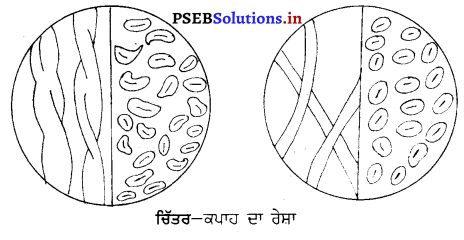
4. ਦਿਖ-ਇਸ ਵਿਚ ਕੁਦਰਤੀ ਚਮਕ ਨਹੀਂ ਹੁੰਦੀ ਪਰ ਰਸਾਇਣਿਕ ਕਿਰਿਆ ਜਿਸ ਨੂੰ ਮਰਸੀਰਾਈਜੇਸ਼ਨ ਕਹਿੰਦੇ ਹਨ, ਨਾਲ ਇਸ ਦੀ ਦਿਖ ਸੁਧਾਰੀ ਜਾ ਸਕਦੀ ਹੈ ।
5. ਮਜ਼ਬੂਤੀ-ਇਹ ਇੱਕ ਮਜ਼ਬੂਤ ਰੇਸ਼ਾ ਹੈ, ਇਸ ਲਈ ਕਾਫ਼ੀ ਰਗੜ ਸਹਿ ਸਕਦਾ ਹੈ । ਗਿੱਲੇ ਹੋਣ ਨਾਲ ਮਜ਼ਬੂਤੀ ਹੋਰ ਵੱਧ ਜਾਂਦੀ ਹੈ । ਮਰਸੀਰਾਈਜੇਸ਼ਨ ਨਾਲ ਪੱਕੇ ਤੌਰ ‘ਤੇ ਮਜ਼ਬੂਤ ਹੋ ਜਾਂਦਾ ਹੈ ।
6. ਲਚਕੀਲਾਪਨ-ਇਹਨਾਂ ਵਿਚ ਲਚਕ ਨਹੀਂ ਹੁੰਦੀ, ਇਸ ਲਈ ਸੂਤੀ ਕੱਪੜੇ ਵਿੱਚ ਵੱਟ ਜਲਦੀ ਪੈਂਦੇ ਹਨ ।
7. ਪਾਣੀ ਸੋਖਣ ਦੀ ਸਮਰੱਥਾ-ਇਹਨਾਂ ਦੀ ਨਮੀ ਜਾਂ ਪਾਣੀ ਸੋਖਣ ਸ਼ਕਤੀ ਚੰਗੀ ਹੁੰਦੀ ਹੈ । ਜਿਸ ਕਰਕੇ ਪਸੀਨਾ ਸੋਚ ਸਕਦੇ ਹਨ । ਇਸੇ ਲਈ ਇਹਨਾਂ ਨੂੰ ਗਰਮੀਆਂ ਵਿਚ ਪਹਿਨਿਆ ਜਾਂਦਾ ਹੈ । ਇਸ ਗੁਣ ਕਾਰਨ ਹੀ ਸੁਤੀ ਰੇਸ਼ੇ ਦੇ ਤੌਲੀਏ ਬਣਾਏ ਜਾਂਦੇ ਹਨ ।
8. ਤਾਪ ਚਾਲਕਤਾ-ਇਹ ਤਾਪ ਦੇ ਚੰਗੇ ਸੰਚਾਲਕ ਹੁੰਦੇ ਹਨ । ਗਰਮੀ ਇਹਨਾਂ ਵਿਚੋਂ ਦੀ ਲੰਘ ਸਕਦੀ ਹੈ । ਇਸ ਲਈ ਹੀ ਇਹ ਪਸੀਨੇ ਨੂੰ ਸੁੱਕਣ ਵਿਚ ਮਦਦ ਕਰਦੇ ਹਨ | ਸੂਤੀ ਰੇਸ਼ਿਆਂ ਦੀ ਚੰਗੀ ਪਾਣੀ ਸੋਖਣ ਦੀ ਸਮਰੱਥਾ ਅਤੇ ਚੰਗੀ ਤਾਪ ਸੁਚਾਲਕਤਾ ਕਾਰਨ ਵੀ ਇਹ ਠੰਢੇ ਰੇਸ਼ੇ ਹਨ ਅਤੇ ਗਰਮੀਆਂ ਵਿਚ ਪਹਿਨਣ ਲਈ ਸਭ ਤੋਂ ਵੱਧ ਉੱਚਿਤ ਅਤੇ ਢੁੱਕਵੇਂ ਹਨ ।
9. ਰਸਾਇਣਾਂ ਦਾ ਪ੍ਰਭਾਵ-ਖਾਰ ਦਾ ਇਹਨਾਂ ‘ਤੇ ਬਹੁਤ ਚੰਗਾ ਪ੍ਰਭਾਵ ਪੈਂਦਾ ਹੈ ਪਰੰਤੂ ਹਲਕੇ ਜਾਂ ਗਾੜੇ ਤੇਜ਼ਾਬ ਨਾਲ ਖ਼ਰਾਬ ਹੋ ਜਾਂਦੇ ਹਨ ।
10. ਰੰਗਾਈ-ਇਹਨਾਂ ਨੂੰ ਰੰਗਣਾ ਆਸਾਨ ਹੈ ਪਰ ਧੁੱਪ ਅਤੇ ਧੋਣ ਨਾਲ ਇਹਨਾਂ ਦੇ ਰੰਗ ਖ਼ਰਾਬ ਹੋ ਜਾਂਦੇ ਹਨ ।
11. ਉੱਲੀ ਦਾ ਅਸਰ-ਸਿੱਲ੍ਹੇ ਕੱਪੜਿਆਂ ਨੂੰ ਉੱਲੀ ਬਹੁਤ ਲੱਗ ਜਾਂਦੀ ਹੈ ਅਤੇ ਖ਼ਰਾਬ ਕਰ ਦਿੰਦੀ ਹੈ । ਪਰ ਕੀੜਾ ਨਹੀਂ ਲਗਦਾ |
12. ਹੋਰ ਵਿਸ਼ੇਸ਼ਤਾਈਆਂ-ਇਹਨਾਂ ‘ਤੇ ਗਰਮੀ ਦਾ ਅਸਰ ਘੱਟ ਹੁੰਦਾ ਹੈ ਜਿਸ ਕਰਕੇ ਇਹ ਕੱਪੜੇ ਉਬਾਲੇ ਵੀ ਜਾ ਸਕਦੇ ਹਨ ਅਤੇ ਧੁੱਪੇ ਸੁਕਾਏ ਵੀ ਜਾ ਸਕਦੇ ਹਨ | ਪਰ ਰੰਗਦਾਰ ਕੱਪੜਿਆਂ ਦਾ ਰੰਗ ਖ਼ਰਾਬ ਹੋ ਜਾਂਦਾ ਹੈ ਜਿਸ ਕਰਕੇ ਇਹਨਾਂ ਨੂੰ ਨਾ ਤਾਂ ਉਬਾਲਿਆ ਜਾਂਦਾ ਹੈ ਅਤੇ ਨਾ ਹੀ ਧੁੱਪੇ ਸੁਕਾਉਣਾ ਚਾਹੀਦਾ ਹੈ ।
13. ਤਾਪ ਦਾ ਅਸਰ-ਸੁਤੀ ਰੋਸ਼ਾ ਅੱਗ ਜਲਦੀ ਪਕੜਦਾ ਹੈ ਅਤੇ ਪੀਲੀ ਲਾਟ ਨਾਲ ਜਲਦਾ ਹੈ | ਜਲਣ ਸਮੇਂ ਕਾਗਜ਼ ਦੇ ਜਲਣ ਵਰਗੀ ਗੰਧ ਆਉਂਦੀ ਹੈ |
ਅੱਗ ਤੋਂ ਪਰੇ ਕਰਨ ‘ਤੇ ਵੀ ਆਪਣੇ ਆਪ ਜਲਦਾ ਰਹਿੰਦਾ ਹੈ । ਜਲਣ ਉਪਰੰਤ ਸਲੇਟੀ ਰੰਗ ਦੀ ਸੁਆਹ ਬਣਦੀ ਹੈ ।
ਦੇਖ-ਭਾਲ-
- ਸਫ਼ੈਦ ਸੂਤੀ ਕੱਪੜਿਆਂ ਨੂੰ ਗਰਮ ਪਾਣੀ ਵਿਚ ਜਾਂ ਉਬਾਲ ਕੇ ਅਤੇ ਰਗੜ ਕੇ ਧੋਤਾ ਜਾ ਸਕਦਾ ਹੈ । ਰੰਗਦਾਰ ਕੱਪੜਿਆਂ ਨੂੰ ਠੰਢੇ ਪਾਣੀ ਵਿਚ ਹੀ ਧੋਣਾ ਚਾਹੀਦਾ ਹੈ ਅਤੇ ਛਾਵੇਂ ਹੀ ਸੁਕਾਉਣਾ ਚਾਹੀਦਾ ਹੈ ਪਰ ਸਫ਼ੈਦ ਕੱਪੜਿਆਂ ਨੂੰ ਧੁੱਪੇ ਸੁਕਾਉਣ ਨਾਲ ਉਹਨਾਂ ਵਿਚ ਹੋਰ ਸਫ਼ੈਦੀ ਆਉਂਦੀ ਹੈ ।
- ਖਾਰ ਦਾ ਮਾੜਾ ਅਸਰ ਨਹੀਂ ਹੁੰਦਾ, ਇਸ ਲਈ ਕਿਸੇ ਵੀ ਪ੍ਰਕਾਰ ਦੇ ਸਾਬਣ ਨਾਲ ਧੋਤੇ ਜਾ ਸਕਦੇ ਹਨ ।
- ਇਹਨਾਂ ਨੂੰ ਸਿੱਲ੍ਹੇ ਹੀ ਪ੍ਰੈੱਸ ਕਰਨਾ ਚਾਹੀਦਾ ਹੈ । ਦਰਮਿਆਨੀ ਅਤੇ ਤੇਜ਼ ਗਰਮ ਪ੍ਰੈੱਸ ਨਾਲ ਸ ਕੀਤਾ ਜਾ ਸਕਦਾ ਹੈ ।
- ਰੰਗਕਾਟ ਦਾ ਇਹਨਾਂ ‘ਤੇ ਬੁਰਾ ਅਸਰ ਨਹੀਂ ਹੁੰਦਾ ਖ਼ਾਸ ਕਰਕੇ ਕਲੋਰੀਨ ਵਾਲੇ ਰੰਗਕਾਟ | ਤੇਜ਼ ਰੰਗਕਾਟ ਕੱਪੜੇ ਨੂੰ ਕਮਜ਼ੋਰ ਕਰ ਦਿੰਦੇ ਹਨ ।
- ਇਹਨਾਂ ਨੂੰ ਕਦੇ ਵੀ ਸਿੱਲ੍ਹੇ-ਸਿੱਲ੍ਹ ਨਹੀਂ ਸੰਭਾਲਣਾ ਚਾਹੀਦਾ ਕਿਉਂਕਿ ਇਨ੍ਹਾਂ ਨੂੰ ਉੱਲੀ ਜਲਦੀ ਲੱਗ ਜਾਂਦੀ ਹੈ ।
ਲਿਨਨ-ਇਹ ਫਲੈਕਸ ਪੌਦੇ ਦੇ ਤਣੇ ਅਤੇ ਟਾਹਣੀਆਂ ਤੋਂ ਪ੍ਰਾਪਤ ਹੋਣ ਵਾਲਾ ਰੇਸ਼ਾ ਹੈ । ਇਹ ਪੌਦਾ ਘੱਟ ਗਰਮ ਪਰ ਜ਼ਿਆਦਾ ਨਮੀਦਾਰ ਸਿੱਲ੍ਹੇ ਮੌਸਮ ਵਿਚ ਹੁੰਦਾ ਹੈ । ਇਹਨਾਂ ਪੌਦਿਆਂ ਦੀ ਲੰਬਾਈ 10 ਇੰਚ ਤੋਂ 40 ਇੰਚ ਤਕ ਹੋ ਸਕਦੀ ਹੈ । ਇਹ ਰੇਸ਼ਾ ਗੂੰਦ ਜਿਹੀ ਨਾਲ ਤਣੇ ਦੇ ਨਾਲ ਜੁੜਿਆ ਹੁੰਦਾ ਹੈ । ਇਹਨਾਂ ਰੇਸ਼ਿਆਂ ਨੂੰ ਪੌਦਿਆਂ ਤੋਂ ਸਹੀ ਰੂਪ ਵਿਚ ਉਤਾਰਨ ਲਈ ਪੌਦਿਆਂ ਦੇ ਤਣਿਆਂ ਨੂੰ ਐਸ, ਰਸਾਇਣ ਜਾਂ ਪਾਣੀ ਵਿਚ ਰੱਖ ਕੇ ਜਿਵੇਂ ਨਦੀ ਜਾਂ ਤਲਾਬ ਜਾਂ ਰਸਾਇਣਾਂ ਨਾਲ ਪ੍ਰਕਿਰਿਆ ਕਰਕੇ ਉਫਨਾਇਆ ਜਾਂਦਾ ਹੈ ਜਿਸ ਨੂੰ ਨਰਮਾਉਣਾ ਜਾਂ ਗਲਾਉਣਾ (Retting) ਕਿਹਾ ਜਾਂਦਾ ਹੈ ।
ਨਰਮਾਉਣ ਨਾਲ ਗੂੰਦ ਜਿਹਾ ਗਲ ਕੇ ਵੱਖ ਹੋ ਜਾਂਦਾ ਹੈ ਅਤੇ ਰੇਸ਼ੇ ਢਿੱਲੇ ਪੈ ਜਾਂਦੇ ਹਨ ਅਤੇ ਵੱਖਰੇ ਹੋ ਜਾਂਦੇ ਹਨ ।
(ਉ) ਰਚਨਾ-ਇਸ ਵਿਚ 70-85 ਪ੍ਰਤੀਸ਼ਤ ਸੈਲੂਲੋਜ਼ ਹੁੰਦਾ ਹੈ ਅਤੇ ਬਾਕੀ ਅਸ਼ੁੱਧੀਆਂ ਹੁੰਦੀਆਂ ਹਨ ।
(ਅ) ਵਿਸ਼ੇਸ਼ਤਾਈਆਂ –
1. ਬਣਤਰ-ਲਿਨਨ ਦਾ ਰੇਸ਼ਾ ਖੁਰਦਬੀਨ ਦੇ ਹੇਠਾਂ ਲੰਬਾ, ਸਿੱਧਾ, ਇਕਸਾਰ, ਚਮਕਦਾਰ ਅਤੇ ਚਿਕਨਾ ਦਿਖਦਾ ਹੈ ਜਿਸ ਵਿਚ ਬਾਂਸ ਵਾਂਗ ਥੋੜ੍ਹੀ-ਥੋੜ੍ਹੀ ਦੂਰੀ ‘ਤੇ ਗੰਢਾਂ ਹੁੰਦੀਆਂ ਹਨ ।
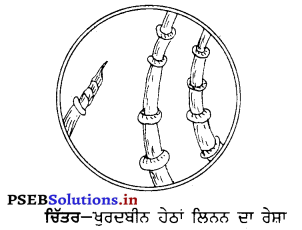
2. ਲੰਬਾਈ-ਇਹ ਵੀ ਛੋਟਾ ਰੇਸ਼ਾ ਹੀ ਹੈ ਅਤੇ ਰੇਸ਼ੇ ਦੀ ਲੰਬਾਈ 6-40 ਇੰਚ ਤਕ ਹੋ ਸਕਦੀ ਹੈ । 12 ਇੰਚ ਤੋਂ ਛੋਟੇ ਰੇਸ਼ੇ ਨੂੰ ਕੱਪੜੇ ਦੀ ਬੁਣਾਈ ਲਈ ਇਸਤੇਮਾਲ ਨਹੀਂ ਕੀਤਾ ਜਾਂਦਾ ।
3. ਰੰਗ-ਇਸ ਦਾ ਰੰਗ ਫਿੱਕੇ ਪੀਲੇ ਤੋਂ ਫਿੱਕਾ ਭੂਰਾ ਹੋ ਸਕਦਾ ਹੈ |
4. ਦਿਖ (ਚਮਕ)-ਇਸ ਵਿਚ ਸੂਤੀ ਰੇਸ਼ੇ ਨਾਲੋਂ ਜ਼ਿਆਦਾ ਚਮਕ ਹੁੰਦੀ ਹੈ ਪਰ ਸਿਲਕ ਤੋਂ ਥੋੜੀ ਘੱਟ ।
5. ਲਚਕੀਲਾਪਨ-ਇਹ ਸੂਤੀ ਰੇਸ਼ੇ ਨਾਲੋਂ ਵੀ ਘੱਟ ਲਚਕੀਲੇ ਹੁੰਦੇ ਹਨ ਇਸ ਲਈ ਵੱਟ ਹੋਰ ਵੀ ਜ਼ਿਆਦਾ ਪੈਂਦੇ ਹਨ ।
6. ਮਜ਼ਬੂਤੀ-ਇਹ ਰੇਸ਼ਾ ਸੂਤੀ ਰੇਸ਼ੇ ਤੋਂ ਵੀ ਵੱਧ ਮਜ਼ਬੂਤ ਹੁੰਦਾ ਹੈ । ਗਿੱਲਾ ਹੋ ਕੇ ਇਸ ਦੀ ਮਜ਼ਬੂਤੀ ਹੋਰ ਵੀ ਵੱਧ ਜਾਂਦੀ ਹੈ ।
7. ਪਾਣੀ ਸੋਖਣ ਦੀ ਸਮਰੱਥਾ-ਪਾਣੀ ਸੋਖਣ ਦੀ ਸ਼ਕਤੀ ਸੂਤੀ ਰੇਸ਼ੇ ਤੋਂ ਵੀ ਜ਼ਿਆਦਾ ਹੁੰਦੀ ਹੈ ।
8. ਤਾਪ ਚਾਲਕਤਾ-ਸੂਤੀ ਰੇਸ਼ਿਆਂ ਤੋਂ ਵੀ ਵੱਧ ਤਾਪ ਦੇ ਸੰਚਾਲਕ ਹੁੰਦੇ ਹਨ ਇਸ ਲਈ ਗਰਮੀਆਂ ਵਿਚ ਸੁਤੀ ਰੇਸ਼ੇ ਤੋਂ ਵੱਧ ਠੰਢਕ ਪਹੁੰਚਾਉਂਦੇ ਹਨ ।
9. ਰਸਾਇਣਾਂ ਦਾ ਅਸਰ-ਇਹ ਤੇਜ਼ ਤੇਜ਼ਾਬ ਨਾਲ ਖ਼ਰਾਬ ਹੋ ਜਾਂਦੇ ਹਨ ਜਦੋਂ ਕਿ ਸੂਤੀ ਕੱਪੜੇ ਵਾਂਗ ਖਾਰ ਦਾ ਅਸਰ ਘੱਟ ਹੁੰਦਾ ਹੈ ।
10. ਰੰਗਾਈ-ਸੂਤੀ ਕੱਪੜੇ ਦੀ ਤਰ੍ਹਾਂ ਸਿੱਧੇ ਰੰਗਾਂ ਨਾਲ ਰੰਗੇ ਜਾਂਦੇ ਹਨ ਅਤੇ ਰੰਗਾਈ ਸੂਤੀ ਕੱਪੜੇ ਤੋਂ ਮੁਸ਼ਕਿਲ ਹੁੰਦੀ ਹੈ । ਪਰ ਧੋਣ ਅਤੇ ਧੁੱਪ ਵਿਚ ਸੁਕਾਉਣ ਸਮੇਂ ਰੰਗ ਜਲਦੀ ਫਿੱਕੇ ਹੋ ਜਾਂਦੇ ਹਨ । ਰੰਗ ਪੱਕੇ ਨਹੀਂ ਹੁੰਦੇ ।
11. ਉੱਲੀ ਅਤੇ ਕੀੜੇ ਦਾ ਅਸਰ-ਇਸ ਨੂੰ ਕੀੜਾ ਬਹੁਤ ਜਲਦੀ ਲਗ ਜਾਂਦਾ ਹੈ ।
12. ਹੋਰ ਵਿਸ਼ੇਸ਼ਤਾਈਆਂ-ਸੂਤੀ ਕੱਪੜੇ ਦੀ ਤਰ੍ਹਾਂ ਹੀ ਇਸ ਨੂੰ ਜਲਾਉਣ ਸਮੇਂ ਪੇਪਰ ਦੇ ਜਲਣ ਵਰਗੀ ਗੰਧ ਆਉਂਦੀ ਹੈ ਅਤੇ ਅੱਗ ਤੋਂ ਬਾਹਰ ਕੱਢਣ ’ਤੇ ਆਪਣੇ ਆਪ ਥੋੜੀ ਦੇਰ ਜਲਦਾ ਰਹਿੰਦਾ ਹੈ । ਜਲਣ ਉਪਰੰਤ ਸਲੇਟੀ ਰੰਗ ਦੀ ਸੁਆਹ ਬਣਦੀ ਹੈ । ਦਰਮਿਆਨੀ ਤੋਂ ਤੇਜ਼ ਪ੍ਰੈੱਸ ਨਾਲ ਪ੍ਰੈੱਸ ਕੀਤਾ ਜਾ ਸਕਦਾ ਹੈ । ਲਿਨਨ ਦੀਆਂ ਕਈ ਵਿਸ਼ੇਸ਼ਤਾਈਆਂ ਸੂਤੀ ਕੱਪੜੇ ਨਾਲ ਮੇਲ ਖਾਂਦੀਆਂ ਹਨ ਪਰ ਜ਼ਿਆਦਾ ਗਰਮੀ ਨਾਲ ਇਹ ਰੇਸ਼ੇ ਖ਼ਰਾਬ ਹੋ ਜਾਂਦੇ ਹਨ ਇਸ ਲਈ ਇਹਨਾਂ ਨੂੰ ਉਬਾਲਣਾ ਨਹੀਂ ਚਾਹੀਦਾ | ਇਹ ਰੇਸ਼ੇ ਮਜ਼ਬੂਤ ਹੋਣ ਕਾਰਨ ਇਹਨਾਂ ਨੂੰ ਵੀ ਰਗੜ ਕੇ ਧੋਇਆ ਜਾ ਸਕਦਾ ਹੈ ।
ਦੇਖਭਾਲ-ਇਹਨਾਂ ਰੇਸ਼ਿਆਂ ‘ਤੇ ਖਾਰ ਦਾ ਮਾੜਾ ਅਸਰ ਨਹੀਂ ਹੁੰਦਾ । ਇਸ ਕਰਕੇ ਕਿਸੇ ਵੀ ਪ੍ਰਕਾਰ ਦੇ ਸਾਬਣ ਨਾਲ ਧੋਏ ਜਾ ਸਕਦੇ ਹਨ । ਇਹਨਾਂ ਨੂੰ ਸੂਤੀ ਕੱਪੜਿਆਂ ਦੀ ਤਰ੍ਹਾਂ ਸਿਲ੍ਹੇਸਿਲ੍ਹੇ ਹੀ ਪ੍ਰੈੱਸ ਕਰਨਾ ਚਾਹੀਦਾ ਹੈ । ਇਹ ਮਜ਼ਬੂਤ ਹੁੰਦੇ ਹਨ ਇਸ ਲਈ ਰਗੜ ਕੇ ਧੋਤਾ ਜਾ ਸਕਦਾ ਹੈ । ਗਰਮੀ ਨਾਲ ਖ਼ਰਾਬ ਹੁੰਦੇ ਹਨ ਇਸ ਲਈ ਉਬਾਲਣਾ ਨਹੀਂ ਚਾਹੀਦਾ । ਇਹਨਾਂ ਦੇ ਰੰਗ ਪੱਕੇ ਨਹੀਂ ਹੁੰਦੇ ਇਸ ਲਈ ਛਾਂ ਵਿਚ ਹੀ ਸੁਕਾਉਣਾ ਚਾਹੀਦਾ ਹੈ । ਇਹਨਾਂ ਨੂੰ ਕੀੜਾ ਬਹੁਤ ਜਲਦੀ ਲਗਦਾ ਹੈ ਇਸ ਲਈ ਚੰਗੀ ਤਰ੍ਹਾਂ ਧੋ ਕੇ ਸੁਕਾ ਕੇ ਸਾਫ਼ ਸੁੱਕੀ ਜਗ੍ਹਾ ‘ਤੇ ਰੱਖਣਾ ਚਾਹੀਦਾ ਹੈ ।

ਪ੍ਰਸ਼ਨ 4.
ਜਾਨਵਰਾਂ ਤੋਂ ਪ੍ਰਾਪਤ ਹੋਣ ਵਾਲੇ ਰੇਸ਼ੇ ਕਿਹੜੇ ਹਨ ? ਇਹਨਾਂ ਦੀ ਰਚਨਾ ਅਤੇ ਵਿਸ਼ੇਸ਼ਤਾਈਆਂ ਬਾਰੇ ਦੱਸੋ ।
ਉੱਤਰ-
ਜਾਨਵਰਾਂ ਤੋਂ ਪ੍ਰਾਪਤ ਹੋਣ ਵਾਲੇ ਰੇਸ਼ਿਆਂ ਵਿਚ ਪ੍ਰੋਟੀਨ ਦਾ ਅੰਸ਼ ਵੱਧ ਹੁੰਦਾ ਹੈ ਜਿਸ ਕਰਕੇ ਇਹਨਾਂ ਨੂੰ ਪ੍ਰੋਟੀਨ ਰੇਸ਼ੇ ਕਹਿੰਦੇ ਹਨ । ਇਨ੍ਹਾਂ ਦੇ ਕਈ ਗੁਣ ਇਕ ਸਾਰ ਹੁੰਦੇ ਹਨ ਅਤੇ ਜ਼ਿਆਦਾਤਰ ਜਾਨਵਰਾਂ ਦੇ ਵਾਲਾਂ ਤੋਂ ਪ੍ਰਾਪਤ ਕੀਤੇ ਜਾਂਦੇ ਹਨ । ਸਿਲਕ (ਰੇਸ਼ਮ-ਇਹ ਜਾਨਵਰਾਂ ਤੋਂ ਮਿਲਣ ਵਾਲਾ ਪ੍ਰੋਟੀਨਯੁਕਤ ਰੇਸ਼ਾ ਹੈ ਜੋ ਸਿਲਕ ਦੇ ਕੀੜੇ ਦੇ ਲਾਰਵੇ ਦੀ ਲਾਰ ਤੋਂ ਬਣਦਾ ਹੈ । ਰਚਨਾ-ਇਹ ਰੇਸ਼ੇ ਪ੍ਰੋਟੀਨ ਤੋਂ ਬਣੇ ਹੁੰਦੇ ਹਨ ਜਿਸ ਵਿਚ ਕਾਰਬਨ, ਹਾਈਡਰੋਜਨ, ਆਕਸੀਜਨ ਅਤੇ ਨਾਈਟਰੋਜਨ ਤੱਤ ਹੁੰਦੇ ਹਨ ।
(ੳ) ਆਮ ਵਿਸ਼ੇਸ਼ਤਾਈਆਂ –
1.ਬਣਤਰ-ਖੁਰਦਬੀਨ ਹੇਠਾਂ ਰੇਸ਼ਮ ਦੇ ਰੇਸ਼ੇ ਚਮਕਦਾਰ, ਦੁਹਰੇ ਧਾਗੇ ਦੇ ਬਣੇ ਹੋਏ ਦਿਸਦੇ ਹਨ ਜਿਨ੍ਹਾਂ ‘ਤੇ ਜਗ੍ਹਾ-ਜਗ੍ਹਾ ਗੂੰਦ ਦੇ ਧੱਬੇ ਲੱਗੇ ਹੁੰਦੇ ਹਨ ।
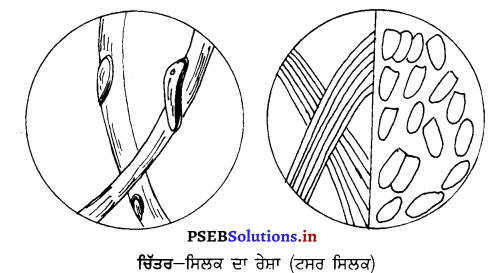
2. ਲੰਬਾਈ-ਕੁਦਰਤੀ ਰੂਪ ਵਿਚ ਮਿਲਣ ਵਾਲਾ ਇੱਕੋ ਇਕ ਫਿਲਾਮੈਂਟ ਰੇਸ਼ਾ ਹੈ । ਰੇਸ਼ੇ ਦੀ ਲੰਬਾਈ 750 ਤੋਂ 1100 ਮੀਟਰ ਤਕ ਹੋ ਸਕਦੀ ਹੈ ।
3. ਰੰਗ-ਇਸ ਦਾ ਰੰਗ ਕਰੀਮ ਤੋਂ ਭੂਰਾ ਜਾਂ ਸਲੇਟੀ ਜਿਹਾ ਹੋ ਸਕਦਾ ਹੈ ।
4. ਦਿਖ (ਚਮਕ)-ਇਹਨਾਂ ਰੇਸ਼ਿਆਂ ਵਿਚ ਸਭ ਤੋਂ ਵੱਧ ਚਮਕ ਹੁੰਦੀ ਹੈ । ਇਸ ਲਈ ਸਿਲਕ ਨੂੰ ਕੱਪੜਿਆਂ ਦੀ ਰਾਣੀ ਕਿਹਾ ਜਾਂਦਾ ਹੈ ।
5. ਮਜ਼ਬੂਤੀ-ਕੁਦਰਤੀ ਰੂਪ ਵਿਚ ਮਿਲਣ ਵਾਲੇ ਸਭ ਰੇਸ਼ਿਆਂ ਤੋਂ ਮਜ਼ਬੂਤ ਹੁੰਦਾ ਹੈ, ਪਰ ਗਿੱਲਾ ਹੋਣ ‘ਤੇ ਇਹਨਾਂ ਦੀ ਮਜ਼ਬੂਤੀ ਘਟਦੀ ਹੈ ।
6. ਲਚਕੀਲਾਪਨ-ਲਚਕ ਚੰਗੀ ਹੁੰਦੀ ਹੈ । ਇਸੇ ਲਈ ਹੀ ਵੱਟ ਘੱਟ ਪੈਂਦੇ ਹਨ ।
7. ਪਾਣੀ ਸੋਖਣ ਦੀ ਸਮਰੱਥਾ-ਆਸਾਨੀ ਨਾਲ ਪਾਣੀ ਸੋਖ ਲੈਂਦੀ ਹੈ ਅਤੇ ਮਹਿਸੂਸ ਵੀ ਨਹੀਂ ਹੁੰਦਾ ਕੱਪੜਾ ਗਿੱਲਾ ਹੈ । ਸੁਕਾਉਣ ਤੇ ਕੱਪੜਾ ਬਰਾਬਰ ਸੁੱਕਦਾ ਹੈ।
8. ਤਾਪ ਚਾਲਕਤਾ-ਉੱਨ ਵਾਂਗ ਤਾਪ ਦੇ ਚੰਗੇ ਚਾਲਕ ਨਹੀਂ ਜਿਸ ਕਰਕੇ ਇਹਨਾਂ ਨੂੰ ਸਰਦੀਆਂ ਵਿਚ ਪਹਿਨਿਆ ਜਾਂਦਾ ਹੈ । ਇਹਨਾਂ ਦੀ ਸਤਾ ਮੁਲਾਇਮ ਹੋਣ ਕਾਰਨ, ਉੱਨ ਜਿੰਨੇ ਨਿੱਘੇ ਨਹੀਂ ਹੁੰਦੇ।
9. ਰਸਾਇਣਾਂ ਦਾ ਪ੍ਰਭਾਵ-ਉੱਨ ਵਾਂਗ ਹਲਕੇ ਤੇਜ਼ਾਬ ਦੁਆਰਾ ਖ਼ਰਾਬ ਨਹੀਂ ਹੁੰਦੇ ਪਰ ਹਲਕੀ ਖਾਰ ਵੀ ਇਹਨਾਂ ‘ਤੇ ਬੁਰਾ ਪ੍ਰਭਾਵ ਪਾਉਂਦੀ ਹੈ । ਕਲੋਰੀਨ ਯੁਕਤ ਰੰਗ ਕਾਟਾਂ ਦਾ ਇਸਤੇਮਾਲ ਨਹੀਂ ਕਰਨਾ ਚਾਹੀਦਾ ।
10. ਰੰਗਾਈ-ਇਹਨਾਂ ਨੂੰ ਰੰਗ ਜਲਦੀ ਅਤੇ ਪੱਕੇ ਚੜ੍ਹਦੇ ਹਨ ਜੋ ਧੁੱਪ ਅਤੇ ਧੋਣ ਨਾਲ ਵੀ ਜਲਦੀ ਖ਼ਰਾਬ ਨਹੀਂ ਹੁੰਦੇ । ਇਹਨਾਂ ਨੂੰ ਹਰ ਤਰ੍ਹਾਂ ਦੇ ਰੰਗ ਨਾਲ ਰੰਗਿਆ ਜਾ ਸਕਦਾ ਹੈ ।
11. ਤਾਪ ਦਾ ਪ੍ਰਭਾਵ-ਸਿਲਕ ਦੇ ਜਲਣ ਸਮੇਂ ਚਰ-ਚਰ ਦੀ ਆਵਾਜ਼ ਆਉਂਦੀ ਹੈ ਅਤੇ ਖੰਭਾਂ ਜਾਂ ਵਾਲਾਂ ਦੇ ਜਲਣ ਵਰਗੀ ਗੰਧ ਆਉਂਦੀ ਹੈ । ਅੱਗ ਤੋਂ ਬਾਹਰ ਕੱਢਣ ‘ਤੇ ਆਪਣੇ ਆਪ ਬੁਝ ਜਾਂਦੀ ਹੈ । ਜਲਣ ਉਪਰੰਤ ਉਘੜਾ-ਦੁਘੜਾ ਕਾਲਾ ਮਣਕਾ ਬਣਦਾ ਹੈ । ਧੁੱਪ ਵਿਚ ਸੁਕਾਉਣ ਨਾਲ ਜਾਂ ਗਰਮ ਪਾਣੀ ਨਾਲ ਧੋਣ ਨਾਲ ਅਤੇ ਗਰਮ ਪ੍ਰੈੱਸ ਕਰਨ ਨਾਲ ਕੱਪੜਾ ਕਮਜ਼ੋਰ ਹੋ ਜਾਂਦਾ ਹੈ । ਚਮਕ ਤੇ ਰੰਗ ਵੀ ਖ਼ਰਾਬ ਹੋ ਜਾਂਦੇ ਹਨ ।
12. ਹੋਰ ਵਿਸ਼ੇਸ਼ਤਾਈਆਂ-ਗਿੱਲੇ ਹੋ ਕੇ ਕੱਪੜਾ ਕਮਜ਼ੋਰ ਹੁੰਦਾ ਹੈ ਇਸ ਲਈ ਰਗੜਨ ਨਾਲ ਫਟ ਸਕਦਾ ਹੈ ।
ਉੱਨ-ਰਚਨਾ-ਉੱਨ ਦਾ ਮੁੱਖ ਤੱਤ ਕਿਰੇਟਿਨ (Keratin) ਨਾਮਕ ਪ੍ਰੋਟੀਨ ਹੈ ਜਿਸ ਵਿਚ ਕਾਰਬਨ, ਹਾਈਡਰੋਜਨ, ਆਕਸੀਜਨ ਅਤੇ ਨਾਈਟਰੋਜਨ ਤੋਂ ਇਲਾਵਾ ਸਲਫਰ ਵੀ ਹੁੰਦੀ ਹੈ ।
(ਅ) ਵਿਸ਼ੇਸ਼ਤਾਈਆਂ
- ਬਣਤਰ-ਖੁਰਦਬੀਨ ਦੇ ਹੇਠਾਂ ਉੱਨ ’ਤੇ ਤੰਤੂ ਦੀਆਂ ਪਰਤਾਂ ਜਿਹੀਆਂ ਇਕ-ਦੂਜੇ ‘ਤੇ ਉੱਤੇ ਜਗਾ ਜਗਾ ਤੋਂ ਚੜ੍ਹੀਆਂ ਦਿਖਦੀਆਂ ਹਨ । ਜਿੰਨੀਆਂ ਇਹ ਪਰਤਾਂ ਸੰਘਣੀਆਂ ਹੋਣਗੀਆਂ, ਉੱਨ ਉਤਨੀ ਹੀ ਨਿੱਘੀ ਹੋਵੇਗੀ । ਇਸੇ ਗੁਣ ਕਾਰਨ ਹੀ ਇਹ ਸਿਲਕ ਤੋਂ ਵੱਧ ਨਿੱਘਾ ਹੁੰਦਾ ਹੈ ।
- ਲੰਬਾਈ-ਇਹ ਵੀ ਸਟੇਪਲ (ਛੋਟਾ) ਰੇਸ਼ਾ ਹੈ । ਇਹਨਾਂ ਰੇਸ਼ਿਆਂ ਦੀ ਲੰਬਾਈ 1-18 ਇੰਚ ਤਕ ਹੋ ਸਕਦੀ ਹੈ ।

- ਰੰਗ-ਆਮ ਤੌਰ ‘ਤੇ ਕਰੀਮ, ਪਰ ਮੋਤੀਆ, ਸਫ਼ੈਦ, ਕਾਲੇ ਅਤੇ ਭੂਰੇ ਰੰਗ ਵਿਚ ਵੀ ਮਿਲਦੇ ਹਨ ।
- ਦਿੱਖ-ਇਹਨਾਂ ਰੇਸ਼ਿਆਂ ਵਿਚ ਕੋਈ ਚਮਕ ਨਹੀਂ ਹੁੰਦੀ ।
- ਮਜ਼ਬੂਤੀ-ਇਹ ਕਮਜ਼ੋਰ ਕਿਸਮ ਦਾ ਤੰਤੂ ਹੈ ।ਗਿੱਲਾ ਹੋਣ ‘ਤੇ ਇਸ ਦੀ ਮਜ਼ਬੂਤੀ ਹੋਰ ਘਟਦੀ ਹੈ ।
- ਲਚਕੀਲਾਪਨ-ਇਸ ਰੇਸ਼ੇ ਵਿਚ ਲਚਕ ਕਾਫ਼ੀ ਹੁੰਦੀ ਹੈ ਇਸ ਲਈ ਹੀ ਇਹਨਾਂ ਤੋਂ ਬਣੇ ਕੱਪੜਿਆਂ ਵਿਚ ਵੱਟ ਘੱਟ ਪੈਂਦੇ ਹਨ ।
- ਪਾਣੀ ਸੋਖਣ ਦੀ ਸਮਰੱਥਾ-ਪਾਣੀ ਜਾਂ ਨਮੀ ਸੋਖਣ ਦੀ ਤਾਕਤ ਬਹੁਤ ਹੁੰਦੀ ਹੈ । ਇਹ ਕੱਪੜੇ ਪਾਣੀ ਵਿਚ ਭਿਉਣ ‘ਤੇ ਬਹੁਤ ਪਾਣੀ ਸੋਖ ਲੈਂਦੇ ਹਨ ਅਤੇ ਹੌਲੀ-ਹੌਲੀ ਸੁੱਕਦੇ ਹਨ । ਇਹ ਕਮਜ਼ੋਰ ਰੇਸ਼ਾ ਗਿੱਲੇ ਹੋਣ ‘ਤੇ ਹੋਰ ਵੀ ਕਮਜ਼ੋਰ ਹੋ ਜਾਂਦਾ ਹੈ । ਇਸ ਲਈ ਰਗੜ ਕੇ ਨਹੀਂ ਧੋਤੇ ਜਾ ਸਕਦੇ ।
- ਤਾਪ ਚਾਲਕਤਾ-ਸਿਲਕ ਦੀ ਤਰ੍ਹਾਂ ਉੱਨ ਦਾ ਰੇਸ਼ਾ ਤਾਪ ਦਾ ਚੰਗਾ ਚਾਲਕ ਨਹੀਂ ਹੈ । ਤਾਪ ਦਾ ਕੁਚਾਲਕ ਹੋਣ ਕਾਰਨ ਹੀ ਸਰਦੀਆਂ ਵਿਚ ਪਹਿਨਣ ਲਈ ਉਪਯੋਗੀ ਹੈ ਕਿਉਂਕਿ ਇਹ ਸਰੀਰ ਦੀ ਗਰਮੀ ਨੂੰ ਬਾਹਰ ਨਹੀਂ ਨਿਕਲਣ ਦਿੰਦੇ ।
- ਰਸਾਇਣਾਂ ਦਾ ਪ੍ਰਭਾਵ-ਹਲਕੇ ਤੇਜ਼ਾਬ ਦਾ ਇਹਨਾਂ ‘ਤੇ ਕੋਈ ਪ੍ਰਭਾਵ ਨਹੀਂ ਪੈਂਦਾ । ਤੇਜ਼ ਤੇਜ਼ਾਬ ਠੀਕ ਨਹੀਂ । ਖਾਰ ਨਾਲ ਬਹੁਤ ਨੁਕਸਾਨ ਹੁੰਦਾ ਹੈ । ਇਹਨਾਂ ਨੂੰ ਰੰਗਣ ਸਮੇਂ ਹਲਕੇ ਤੇਜ਼ਾਬ ਦੀ ਵਰਤੋਂ ਕੀਤੀ ਜਾਂਦੀ ਹੈ । ਪਰ ਧੋਣ ਸਮੇਂ ਸੋਡੇ ਦਾ ਇਸਤੇਮਾਲ ਬਿਲਕੁਲ ਨਹੀਂ ਕਰਨਾ ਚਾਹੀਦਾ |
- ਰੰਗਾਈ-ਤੇਜ਼ਾਬ ਵਾਲੇ ਰੰਗਾਂ ਨਾਲ ਇਹਨਾਂ ਦੀ ਰੰਗਾਈ ਕੀਤੀ ਜਾਂਦੀ ਹੈ । ਇਹ ਰੰਗ ਨੂੰ ਜਲਦੀ ਆਪਣੇ ਅੰਦਰ ਸਮਾ ਲੈਂਦੇ ਹਨ ਅਤੇ ਰੰਗ ਵੀ ਪੱਕੇ ਚੜ੍ਹਦੇ ਹਨ । ਇਹਨਾਂ ’ਤੇ ਰੰਗਕਾਟ ਦਾ ਇਸਤੇਮਾਲ ਨਹੀਂ ਕਰਨਾ ਚਾਹੀਦਾ ਕਿਉਂਕਿ ਇਹ ਖੁਰਦਰੇ ਅਤੇ ਕਮਜ਼ੋਰ ਹੋ ਜਾਂਦੇ ਹਨ ।
- ਕੀੜੇ ਅਤੇ ਉੱਲੀ ਦਾ ਪ੍ਰਭਾਵ-ਇਹਨਾਂ ਕੱਪੜਿਆਂ ਨੂੰ ਕੀੜਾ ਬਹੁਤ ਜਲਦੀ ਲੱਗਦਾ ਹੈ ਇਸ ਲਈ ਇਹਨਾਂ ਨੂੰ ਸੰਭਾਲਣ ਸਮੇਂ ਬਹੁਤ ਸਾਵਧਾਨੀ ਦੀ ਲੋੜ ਹੈ ।
- ਤਾਪ ਦਾ ਪ੍ਰਭਾਵ-ਇਹਨਾਂ ਨੂੰ ਜਲਾਉਣ ਸਮੇਂ ਵਾਲਾਂ ਦੇ ਜਲਣ ਵਰਗੀ ਗੰਧ ਆਉਂਦੀ ਹੈ ਅਤੇ ਹੌਲੀ-ਹੌਲੀ ਚਰ-ਚਰ ਕਰਕੇ ਜਲਦੇ ਹਨ | ਅੱਗ ਤੋਂ ਬਾਹਰ ਕੱਢਣ ’ਤੇ ਬੁਝ ਜਾਂਦੇ ਹਨ ਅਤੇ ਜਲਣ ਉਪਰੰਤ ਕਾਲੇ ਰੰਗ ਦਾ ਉਘੜਾ-ਦੁਘੜਾ, ਭੁਰਭੁਰਾ ਮਣਕਾ ਬਣ ਜਾਂਦਾ ਹੈ । ਐੱਸ ਇਹਨਾਂ ਨੂੰ ਸਿੱਧੇ ਕੱਪੜੇ ‘ਤੇ ਨਹੀਂ ਕਰਨੀ ਚਾਹੀਦੀ ਸਗੋਂ ਮਲਮਲ ਦਾ ਸਿੱਲ੍ਹਾ ਕੱਪੜਾ ਵਿਛਾ ਕੇ ਹਲਕੀ ਪ੍ਰੈੱਸ ਕਰਨੀ ਚਾਹੀਦੀ ਹੈ ।
ਪ੍ਰਸ਼ਨ 5.
ਲਿਨਨ ਦੇ ਕੱਪੜਿਆਂ ਦੀਆਂ ਵਿਸ਼ੇਸ਼ਤਾਵਾਂ ਦੱਸੋ !
ਉੱਤਰ-
ਖੁਦ ਉੱਤਰ ਦਿਓ ।
Home Science Guide for Class 10 PSEB ਰੇਸ਼ਿਆਂ ਦਾ ਵਰਗੀਕਰਨ Important Questions and Answers
ਬਹੁਤ ਛੋਟੇ ਉੱਡਰਾਂ ਵਾਲੇ ਪ੍ਰਸ਼ਨ
ਪ੍ਰਸ਼ਨ 1. ਛੋਟੇ (ਸਟੇਪਲ ਰੇਸ਼ਿਆਂ ਦੀ ਲੰਬਾਈ ਕਿੰਨੀ ਹੁੰਦੀ ਹੈ ?
ਉੱਤਰ-
1/4 ਤੋਂ 18 ਇੰਚ ਲੰਮੇ ।
ਪ੍ਰਸ਼ਨ 2.
ਲੰਮੇ (ਫਿਲਾਮੇਂਟ ਰੇਸ਼ਿਆਂ ਦੀ ਲੰਬਾਈ ਕਿੰਨੀ ਹੁੰਦੀ ਹੈ ?
ਉੱਤਰ-
ਮੀਟਰਾਂ ਵਿਚ ਹੁੰਦੀ ਹੈ ।
ਪ੍ਰਸ਼ਨ 3.
ਛੋਟੇ ਰੇਸ਼ਿਆਂ ਦੀ ਉਦਾਹਰਨ ਦਿਉ ।
ਉੱਤਰ-
ਲਗਭਗ ਸਾਰੇ ਕੁਦਰਤੀ ਰੇਸ਼ੇ ।

ਪ੍ਰਸ਼ਨ 4.
ਰੇਸ਼ਮ ਕਿਹੋ ਜਿਹਾ ਰੇਸ਼ਾ ਹੈ ?
ਉੱਤਰ-
ਲੰਮਾ ਰੇਸ਼ਾ ।
ਪ੍ਰਸ਼ਨ 5.
ਬਨਾਵਟੀ ਫਿਲਾਮੈਂਟ ਰੇਸ਼ੇ ਕਿਹੜੇ ਹਨ ?
ਉੱਤਰ-
ਨਾਈਲੋਨ, ਪਾਲਿਸਟਰ ॥
ਪ੍ਰਸ਼ਨ 6.
ਦੋ ਕੁਦਰਤੀ ਰੇਸ਼ਿਆਂ ਦੀ ਉਦਾਹਰਨ ਦਿਓ (ਦੇ ਨਾਂ ਲਿਖੋ ।
ਉੱਤਰ-
ਸਣ, ਪਟਸਨ, ਕਪਾਹ ।
ਪ੍ਰਸ਼ਨ 7.
ਕੋਈ ਦੋ ਧਾਤ ਤੋਂ ਬਣੇ ਰੇਸ਼ੇ ਦੀ ਉਦਾਹਰਨ ਦਿਉ ।
ਉੱਤਰ-
ਗੋਟੇ, ਜਰੀ ਆਦਿ ।
ਪ੍ਰਸ਼ਨ 8.
ਥਰਮੋਪਲਾਸਟਿਕ ਰੇਸ਼ਿਆਂ ਦੀ ਉਦਾਹਰਨ ਦਿਓ ।
ਉੱਤਰ-
ਨਾਈਲੋਨ, ਪੋਲਿਸਟਰ, ਐਸਟੇਟ ।
ਪ੍ਰਸ਼ਨ 9.
ਕੈਸ਼ਮਿਲੋਨ ਕਿਹੋ ਜਿਹਾ ਰੇਸ਼ਾ ਹੈ ?
ਉੱਤਰ-
ਇਹ ਮਿਸ਼ਰਤ ਰੇਸ਼ਾ ਹੈ ।
ਪ੍ਰਸ਼ਨ 10.
ਪ੍ਰੋਟੀਨ ਵਾਲਾ ਰੇਸ਼ਾ ਕਿਹੜਾ ਹੈ ?
ਉੱਤਰ-
ਊਨ, ਸਿਲਕ ।
ਪ੍ਰਸ਼ਨ 11.
ਸੂਤੀ ਰੇਸ਼ੇ ਵਿਚ ਕਿੰਨੇ ਪ੍ਰਤੀਸ਼ਤ ਸੈਲੂਲੋਜ਼ ਹੁੰਦਾ ਹੈ ?
ਉੱਤਰ-
87 ਤੋਂ 90%.
ਪ੍ਰਸ਼ਨ 12.
ਲਿਨਨ ਕਿੱਥੋਂ ਪ੍ਰਾਪਤ ਹੁੰਦੀ ਹੈ ?
ਉੱਤਰ-
ਫਲੈਕਸ ਪੌਦੇ ਦੇ ਤਣੇ ਤੋਂ ।

ਪ੍ਰਸ਼ਨ 13.
ਕਿਸੇ ਦੋ ਬਨਸਪਤੀ ਤੰਤੂਆਂ ਦੇ ਨਾਂ ਲਿਖੋ ।
ਉੱਤਰ-
ਸਤੀ, ਲਿਨਨ, ਨਾਰੀਅਲ ਦੇ ਰੇਸ਼ੇ ।
ਪ੍ਰਸ਼ਨ 14.
ਲੰਬਾਈ ਅਤੇ ਚੌੜਾਈ ਵਿਚ ਚੱਲਣ ਵਾਲੇ ਧਾਗੇ ਦਾ ਨਾਂ ਦੱਸੋ ।
ਜਾਂ
ਤਾਨਾ ਅਤੇ ਬਾਨਾ ਕੀ ਹੁੰਦਾ ਹੈ ?
ਉੱਤਰ-
ਜਦੋਂ ਕੱਪੜਾ ਬੁਣਿਆ ਜਾਂਦਾ ਹੈ ਤਾਂ ਲੰਬਾਈ ਵਿਚ ਚੱਲਣ ਵਾਲੇ ਧਾਗੇ ਨੂੰ ਤਾਨਾ ਅਤੇ ਚੌੜਾਈ ਵਿੱਚ ਚੱਲਣ ਵਾਲੇ ਧਾਗੇ ਨੂੰ ਬਾਨਾ ਕਿਹਾ ਜਾਂਦਾ ਹੈ ।
ਛੋਟੇ ਉੱਤਰਾਂ ਵਾਲੇ ਪ੍ਰਸ਼ਨ
ਪ੍ਰਸ਼ਨ 1.
ਨਾਰੀਅਲ ਦੇ ਰੇਸ਼ੇ ਕਿਸ ਤਰ੍ਹਾਂ ਪ੍ਰਾਪਤ ਕੀਤੇ ਜਾਂਦੇ ਹਨ ਅਤੇ ਕਿਸ ਕੰਮ ਆਉਂਦੇ ਹਨ ?
ਉੱਤਰ-
ਨਾਰੀਅਲ ਦੇ ਰੇਸ਼ੇ ਨਾਰੀਅਲ ਦੇ ਬੀਜ ਦੇ ਛਿਲਕੇ ਤੋਂ ਤਿਆਰ ਹੁੰਦੇ ਹਨ । ਇਹ ਗਿਰੀ ਅਤੇ ਬਾਹਰਲੇ ਛਿਲਕੇ ਦੇ ਵਿਚਕਾਰ ਹੁੰਦੇ ਹਨ । ਇਹਨਾਂ ਨੂੰ ਸਮੁੰਦਰ ਦੇ ਪਾਣੀ ਵਿਚ ਭਿਉਂ ਕੇ ਨਰਮ ਕੀਤਾ ਜਾਂਦਾ ਹੈ ਫਿਰ ਕੁੱਟ-ਕੁੱਟ ਕੇ ਸਾਫ਼ ਕਰਕੇ ਬਾਹਰ ਕੱਢ ਲਿਆ ਜਾਂਦਾ | ਇਹਨਾਂ ਰੇਸ਼ਿਆਂ ਨੂੰ ਆਮ ਤੌਰ ‘ਤੇ ਰੰਗਿਆ ਨਹੀਂ ਜਾਂਦਾ ਇਹਨਾਂ ਦਾ ਆਪਣਾ ਰੰਗ ਗੂੜ੍ਹਾ ਭਰਾ ਹੁੰਦਾ ਹੈ । ਨਾਰੀਅਲ ਦੇ ਰੇਸ਼ੇ ਅਕੜਾਅ ਵਾਲੇ ਅਤੇ ਮਜ਼ਬੂਤ ਹੁੰਦੇ ਹਨ । ਇਹਨਾਂ ਨੂੰ ਵੱਟ ਨਹੀਂ ਪੈਂਦੇ ਜ਼ਿਆਦਾਤਰ ਇਹ ਰੇਸ਼ੇ ਸੋਫਿਆਂ ਅਤੇ ਗੱਦਿਆਂ ਨੂੰ ਭਰਨ ਲਈ ਵਰਤੇ ਜਾਂਦੇ ਹਨ । ਪਰ ਇਨ੍ਹਾਂ ਤੋਂ ਟਾਟ ਅਤੇ ਜੁੱਤੀਆਂ ਦੇ ਤਲੇ ਵੀ ਬਣਾਏ ਜਾਂਦੇ ਹਨ ।
ਪ੍ਰਸ਼ਨ 2.
ਚੀਨ ਦੀ ਲਿਨਨ ਕਿਸ ਰੇਸ਼ੇ ਤੋਂ ਤਿਆਰ ਕੀਤੀ ਜਾਂਦੀ ਹੈ ਅਤੇ ਇਸ ਦੇ ਕੀ ਗੁਣ ਹਨ ?
ਉੱਤਰ-
ਚੀਨ ਦੀ ਲਿਨਨ ਪੌਦੇ ਦੇ ਤਣੇ ਤੋਂ ਤਿਆਰ ਕੀਤੀ ਜਾਂਦੀ ਹੈ ਅਤੇ ਇਸ ਨੂੰ ਰੇਮੀ ਵੀ ਕਿਹਾ ਜਾਂਦਾ ਹੈ । ਇਹ ਪੌਦੇ ਜਪਾਨ, ਫਰਾਂਸ, ਮਿਸਰ, ਇਟਲੀ ਅਤੇ ਰਸ ਵਿਚ ਉਗਾਏ ਜਾਂਦੇ ਹਨ । ਇਸ ਦੇ ਪੌਦੇ 4 ਤੋਂ 8 ਫੁੱਟ ਉੱਚੇ ਹੋ ਸਕਦੇ ਹਨ । ਇਸ ਦੇ ਤਣਿਆਂ ਨੂੰ ਕੱਟ ਕੇ ਪਾਣੀ ਵਿਚ ਗਲਾਇਆ ਜਾਂਦਾ ਹੈ ਅਤੇ ਫਿਰ ਰਸਾਇਣਾਂ ਦੀ ਵਰਤੋਂ ਨਾਲ ਫਾਲਤੂ ਗੁੰਦ ਕੱਢ ਦਿੱਤੀ ਜਾਂਦੀ ਹੈ । ਉਸ ਤੋਂ ਪਿੱਛੋਂ ਕੰਘੀ ਕਰਕੇ ਇਸ ਦੇ ਰੇਸ਼ਿਆਂ ਨੂੰ ਸਾਫ ਕੀਤਾ ਜਾਂਦਾ ਹੈ । ਇਹ ਰੇਸ਼ੇ ਲੰਮੇ, ਮਜ਼ਬੂਤ, ਚਮਕਦਾਰ, ਬਾਰੀਕ ਅਤੇ ਸਫ਼ੈਦ ਰੰਗ ਦੇ ਹੁੰਦੇ ਹਨ । ਇਹਨਾਂ ਰੇਸ਼ਿਆਂ ਵਿਚ ਅਕੜਾਅ ਵੱਧ ਅਤੇ ਲਚਕ ਘੱਟ ਹੁੰਦੀ ਹੈ ।
ਪ੍ਰਸ਼ਨ 3.
ਕੁਦਰਤ ਵਿਚ ਮਿਲਣ ਵਾਲੇ ਰੇਸ਼ੇ ਕਿਹੜੇ-ਕਿਹੜੇ ਹਨ ? ਕਿਸੇ ਇਕ ਰੇਸ਼ੇ ਦੀਆਂ ਵਿਸ਼ੇਸ਼ਤਾਵਾਂ ਅਤੇ ਦੇਖਭਾਲ ਬਾਰੇ ਦੱਸੋ ।
ਉੱਤਰ-
ਦੇਖੋ ਉਪਰੋਕਤ ਪ੍ਰਸ਼ਨਾਂ ਵਿੱਚ ।
ਪ੍ਰਸ਼ਨ 4.
ਪਟਸਨ ਕੀ ਹੈ ?
ਉੱਤਰ-
ਇਹ ਪੌਦੇ ਦੇ ਤਣੇ ਤੋਂ ਮਿਲਣ ਵਾਲਾ ਰੇਸ਼ਾ ਹੈ । ਇਸ ਨਾਲ ਰੱਸੀਆਂ, ਡੋਰੀਆਂ ਅਤੇ ਵਧੀਆ ਕੱਪੜਾ ਬਣਦਾ ਹੈ ।

ਪ੍ਰਸ਼ਨ 5.
ਉੱਨ ਕੀ ਹੈ ? ਇਸ ਦੀਆਂ ਵਿਸ਼ੇਸ਼ਤਾਵਾਂ ਅਤੇ ਦੇਖਭਾਲ ਬਾਰੇ ਦੱਸੋ ।
ਉੱਨ ਦੀਆਂ ਵਿਸ਼ੇਸ਼ਤਾਈਆਂ, ਵਰਤੋਂ ਅਤੇ ਦੇਖਭਾਲ ਦੱਸੋ ।
ਉੱਤਰ-
ਉਪਰੋਕਤ ਪ੍ਰਸ਼ਨ ਦੇਖੋ ।
ਪ੍ਰਸ਼ਨ 6.
ਬਣਾਉਟੀ ਕੱਪੜਿਆਂ ਨੂੰ ਸੰਭਾਲਣਾ ਆਸਾਨ ਕਿਉਂ ਹੈ ?
ਉੱਤਰ-
ਬਣਾਉਟੀ ਕੱਪੜਿਆਂ ਨੂੰ ਕੀੜੇ ਅਤੇ ਉੱਲੀ ਨਹੀਂ ਲੱਗਦੀ । ਇਸ ਲਈ ਇਹਨਾਂ ਨੂੰ ਸੰਭਾਲਣਾ ਸੌਖਾ ਹੈ ।
ਪ੍ਰਸ਼ਨ 7.
ਸੂਤੀ ਰੇਸ਼ੇ ਅਤੇ ਲਿਨਨ ਦੀ ਵਰਤੋਂ ਬਾਰੇ ਦੱਸੋ ।
ਉੱਤਰ-
ਸੂਤੀ ਰੇਸ਼ੇ ਦੀ ਵਰਤੋਂ
- ਸੂਤੀ ਰੇਸ਼ੇ ਤੋਂ ਬਣੇ ਕੱਪੜੇ ਗਰਮੀਆਂ ਲਈ ਵਧੀਆ ਅਤੇ ਚਮੜੀ ਲਈ ਆਰਾਮਦਾਇਕ ਹਨ ।
- ਸੂਤੀ ਰੇਸ਼ਿਆਂ ਨੂੰ ਦੂਸਰੇ ਰੇਸ਼ਿਆਂ ਨਾਲ ਮਿਲਾ ਕੇ ਮਿਸ਼ਰਤ ਧਾਗੇ ਬਣਦੇ ਹਨ ।
- ਸੂਤੀ ਕੱਪੜੇ ਨੂੰ ਉਬਾਲਿਆ ਜਾ ਸਕਦਾ ਹੈ । ਇਸ ਲਈ ਹਸਪਤਾਲਾਂ ਵਿਚ ਇਸ ਤੋਂ ਪੱਟੀਆਂ ਬਣਦੀਆਂ ਹਨ ।
ਲਿਨਨ ਦੀ ਵਰਤੋਂ –
- ਗਰਮੀਆਂ ਦੀਆਂ ਪੁਸ਼ਾਕਾਂ ਬਣਦੀਆਂ ਹਨ, ਠੰਢਕ ਦੇਣ ਵਾਲੀਆਂ ਹੁੰਦੀਆਂ ਹਨ ।
- ਮਜ਼ਬੂਤ ਅਤੇ ਲੰਬੇ ਸਮੇਂ ਤੱਕ ਚੱਲਣ ਵਾਲਾ ਕੱਪੜਾ ਹੈ, ਇਸ ਲਈ ਚਾਦਰਾਂ ਬਣਦੀਆਂ ਹਨ ।
- ਮੇਜ਼ਪੋਸ਼ ਆਦਿ ਵੀ ਬਣਦੇ ਹਨ ।
- ਗਰਮੀਆਂ ਵਿਚ ਅੰਦਰ ਪਾਉਣ ਵਾਲੇ ਕੱਪੜੇ ਵੀ ਬਣਦੇ ਹਨ ।
ਪ੍ਰਸ਼ਨ 8.
ਬਣਾਉਟੀ ਰੇਸ਼ੇ ਕੀ ਹੁੰਦੇ ਹਨ ?
ਉੱਤਰ-
ਅਜਿਹੇ ਰੇਸ਼ੇ ਜੋ ਮਨੁੱਖ ਦੁਆਰਾ ਬਣਾਏ ਜਾਂਦੇ ਹਨ, ਨੂੰ ਬਣਾਉਟੀ ਰੇਸ਼ੇ ਕਹਿੰਦੇ ਹਨ । ਜਿਵੇਂ-ਰੇਆਨ, ਨਾਈਲੋਨ, ਟੈਰਾਲੀਨ, ਆਰਲੋਨ ਆਦਿ ਬਣਾਉਟੀ ਰੇਸ਼ੇ ਹਨ । ਇਨ੍ਹਾਂ ਰੇਸ਼ਿਆਂ ਤੋਂ ਬਣੇ ਕੱਪੜਿਆਂ ਨੂੰ ਸਿੰਥੈਟਿਕ ਕੱਪੜੇ ਵੀ ਕਿਹਾ ਜਾਂਦਾ ਹੈ ।
ਪ੍ਰਸ਼ਨ 9.
ਉੱਨ ਦੀਆਂ ਵਿਸ਼ੇਸ਼ਤਾਵਾਂ ਦੱਸੋ ।
ਉੱਤਰ-
ਦੇਖੋ ਉਪਰੋਕਤ ਪ੍ਰਸ਼ਨਾਂ ਵਿੱਚ ।
ਪ੍ਰਸ਼ਨ 10.
ਸਿਲਕ ‘ਤੇ ਤਾਪ ਦਾ ਕੀ ਅਸਰ ਪੈਂਦਾ ਹੈ ?
ਉੱਤਰ-
ਦੇਖੋ ਉਪਰੋਕਤ ਪ੍ਰਸ਼ਨਾਂ ਵਿੱਚ ।
ਪ੍ਰਸ਼ਨ 11.
ਲਿਨਨ ਦੀਆਂ ਵਿਸ਼ੇਸ਼ਤਾਈਆਂ, ਵਰਤੋਂ ਅਤੇ ਦੇਖਭਾਲ ਦੇ ਬਾਰੇ ਦੱਸੋ ।
ਉੱਤਰ-
ਦੇਖੋ ਉਪਰੋਕਤ ਪ੍ਰਸ਼ਨਾਂ ਵਿੱਚ ।
ਪ੍ਰਸ਼ਨ 12.
ਰੇਸ਼ਿਆਂ ਵਿੱਚ ਮਜ਼ਬੂਤੀ ਦਾ ਹੋਣਾ ਕਿਉਂ ਜ਼ਰੂਰੀ ਹੈ ?
ਉੱਤਰ-
ਦੇਖੋ ਉਪਰੋਕਤ ਪ੍ਰਸ਼ਨਾਂ ਵਿੱਚ ।
ਪ੍ਰਸ਼ਨ 13.
ਸਿਲਕ ਦੀ ਦੇਖਭਾਲ ਬਾਰੇ ਦੱਸੋ ।
ਉੱਤਰ-
ਸਿਲਕ ਤੋਂ ਬਣੇ ਕੱਪੜੇ ਬੜੇ ਨਾਜ਼ੁਕ ਹੁੰਦੇ ਹਨ । ਇਹ ਗਿੱਲੇ ਹੋਣ ਤੇ ਹੋਰ ਵੀ ਕਮਜ਼ੋਰ ਹੋ ਜਾਂਦੇ ਹਨ । ਇਸ ਲਈ ਇਹਨਾਂ ਨੂੰ ਪੋਲਾ-ਪੋਲਾ ਦਬਾ ਕੇ ਧੋਣਾ ਪੈਂਦਾ ਹੈ । ਰਗੜ ਨਾਲ ਇਹ ਫਟ ਸਕਦੇ ਹਨ | ਖ਼ਾਰ ਅਤੇ ਗਰਮ ਪਾਣੀ ਦਾ ਇਹਨਾਂ ਤੇ ਮਾੜਾ ਪ੍ਰਭਾਵ ਪੈਂਦਾ ਹੈ । ਇਹਨਾਂ ਨੂੰ ਡਰਾਈਕਲੀਨ ਹੀ ਕਰਵਾ ਲਿਆ ਜਾਣਾ ਚਾਹੀਦਾ ਹੈ । ਜਦੋਂ ਇਹ ਸਿਲ੍ਹੇ ਹੋਣ ਤਾਂ ਇਹਨਾਂ ਨੂੰ ਪ੍ਰੈੱਸ ਕਰ ਲੈਣਾ ਚਾਹੀਦਾ ਹੈ । ਪਸੀਨੇ ਨਾਲ ਵੀ ਇਹ ਕਮਜ਼ੋਰ ਹੁੰਦੇ ਹਨ ਇਸ ਲਈ ਇਹਨਾਂ ਨੂੰ ਸੂਤੀ ਕੱਪੜੇ ਦਾ ਅੰਦਰਗ ਲਾ ਲੈਣਾ ਚਾਹੀਦਾ ਹੈ ।

ਪ੍ਰਸ਼ਨ 14.
ਰੇਸ਼ਿਆਂ ਦੀ ਲੰਬਾਈ ਦੇ ਅਨੁਸਾਰ ਵਰਗੀਕਰਨ ਕਰੋ ।
ਉੱਤਰ-
ਦੇਖੋ ਉਪਰੋਕਤ ਪ੍ਰਸ਼ਨਾਂ ਵਿੱਚ ।
ਪ੍ਰਸ਼ਨ 15.
ਰੇਸ਼ੇ ਤੋਂ ਕੱਪੜਾ ਬਣਾਉਣ ਲਈ ਰੇਸ਼ੇ ਵਿਚ ਲਚਕੀਲਾਪਣ ਦਾ ਹੋਣਾ ਕਿਉਂ ਜ਼ਰੂਰੀ ਹੈ ?
ਉੱਤਰ-
ਦੇਖੋ ਉਪਰੋਕਤ ਪ੍ਰਸ਼ਨਾਂ ਵਿੱਚ ।
ਪ੍ਰਸ਼ਨ 16.
ਮਿਸ਼ਰਤ ਰੇਸ਼ੇ ਕਿਹੜੇ ਹੁੰਦੇ ਹਨ ਅਤੇ ਇਹਨਾਂ ਦੀ ਦੇਖਭਾਲ ਬਾਰੇ ਦੱਸੋ ।
ਉੱਤਰ-
ਦੇਖੋ ਉਪਰੋਕਤ ਪ੍ਰਸ਼ਨਾਂ ਵਿੱਚ –
ਦੇਖਭਾਲ-ਮਿਸ਼ਰਤ ਰੇਸ਼ਿਆਂ ਦੀ ਦੇਖਭਾਲ ਸੌਖੀ ਹੀ ਹੋ ਜਾਂਦੀ ਹੈ । ਇਨ੍ਹਾਂ ਨੂੰ ਧੋਣਾ ਸੌਖਾ ਹੈ । ਉੱਲੀ ਨਹੀਂ ਲਗਦੀ, ਧੁੱਪ ਵਿਚ ਰੰਗ ਖ਼ਰਾਬ ਨਹੀਂ ਹੁੰਦਾ । ਕੀੜੇ ਵੀ ਘੱਟ ਨੁਕਸਾਨ ਕਰਦੇ ਹਨ ।
ਪ੍ਰਸ਼ਨ 17.
ਰੇਸ਼ੇ ਤੋਂ ਕੱਪੜੇ ਬਣਾਉਣ ਲਈ ਰੇਸ਼ੇ ਦਾ ਰੂਪ ਵਿਚ ਹੋਣਾ ਅਤੇ ਜੁੜਨ ਸ਼ਕਤੀ ਦਾ ਹੋਣਾ ਕਿਉਂ ਜ਼ਰੂਰੀ ਹੈ ?
ਉੱਤਰ-
ਦੇਖੋ ਉਪਰੋਕਤ ਪ੍ਰਸ਼ਨਾਂ ਵਿੱਚ ।
ਪ੍ਰਸ਼ਨ 18.
ਕੈਸ਼ਮੀਲੋਨ ਅਤੇ ਫਾਇਬਰ ਗਲਾਸ ਬਾਰੇ ਦੱਸੋ !
ਉੱਤਰ-
- ਕੈਸ਼ਮੀਲੋਨ-ਇਹ ਆਰਲੋਨ ਦੀ ਹੀ ਇਕ ਕਿਸਮ ਹੈ ਅਤੇ ਇਸ ਤੋਂ ਸਵੈਟਰ, ਸ਼ਾਲਾਂ, ਕੋਟ ਆਦਿ ਬਣਾਏ ਜਾਂਦੇ ਹਨ । ਵਿਸ਼ੇਸ਼ਤਾਈਆਂ-ਕੈਸ਼ਮੀਲੋਨ ਵਿੱਚ ਨਾਈਲੋਨ ਵਰਗੇ ਗੁਣ ਹੁੰਦੇ ਹਨ ਪਰ ਇਸ ਦੀ ਦਿਖ ਉੱਨ ਦੇ ਰੇਸ਼ਿਆਂ ਵਰਗੀ ਹੁੰਦੀ ਹੈ । ਇਹ ਉੱਨ ਤੋਂ ਸਸਤੇ ਹੁੰਦੇ ਹਨ ਅਤੇ ਇਨ੍ਹਾਂ ਦਾ ਰੰਗ ਪੱਕਾ ਅਤੇ ਇਹ ਮਜ਼ਬੂਤ ਹੁੰਦੇ ਹਨ । ਕੁੱਝ ਸਮਾਂ ਵਰਤੋਂ ਤੋਂ ਬਾਅਦ ਇਸ ਤੋਂ ਬਣੇ ਕੱਪੜੇ ਤੇ ਬੁਰ ਆ ਜਾਂਦੀ ਹੈ ।
- ਫਾਇਬਰ ਗਲਾਸ-ਇਨ੍ਹਾਂ ਰੇਸ਼ਿਆਂ ਦੀ ਵਰਤੋਂ ਵਸਤਰਾਂ ਲਈ ਘੱਟ ਹੀ ਹੁੰਦੀ ਹੈ ਪਰ ਇਨ੍ਹਾਂ ਦੀ ਵਰਤੋਂ ਪਾਰਦਰਸ਼ੀ ਪਰਦੇ ਬਣਾਉਣ ਲਈ ਕੀਤੀ ਜਾਂਦੀ ਹੈ ।
ਪ੍ਰਸ਼ਨ 19.
ਕੁਦਰਤੀ ਰੇਸ਼ਿਆਂ ਬਾਰੇ ਦੱਸੋ ।
ਉੱਤਰ-
ਦੇਖੋ ਉਪਰੋਕਤ ਪ੍ਰਸ਼ਨਾਂ ਵਿੱਚ ।
ਪ੍ਰਸ਼ਨ 20.
ਸੂਤੀ ਰੇਸ਼ੇ ਦੀਆਂ ਵਿਸ਼ੇਸ਼ਤਾਈਆਂ, ਵਰਤੋਂ ਤੇ ਦੇਖਭਾਲ ਬਾਰੇ ਦੱਸੋ ।
ਉੱਤਰ-
ਦੇਖੋ ਉਪਰੋਕਤ ਪ੍ਰਸ਼ਨਾਂ ਵਿੱਚ ।
ਪ੍ਰਸ਼ਨ 21.
ਤਾਪ ਅਤੇ ਰੰਗਾਈ ਦਾ ਉੱਨ ‘ ਤੇ ਕੀ ਅਸਰ ਪੈਂਦਾ ਹੈ ?
ਉੱਤਰ-
ਦੇਖੋ ਉਪਰੋਕਤ ਪ੍ਰਸ਼ਨਾਂ ਵਿੱਚ ।
ਪ੍ਰਸ਼ਨ 22.
ਲੰਬੇ ਰੇਸ਼ੇ । ਫਿਲੈਮੈਂਟ ਰੇਸ਼ੋ ਕੀ ਹੁੰਦੇ ਹਨ ?
ਉੱਤਰ-
ਦੇਖੋ ਉਪਰੋਕਤ ਪ੍ਰਸ਼ਨਾਂ ਵਿੱਚ ।
ਪ੍ਰਸ਼ਨ 23.
ਪਟਸਨ ਅਤੇ ਨਾਰੀਅਲ ਦੇ ਰੇਸ਼ੇ ਬਾਰੇ ਦੱਸੋ ।
ਉੱਤਰ-
ਦੇਖੋ ਉਪਰੋਕਤ ਪ੍ਰਸ਼ਨਾਂ ਵਿੱਚ ।
ਪ੍ਰਸ਼ਨ 24.
ਧਾਤੂਆਂ ਤੋਂ ਪ੍ਰਾਪਤ ਰੇਸ਼ਿਆਂ ਬਾਰੇ ਦੱਸੋ ।
ਉੱਤਰ-
ਦੇਖੋ ਉਪਰੋਕਤ ਪ੍ਰਸ਼ਨਾਂ ਵਿੱਚ ।
ਪ੍ਰਸ਼ਨ 25.
ਟੈਰੀਲੀਨ ਤੰਤੂ ਦਾ ਦੂਜਾ ਨਾਂ ਕੀ ਹੈ ?
ਉੱਤਰ-
ਪੋਲੀਐਸਟਰ ।

ਪ੍ਰਸ਼ਨ 26.
ਕਪਾਸ ਅਤੇ ਸਿਲਕ ਦੀਆਂ ਵਿਸ਼ੇਸ਼ਤਾਵਾਂ ਦੀ ਤੁਲਨਾ ਕਰੋ ।
ਉੱਤਰ –
| ਕਪਾਸ |
ਸਿਲਕ |
| 1. ਇਹ ਸਟੇਪਲ ਰੇਸ਼ਾ ਹੈ । ਇਸ ਦੀ ਲੰਬਾਈ ½ ਇੰਚ ਤੋਂ 2 ਇੰਚ ਤੱਕ ਹੁੰਦੀ ਹੈ । |
ਇਹ ਕੁਦਰਤੀ ਰੂਪ ਵਿਚ ਮਿਲਣ ਵਾਲਾ ਇੱਕੋ ਇਕ ਫਿਲਾਮੈਂਟ ਰੇਸ਼ਾ ਹੈ । ਇਸ ਦੀ ਲੰਬਾਈ 750 ਤੋਂ 1100 ਮੀਟਰ ਤੱਕ ਹੋ ਸਕਦੀ ਹੈ । |
| 2. ਆਮ ਤੌਰ ਤੇ ਰੰਗ ਚਿੱਟਾ ਹੁੰਦਾ ਹੈ । |
ਇਸ ਦਾ ਰੰਗ ਕਰੀਮ ਭੂਰਾ ਜਾਂ ਸਲੇਟੀ ਹੋ ਸਕਦਾ ਹੈ । |
| 3. ਕੁਦਰਤੀ ਚਮਕ ਨਹੀਂ ਹੁੰਦੀ । |
ਕੁਦਰਤੀ ਚਮਕ ਹੁੰਦੀ ਹੈ । |
| 4. ਲਚਕ ਨਹੀਂ ਹੁੰਦੀ ਅਤੇ ਵੱਟ ਪੈ ਜਾਂਦੇ ਹਨ। |
ਲਚਕ ਵਧੇਰੇ ਹੁੰਦੀ ਹੈ ਤੇ ਵੱਟ ਵੀ ਨਹੀਂ ਪੈਂਦਾ ! |
| 5. ਰੰਗਣਾ ਆਸਾਨ ਹੈ ਪਰ ਧੁੱਪ ਅਤੇ ਧੋਣ ਨਾਲ ਰੰਗ ਖ਼ਰਾਬ ਹੋ ਜਾਂਦੇ ਹਨ। |
ਰੰਗ ਜਲਦੀ ਅਤੇ ਪੱਕੇ ਚੜ੍ਹਦੇ ਹਨ ਜੋ ਧੁੱਪ ਅਤੇ ਧੋਣ ਨਾਲ ਵੀ ਖ਼ਰਾਬ ਨਹੀਂ ਹੁੰਦੇ । |
| 6. ਗਿੱਲੇ ਹੋਣ ਤੇ ਕੱਪੜੇ ਮਜ਼ਬੂਤ ਹੁੰਦੇ ਹਨ । |
ਗਿੱਲੇ ਹੋਣ ਤੇ ਰੇਸ਼ੇ ਕਮਜ਼ੋਰ ਹੋ ਜਾਂਦੇ ਹਨ । |
ਪ੍ਰਸ਼ਨ 27.
ਰੇਸ਼ੇ ਅਤੇ ਫਿਲਾਮੈਂਟ ਦੀ ਪਰਿਭਾਸ਼ਾ ਦਿਓ ਅਤੇ ਰੇਸ਼ੇ ਦੇ ਵਰਗੀਕਰਨ ਬਾਰੇ ਲਿਖੋ ।
ਉੱਤਰ-
ਦੇਖੋ ਉਪਰੋਕਤ ਪ੍ਰਸ਼ਨਾਂ ਵਿੱਚ ।
ਪ੍ਰਸ਼ਨ 28.
ਤ੍ਰਿਮ ਰੇਸ਼ੇ ਖ਼ਰੀਦਣਾ ਲੋਕ ਕਿਉਂ ਅਧਿਕ ਪਸੰਦ ਕਰਦੇ ਹਨ ?
ਉੱਤਰ-
ਬਨਾਵਟੀ ਰੇਸ਼ੇ ਮਜ਼ਬੂਤ ਹੁੰਦੇ ਹਨ, ਇਹਨਾਂ ਤੇ ਆਮ ਕਰਕੇ ਕੀੜੇ, ਉੱਲੀ ਆਦਿ ਦਾ ਅਸਰ ਵੀ ਘੱਟ ਹੁੰਦਾ ਹੈ । ਇਹਨਾਂ ਨੂੰ ਧੋ ਕੇ ਸੁਕਾਉਣਾ ਅਤੇ ਸੰਭਾਲਣਾ ਵੀ ਸੌਖਾ ਹੁੰਦਾ ਹੈ । ਇਹ ਦੇਖਣ ਨੂੰ ਵੀ ਸੋਹਣੇ ਲਗਦੇ ਹਨ । ਇਸ ਲਈ ਬਨਾਵਟੀ ਰੇਸ਼ਿਆਂ ਦੀ ਪਸੰਦ ਵੱਧ ਗਈ ਹੈ ।
ਪ੍ਰਸ਼ਨ 29.
(ੳ) ਮਿਸ਼ਰਤ ਕੱਪੜੇ ਕੀ ਹੁੰਦੇ ਹਨ ? ਗਰਮ ਅਤੇ ਠੰਡੀ ਦੋਵੇਂ ਮੌਸਮ ਵਿੱਚ ਪਾਉਣ ਵਾਲੇ ਮਿਸ਼ਰਤ ਕੱਪੜੇ ਦਾ ਇੱਕ ਉਦਾਹਰਨ ਦਿਓ ।
(ਅ) ਮਿਸ਼ਰਤ ਕੱਪੜੇ ਕੀ ਹੁੰਦੇ ਹਨ ?
ਉੱਤਰ-
(ਉ) ਬਨਾਵਟੀ ਰੇਸ਼ੇ ਅਤੇ ਕੁਦਰਤੀ ਰੇਸ਼ਿਆਂ ਨੂੰ ਮਿਲਾ ਕੇ ਜੋ ਰੇਸ਼ੇ ਤਿਆਰ ਕੀਤੇ ਜਾਂਦੇ ਹਨ । ਉਨ੍ਹਾਂ ਨੂੰ ਮਿਸ਼ਰਤ ਰੇਸ਼ੇ ਕਿਹਾ ਜਾਂਦਾ ਹੈ; ਜਿਵੇਂ
ਪੌਲੀਐਸਟਰ + ਸੂਤੀ = ਪੋਲੀਵਸਤਰ
ਟੈਰਾਲੀਨ + ਸੁਤੀ = ਟੈਰੀਕਾਟ
ਪੋਲੀਐਸਟਰ + ਉੱਨ = ਟੈਰੀਟੂਲ
ਟੈਰੀਕਾਟ ਅਜਿਹਾ ਮਿਸ਼ਰਤ ਕੱਪੜਾ ਹੈ ਜਿਸ ਨੂੰ ਦੋਵੇਂ ਮੌਸਮਾਂ ਵਿੱਚ ਪਾਇਆ ਜਾ ਸਕਦਾ ਹੈ ।
(ਆ) ਖੁਦ ਉੱਤਰ ਦਿਓ ।
ਪ੍ਰਸ਼ਨ 30.
ਸੂਤੀ ਰੇਸ਼ੇ ਦੇ ਗੁਣਾਂ ਦਾ ਵਰਣਨ ਕਰੋ ।
ਉੱਤਰ-
ਦੇਖੋ ਉਪਰੋਕਤ ਪ੍ਰਸ਼ਨਾਂ ਵਿਚ ।
ਵੱਡੇ ਉੱਡਰਾਂ ਵਾਲੇ ਸਨ
ਪ੍ਰਸ਼ਨ 1.
ਰੇਆਨ ਦੀ ਵਰਤੋਂ, ਵਿਸ਼ੇਸ਼ਤਾਈਆਂ ਅਤੇ ਦੇਖਭਾਲ ਬਾਰੇ ਦੱਸੋ !
ਉੱਤਰ-
ਰੇਆਨ ਦੀ ਵਰਤੋਂ-ਰੇਆਨ ਵਿਚ ਰੇਸ਼ਮ ਵਰਗੀ ਚਮਕ ਹੋਣ ਦੇ ਕਾਰਨ ਇਸ ਨੂੰ ਨਕਲੀ ਰੇਸ਼ਮ ਵੀ ਕਿਹਾ ਜਾਂਦਾ ਹੈ । ਇਸ ਨਾਲ ਘੱਟ ਅਤੇ ਵੱਧ ਚਮਕ ਵਾਲੇ ਕੱਪੜੇ, ਜਿਵੇਂਜਾਰਜਟ, ਕਰੇਪ, ਬੰਬਰ ਆਦਿ ਬਣਾਏ ਜਾਂਦੇ ਹਨ । ਇਸ ਦੀ ਵਰਤੋਂ ਆਮ ਪਾਉਣ ਵਾਲੇ ਕੱਪੜਿਆਂ ਲਈ ਵੀ ਹੁੰਦੀ ਹੈ ।
ਵਿਸ਼ੇਸ਼ਤਾਵਾਂ-ਰੇਆਨ ਪੁਨਰਨਿਰਮਿਤ ਸੈਲੂਲੋਜ਼ ਦੇ ਰੇਸ਼ੇ ਹੁੰਦੇ ਹਨ ।
ਇਸ ਵਿਚ ਕਾਰਬਨ, ਹਾਈਡਰੋਜਨ, ਆਕਸੀਜਨ ਵਰਗੇ ਤੱਤ ਹੁੰਦੇ ਹਨ –
- ਸੁਖਮਦਰਸ਼ੀ ਹੇਠਾਂ ਰਚਨਾ-ਰੇਸ਼ਾ ਇਕ ਸਮਾਨ ਗੋਲ ਹੁੰਦਾ ਹੈ ।

- ਲੰਬਾਈ-ਇਹ ਲੰਬੇ ਰੇਸ਼ੇ (ਫਿਲਾਮੈਂਟ ਹੁੰਦੇ ਹਨ ।
- ਰੰਗ-ਇਹਨਾਂ ਰੇਸ਼ਿਆਂ ਦਾ ਰੰਗ ਨਹੀਂ ਹੁੰਦਾ । ਇਹ ਪਾਰਦਰਸ਼ੀ ਹਨ ।
- ਲਚਕੀਲਾਪਨ-ਇਹਨਾਂ ਵਿਚ ਲਚਕ ਘੱਟ ਹੁੰਦੀ ਹੈ । ਧੋਣ ’ਤੇ ਸੁੰਗੜ ਜਾਂਦੇ ਹਨ ਅਤੇ ਪ੍ਰੈੱਸ ਕਰਨ ‘ਤੇ ਫਿਰ ਪਹਿਲਾਂ ਵਰਗਾ ਹੋ ਜਾਂਦਾ ਹੈ ।
- ਤਾਪ ਚਾਲਕਤਾ-ਇਹ ਤਾਪ ਦੇ ਚਾਲਕ ਹਨ
- ਮਜ਼ਬੂਤੀ-ਪਾਣੀ ਵਿਚ ਪਾਉਣ ਤੇ ਕਮਜ਼ੋਰ ਹੁੰਦੇ ਹਨ, ਵੈਸੇ ਇਹਨਾਂ ਦੀ ਮਜ਼ਬੂਤੀ ਘੱਟ ਜਾਂ ਵੱਧ ਹੋ ਸਕਦੀ ਹੈ ।
- ਜਲ ਸੋਖਣ ਸ਼ਕਤੀ-ਰੇਆਨ ਦੀ ਜਲ ਸੋਖਣ ਸ਼ਕਤੀ ਕੁਦਰਤੀ ਸੈਲੂਲੋਜ਼ ਰੇਸ਼ਿਆਂ ਤੋਂ ਵੱਧ ਹੁੰਦੀ ਹੈ ।
- ਰਸਾਇਣਾਂ ਦਾ ਅਸਰ-ਅਮਲ ਦਾ ਬੁਰਾ ਅਸਰ ਹੁੰਦਾ ਹੈ ਪਰ ਖਾਰ ਦਾ ਅਸਰ ਨਹੀਂ ਹੁੰਦਾ ।
- ਰੰਗਾਈ-ਇਸ ਨੂੰ ਰੰਗਣਾ ਸੌਖਾ ਹੈ । ਕੋਈ ਵੀ ਰੰਗ ਕੀਤਾ ਜਾ ਸਕਦਾ ਹੈ ਅਤੇ ਰੰਗ ਪੱਕਾ ਚੜ੍ਹਦਾ ਹੈ । ਧੁੱਪ ਵਿਚ ਰੰਗ ਖ਼ਰਾਬ ਨਹੀਂ ਹੁੰਦਾ ਪਰ ਰੰਗਕਾਟ ਨਾਲ ਰੰਗ ਕਮਜ਼ੋਰ ਪੈ ਜਾਂਦਾ ਹੈ ।
- ਤਾਪ ਦਾ ਅਸਰ-ਅੱਗ ਵਿਚ ਇਕ ਦਮ ਜਲਦੇ ਹਨ ਅਤੇ ਕਾਗਜ਼ ਦੇ ਜਲਣ ਵਰਗੀ | ਗੰਧ ਆਉਂਦੀ ਹੈ ।
ਦੇਖਭਾਲ-ਇਹ ਰੇਸ਼ੇ ਗਿੱਲੇ ਹੋਣ ਤੇ ਕਮਜ਼ੋਰ ਹੋ ਜਾਂਦੇ ਹਨ ।ਰਗੜ ਨਾਲ ਵੀ ਜਲਦੀ ਖ਼ਰਾਬ ਹੋ ਜਾਂਦੇ ਹਨ । ਇਹਨਾਂ ਕੱਪੜਿਆਂ ਨੂੰ ਨਿਚੋੜਨਾ ਅਤੇ ਇਹਨਾਂ ‘ਤੇ ਵੱਧ ਦਬਾਅ ਨਹੀਂ ਪਾਉਣਾ | ਚਾਹੀਦਾ । ਵੱਧ ਗਰਮ ਪੈਂਸ ਵੀ ਨਹੀਂ ਕਰਨੀ ਚਾਹੀਦੀ । ਇਹਨਾਂ ਨੂੰ ਸੁਕਾ ਕੇ ਹੀ ਸੰਭਾਲਣਾ ਚਾਹੀਦਾ ਹੈ । ਸਿਲਵਰ ਫਿਸ਼ ਅਤੇ ਫਲੂੰਦੀ ਇਹਨਾਂ ਨੂੰ ਹਾਨੀ ਪਹੁੰਚਾ ਸਕਦੇ ਹਨ ।
ਪ੍ਰਸ਼ਨ 2.
ਪੋਲੀਐਸਟਰ (ਟੈਰਾਲੀਨ) ਦੀ ਵਰਤੋਂ, ਵਿਸ਼ੇਸ਼ਤਾਈਆਂ ਅਤੇ ਦੇਖਭਾਲ ਬਾਰੇ ਦੱਸੋ ।
ਜਾਂ
ਪੋਲੀਐਸਟਰ ਦੀਆਂ ਵਿਸ਼ੇਸ਼ਤਾਵਾਂ ਅਤੇ ਵਰਤੋਂ ਬਾਰੇ ਦੱਸੋ ।
ਉੱਤਰ-
ਪ੍ਰਯੋਗ-
1. ਇਹਨਾਂ ਰੇਸ਼ਿਆਂ ਨੂੰ ਦੂਸਰੇ ਰੇਸ਼ਿਆਂ ਨਾਲ ਮਿਲਾ ਕੇ ਮਿਸ਼ਰਤ ਰੇਸ਼ੇ ਤਿਆਰ ਕੀਤੇ ਜਾਂਦੇ ਹਨ । ਜਿਵੇਂ –
-
- ਟੈਰੀਕਾਟ – ਟੈਰਾਲੀਨ + ਸੂਤੀ
- ਟੈਰੀਫੂਲ – ਟੈਰਾਲੀਨ + ਉੱਨ
- ਟੈਰੀ ਰੂਬੀਆ – ਟੈਰਾਲੀਨ + ਸੁਤੀ
- ਟੈਰੀ ਸਿਲਕ – ਟੈਰਾਲੀਨ + ਸਿਲਕ
- ਕੱਪੜੇ ਸਰੀਰ ਲਈ ਠੀਕ ਹੁੰਦੇ ਹਨ ਅਤੇ ਮਜ਼ਬੂਤ ਹੁੰਦੇ ਹਨ ।
- ਇਹਨਾਂ ਨੂੰ ਦਾਗ਼ ਘੱਟ ਲੱਗਦੇ ਹਨ ਅਤੇ ਧੋਣਾ ਸੌਖਾ ਹੈ ।
- ਇਹਨਾਂ ਤੋਂ ਆਮ ਪਹਿਣਨ ਵਾਲੇ ਅਤੇ ਦੂਜੀ ਤਰ੍ਹਾਂ ਦੇ ਕੱਪੜੇ ਵੀ ਬਣਾਏ ਜਾਂਦੇ ਹਨ ।
ਵਿਸ਼ੇਸ਼ਤਾਵਾਂਰਚਨਾ-ਇਹ ਇਕ ਬਹੁਲਕ ਹੈ –
- ਸੂਖ਼ਮਦਰਸ਼ੀ ਹੇਠਾਂ ਰਚਨਾ-ਇਸਦੇ ਰੇਸ਼ੇ ਗੋਲ, ਸਿੱਧੇ, ਚੀਕਨੇ ਅਤੇ ਇੱਕੋ ਜਿਹੇ ਹੁੰਦੇ ਹਨ ।
- ਰੰਗ-ਇਸ ਦੇ ਰੇਸ਼ੇ ਸਫ਼ੈਦ ਹੁੰਦੇ ਹਨ ।

- ਮਜ਼ਬੂਤੀ-ਇਹ ਮਜ਼ਬੂਤ ਹੁੰਦੇ ਹਨ । ਮਜ਼ਬੂਤੀ ਨੂੰ ਹੋਰ ਵੀ ਵਧਾਇਆ ਜਾ ਸਕਦਾ ਹੈ ।
- ਲੰਬਾਈ-ਇਹ ਫਿਲਾਮੈਂਟ ਅਤੇ ਸਟੇਪਲ ਦੋਵੇਂ ਤਰ੍ਹਾਂ ਦੇ ਹੁੰਦੇ ਹਨ ।
- ਲਚਕ-ਇਹਨਾਂ ਵਿਚ ਸੁਤੀ ਅਤੇ ਲਿਨਨ ਤੋਂ ਵੱਧ ਲਚਕ ਹੁੰਦੀ ਹੈ ਅਤੇ ਨਾਈਲਾਨ ਤੋਂ ਘੱਟ ਲਚਕ ਹੁੰਦੀ ਹੈ ।
- ਦਿਖਾਵਟ-ਚਮਕ ਲੋੜ ਅਨੁਸਾਰ ਘੱਟ ਜਾਂ ਵੱਧ ਕੀਤੀ ਜਾ ਸਕਦੀ ਹੈ ।
- ਤਾਪ ਚਾਲਕ-ਤਾਪ ਦੇ ਚੰਗੇ ਚਾਲਕ ਨਹੀਂ ਹਨ ।
- ਰਸਾਇਣਾਂ ਦਾ ਅਸਰ-ਅਮਲ ਅਤੇ ਖਾਰ ਦਾ ਬੁਰਾ ਅਸਰ ਨਹੀਂ ਪੈਂਦਾ ।
- ਰੰਗਾਈ-ਵਿਸ਼ੇਸ਼ ਰੰਗਾਂ ਨਾਲ ਹੀ ਰੰਗਿਆ ਜਾ ਸਕਦਾ ਹੈ ।
- ਤਾਪ ਦਾ ਅਸਰ-ਜਲਨ ਤੇ ਤਿੱਖੀ ਗੰਧ ਆਉਂਦੀ ਹੈ । ਗਰਮੀ ਨਾਲ ਪਿਘਲ ਜਾਂਦੇ ਹਨ ।
ਦੇਖਭਾਲ-ਧੋਣਾ ਸੌਖਾ ਹੈ, ਉੱਲੀ ਅਤੇ ਕੀੜੇ ਨਹੀਂ ਲੱਗਦੇ । ਧੁੱਪ ਵਿਚ ਰੰਗ ਖ਼ਰਾਬ ਨਹੀਂ ਹੁੰਦਾ । ਪ੍ਰੈੱਸ ਦੀ ਬਹੁਤੀ ਲੋੜ ਨਹੀਂ ਪੈਂਦੀ । ਇਹਨਾਂ ਨੂੰ ਸੰਭਾਲਣਾ ਸੌਖਾ ਹੈ ।
ਪ੍ਰਸ਼ਨ 3.
ਸਿਲਕ ਦੀਆਂ ਵਿਸ਼ੇਸ਼ਤਾਈਆਂ, ਵਰਤੋਂ ਅਤੇ ਦੇਖਭਾਲ ਬਾਰੇ ਦੱਸੋ ।
ਉੱਤਰ-ਵਿਸ਼ੇਸ਼ਤਾਈਆਂ ਲਈ ਦੇਖੋ ਉਪਰੋਕਤ ਪ੍ਰਸ਼ਨ ।
ਵਰਤੋਂ-ਸਿਲਕ ਦੇ ਰੇਸ਼ਿਆਂ ਤੋਂ ਬਣੇ ਵਸਤਰਾਂ ਦੀ ਵਰਤੋਂ ਉਤਸਵਾਂ, ਸ਼ਾਦੀਆਂ ਦੇ ਮੌਕੇ ਜਾਂ ਖਾਸ ਮੌਕਿਆਂ ਤੇ ਪਹਿਣਨ ਲਈ ਹੁੰਦੀ ਹੈ । ਸਿਲਕ ਤੋਂ ਘਰ ਦੇ ਸਾਜੋ-ਸਮਾਨ ਜਿਵੇਂ, ਗਲੀਚੇ, ਕੁਸ਼ਨ, ਪਰਦੇ ਆਦਿ ਅਤੇ ਹੋਰ ਸਜਾਵਟੀ ਸਮਾਨ ਵੀ ਬਣਾਇਆ ਜਾਂਦਾ ਹੈ । ਸਿਲਕ ਮਹਿੰਗਾ ਹੈ ਇਸ ਲਈ ਇਸ ਦੀ ਵਰਤੋਂ ਅਮੀਰ ਲੋਕ ਵਧੇਰੇ ਕਰਦੇ ਹਨ ।

ਦੇਖਭਾਲ-ਰੇਸ਼ਮ ਦਾ ਰੇਸ਼ਾ ਬਹੁਤ ਨਾਜ਼ੁਕ ਹੁੰਦਾ ਹੈ ਅਤੇ ਗਿੱਲਾ ਹੋ ਕੇ ਹੋਰ ਵੀ ਨਾਜ਼ਕ ਹੋ ਜਾਂਦੇ ਹਨ । ਇਨ੍ਹਾਂ ਨੂੰ ਧੋਣ ਲਈ ਰਗੜਨਾ ਨਹੀਂ ਚਾਹੀਦਾ ਸਗੋਂ ਪੋਲੇ-ਪੋਲੇ ਦਬਾ ਕੇ ਧੋਣਾ ਚਾਹੀਦਾ ਹੈ । ਇਨ੍ਹਾਂ ਰੇਸ਼ਿਆਂ ਨੂੰ ਗਰਮ ਪਾਣੀ ਵਿੱਚ ਵੀ ਨਹੀਂ ਪਾਉਣਾ ਚਾਹੀਦਾ ਅਤੇ ਸਿਲਕ ਦੇ ਕੱਪੜਿਆਂ ਨੂੰ ਡਰਾਈਕਲੀਨ ਕਰਵਾਉਣਾ ਚਾਹੀਦਾ ਹੈ । ਪ੍ਰੈੱਸ ਕਰਨ ਲੱਗਿਆਂ ਇਨ੍ਹਾਂ ਤੇ ਪਾਣੀ ਨਹੀਂ ਛਿੜਕਣਾ ਚਾਹੀਦਾ ਸਗੋਂ ਜਦੋਂ ਇਹ ਸਿਲ੍ਹੇ ਹੋਣ, ਇਨ੍ਹਾਂ ਨੂੰ ਪ੍ਰੈੱਸ ਕਰ ਲੈਣਾ ਚਾਹੀਦਾ ਹੈ । ਪਸੀਨੇ ਨਾਲ ਵੀ ਸਿਲਕ ਦੇ ਰੇਸ਼ੇ ਕਮਜ਼ੋਰ ਹੋ ਜਾਂਦੇ ਹਨ |
ਪ੍ਰਸ਼ਨ 4.
ਸਿਲਕ (ਰੇਸ਼ਮ ਦੀਆਂ ਵਿਸ਼ੇਸ਼ਤਾਈਆਂ ਦੱਸੋ ।
ਉੱਤਰ-
ਦੇਖੋ ਉਪਰੋਕਤ ਪ੍ਰਸ਼ਨਾਂ ਵਿਚ ।
ਪ੍ਰਸ਼ਨ 5.
ਸੂਤੀ ਤੇ ਰੇਸ਼ਮੀ ਤੰਤੂਆਂ ਦੀਆਂ ਭੌਤਿਕ ਵਿਸ਼ੇਸ਼ਤਾਵਾਂ ਦਾ ਮੁਲਾਂਕਣ ਕਰੋ ।
ਉੱਤਰ-
ਦੇਖੋ ਉਪਰੋਕਤ ਪ੍ਰਸ਼ਨਾਂ ਵਿੱਚ ।
ਪ੍ਰਸ਼ਨ 6.
ਮਾਨਵ ਨਿਰਮਿਤ ਤੰਤੂ ਕਿਹੜੇ ਹਨ ? ਕਿਸੇ ਇੱਕ ਤੰਤੂ ਦੀਆਂ ਵਿਸ਼ੇਸ਼ਤਾਵਾਂ ਦਾ ਵਰਣਨ ਕਰੋ ।
ਉੱਤਰ-
ਦੇਖੋ ਉਪਰੋਕਤ ਪ੍ਰਸ਼ਨਾਂ ਵਿਚ ।
ਪ੍ਰਸ਼ਨ 7.
ਸੁਤੀ ਰੇਸ਼ੇ ਦੀਆਂ ਵਿਸ਼ੇਸ਼ਤਾਵਾਂ ਦਾ ਵਰਣਨ ਕਰੋ । ਸੂਤੀ ਰੇਸ਼ੇ ਦੇ ਗੁਣਾਂ ਬਾਰੇ ਵਿਸਥਾਰ ਵਿਚ ਦੱਸੋ ।
ਉੱਤਰ-
ਦੇਖੋ ਉਪਰੋਕਤ ਪ੍ਰਸ਼ਨਾਂ ਵਿਚ ।
ਪ੍ਰਸ਼ਨ 8.
ਲਿਨਨ ਦੇ ਰੇਸ਼ਿਆਂ ਦੀਆਂ ਵਿਸ਼ੇਸ਼ਤਾਵਾਂ, ਵਰਤੋਂ ਅਤੇ ਦੇਖਭਾਲ ਬਾਰੇ ਲਿਖੋ ।
ਉੱਤਰ-
ਖੁਦ ਕਰੋ ।
ਪ੍ਰਸ਼ਨ.9.
ਥਰਮੋਪਲਾਸਟਿਕ ਰੇਸ਼ੇ ਕਿਹੜੇ-ਕਿਹੜੇ ਹਨ ? ਕਿਸੇ ਇਕ ਥਰਮੋਪਲਾਸਟਿਕ ਰੇਸ਼ੇ ਦੀਆਂ ਵਿਸ਼ੇਸ਼ਤਾਵਾਂ, ਵਰਤੋਂ ਅਤੇ ਦੇਖਭਾਲ ਵਿਸਥਾਰ ਵਿਚ ਲਿਖੋ ।
ਉੱਤਰ-
ਖ਼ੁਦ ਕਰੋ ।
ਪ੍ਰਸ਼ਨ 10.
ਉੱਨ ਦੇ ਰੇਸ਼ੇ ਦੂਰਬੀਨ ਹੇਠਾਂ ਕਿਸ ਤਰ੍ਹਾਂ ਦਿਖਦੇ ਹਨ ? ਚਿੱਤਰ ਬਣਾਓ । ਇਨ੍ਹਾਂ ਰੇਸ਼ਿਆਂ ਦੀਆਂ ਕੀ-ਕੀ ਵਿਸ਼ੇਸ਼ਤਾਵਾਂ ਹਨ ।
ਉੱਤਰ-
ਖੁਦ ਕਰੋ ।
ਪ੍ਰਸ਼ਨ 11.
ਸੁਨੀਤਾ ਦੀ ਭੈਣ ਦਾ ਵਿਆਹ 15 ਦਸੰਬਰ ਨੂੰ ਹੋਣਾ ਹੈ । ਉਸਦੇ ਵਿਆਹ ਲਈ ਕੁਦਰਤੀ ਰੇਸ਼ੇ ਦਾ ਸੂਟ ਸਿਲਵਾਉਣਾ ਹੈ । ਉਸਨੂੰ ਕਿਹੜੇ ਕੁਦਰਤੀ ਰੇਸ਼ੇ ਦੀ ਚੋਣ ਕਰਨੀ ਚਾਹੀਦੀ ਹੈ ? ਨਾਂ
ਦੱਸੋ । ਇਸ ਰੇਸ਼ੇ ਦੀਆਂ ਕੀ-ਕੀ ਵਿਸ਼ੇਸ਼ਤਾਵਾਂ ਹਨ ?
ਉੱਤਰ-
(ਰੇਸ਼ਮੀ), ਖੁਦ ਕਰੋ ।
ਪ੍ਰਸ਼ਨ 12.
ਸਿਲਕ ਦੇ ਰੇਸ਼ੇ ਦੂਰਬੀਨ ਹੇਠਾਂ ਕਿਸ ਤਰ੍ਹਾਂ ਦੇ ਦਿਖਦੇ ਹਨ ? ਚਿੱਤਰ ਬਣਾਓ । ਇਸ ਰੇਸ਼ੇ ਦੀਆਂ ਕੀ-ਕੀ ਵਿਸ਼ੇਸ਼ਤਾਵਾਂ ਹਨ ?
ਉੱਤਰ-
ਖ਼ੁਦ ਕਰੋ !
ਪ੍ਰਸ਼ਨ 13.
ਕਪਾਹ ਦਾ ਰੇਸ਼ਾ ਦੂਰਬੀਨ ਹੇਠਾਂ ਕਿਸ ਤਰ੍ਹਾਂ ਦਾ ਦਿਖਦਾ ਹੈ ? ਚਿੱਤਰ ਬਣਾਓ । ਇਸ ਰੇਸ਼ੇ ਦੀਆਂ ਕੀ-ਕੀ ਵਿਸ਼ੇਸ਼ਤਾਵਾਂ ਹਨ ?
ਉੱਤਰ-
ਖ਼ੁਦ ਕਰੋ ।
ਪ੍ਰਸ਼ਨ 14.
ਲਿਨਨ ਅਤੇ ਸੂਤੀ ਕੱਪੜਿਆਂ ਵਿਚ ਕੀ ਸਮਾਨਤਾ ਹੈ ?
ਉੱਤਰ-
ਖ਼ੁਦ ਕਰੋ ।
ਪ੍ਰਸ਼ਨ 15.
ਸੀਤਲ ਇੱਕ ਫੁਟਬਾਲ ਦਾ ਖਿਡਾਰੀ ਹੈ ।ਉਸਨੇ ਖੇਡਾਂ ਦੇ ਮੁਕਾਬਲੇ ਵਿੱਚ ਭਾਗ ਲੈਣਾ ਹੈ ।
ਉਸਨੂੰ ਕਿਸ ਰੇਸ਼ੇ ਦਾ ਬਣਿਆ ਟਰੈਕਸੂਟ ਖਰੀਦਣਾ ਚਾਹੀਦਾ ਹੈ ਅਤੇ ਇਸ ਰੇਸ਼ੇ ਦੀਆਂ ਦੀ ਕੀ ਵਿਸ਼ੇਸ਼ਤਾਵਾਂ ਹਨ ?
ਉੱਤਰ-
ਖ਼ੁਦ ਕਰੋ ।
ਪ੍ਰਸ਼ਨ 16.
ਸਿਲਕ ਨੂੰ ਕੱਪੜਿਆਂ ਦੀ ਰਾਣੀ ਕਿਉਂ ਕਿਹਾ ਜਾਂਦਾ ਹੈ ? ਤੁਸੀਂ ਸਿਲਕ ਦੇ ਕੱਪੜਿਆਂ ਦੀ ਦੇਖਭਾਲ ਕਿਵੇਂ ਕਰੋਗੇ ?
ਉੱਤਰ-
ਖੁਦ ਕਰੋ ।
ਪ੍ਰਸ਼ਨ 17.
ਰੀਮਾ ਨੇ ਬਾਰਿਸ਼ ਦੇ ਮੌਸਮ ਵਿਚ ਪਿਕਨਿਕ ਲਈ ਜਾਣਾ ਹੈ ।
ਉਸਦੇ ਪਹਿਣਨ ਵਾਲੇ ਕੱਪੜਿਆਂ ਲਈ ਕਿਹੜੇ ਰੇਸ਼ੇ ਦੀ ਚੋਣ ਕਰਨੀ ਚਾਹੀਦੀ ਹੈ ਅਤੇ ਇਸ ਰੇਸ਼ੇ ਦੀਆਂ ਕੀ-ਕੀ ਵਿਸ਼ੇਸ਼ਤਾਵਾਂ ਹਨ ।
ਉੱਤਰ-
ਖ਼ੁਦ ਉੱਤਰ ਦਿਉ ।
ਪ੍ਰਸ਼ਨ 18.
ਜਾਨਵਰਾਂ ਤੋਂ ਪ੍ਰਾਪਤ ਹੋਣ ਵਾਲੇ ਰੇਸ਼ੇ ਕਿਹੜੇ ਹਨ ? ਇਹਨਾਂ ਦੀਆਂ ਵਿਸ਼ੇਸ਼ਤਾਵਾਂ ਅਤੇ ਦੇਖਭਾਲ ਬਾਰੇ ਲਿਖੋ ।
ਉੱਤਰ-
ਖੁਦ ਉੱਤਰ ਦਿਓ ।
ਪ੍ਰਸ਼ਨ 19.
ਪੋਲੀਐਸਟਰ ਦੀ ਵਰਤੋਂ, ਵਿਸ਼ੇਸ਼ਤਾਵਾਂ ਅਤੇ ਦੇਖਭਾਲ ਬਾਰੇ ਲਿਖੋ ।
ਉੱਤਰ-
ਖ਼ੁਦ ਉੱਤਰ ਦਿਓ ।
ਪ੍ਰਸ਼ਨ 20.
ਰੇਮੋਨ ਦੀ ਵਰਤੋਂ, ਵਿਸ਼ੇਸ਼ਤਾਵਾਂ ਅਤੇ ਦੇਖਭਾਲ ਬਾਰੇ ਲਿਖੋ ।
ਉੱਤਰ-
ਖ਼ੁਦ ਉੱਤਰ ਦਿਓ ।
ਵਸਤੂਨਿਸ਼ਠ ਪ੍ਰਸ਼ਨ
I. ਖ਼ਾਲੀ ਸਥਾਨ ਭਰੋ
ਪ੍ਰਸ਼ਨ 1.
ਛੋਟੇ ਰੇਸ਼ੇ …….. ਇੰਚ ਤਕ ਲੰਬੇ ਹੁੰਦੇ ਹਨ ।
ਉੱਤਰ-
18,
ਪ੍ਰਸ਼ਨ 2.
ਲਿਨਨ …….. ਪੌਦੇ ਦੇ ਤਣੇ ਤੋਂ ਪ੍ਰਾਪਤ ਹੁੰਦਾ ਹੈ ।
ਉੱਤਰ-
ਫਲੈਕਸ,
ਪ੍ਰਸ਼ਨ 3.
ਕੁਦਰਤੀ ਫਿਲਾਮੈਂਟ ਰੇਸ਼ਾ ਸਿਰਫ਼ …….. ਹੈ ।
ਉੱਤਰ-
ਸਿਲਕ,
ਪ੍ਰਸ਼ਨ 4.
ਉੱਨ ਅਤੇ ਐਕਰੀਲਿਕ ਰੇਸ਼ੇ ਮਿਲਾ ਕੇ …….. ਰੇਸ਼ਾ ਬਣਦਾ ਹੈ ।
ਉੱਤਰ-
ਕੈਮਿਲਾਨ,
ਪ੍ਰਸ਼ਨ 5.
ਸੂਤੀ ਰੇਸ਼ੇ ਵਿਚ …….. ਪ੍ਰਤੀਸ਼ਤ ਸੈਲੂਲੋਜ਼ ਹੁੰਦਾ ਹੈ ।
ਉੱਤਰ-
87-90%
ਪ੍ਰਸ਼ਨ 6.
…………… ਅਤੇ …………… ਏਠਨ ਦੇਣ ਦੇ ਦੋ ਪ੍ਰਕਾਰ ਹਨ ।
ਉੱਤਰ-
S, Z,
ਪ੍ਰਸ਼ਨ 7.
ਪ੍ਰੋਟੀਨ ਤੰਤੂ ਨੂੰ ………………. ਤੰਤੂ ਵੀ ਕਹਿੰਦੇ ਹਨ ।
ਉੱਤਰ-
ਕੁਦਰਤੀ,
ਪ੍ਰਸ਼ਨ 8.
ਅਧਿਕਤਰ ਮਾਨਵ ਨਿਰਮਿਤ ਤੰਤੂਆਂ ਵਿਚ ……………. ਲਚੀਲਾਪਨ ਹੁੰਦਾ ਹੈ ।
ਉੱਤਰ-
ਵਧੇਰੇ,
ਪ੍ਰਸ਼ਨ 9.
ਰੇਸ਼ਮੀ ਰੇਸ਼ਾ ………….. ਕਿਸਮ ਦਾ ਰੇਸ਼ਾ ਹੈ ।
ਉੱਤਰ-
ਕੁਦਰਤੀ,

ਪ੍ਰਸ਼ਨ 10.
………… ਅਤੇ …………… ਦੋ ਪ੍ਰਾਕ੍ਰਿਤਕ ਪ੍ਰੋਟੀਨ ਤੰਤੂ ਹਨ ।
ਉੱਤਰ-
ਰੇਸ਼ਮ, ਉੱਨ,
ਪ੍ਰਸ਼ਨ 11.
…………. · ਇੱਕ ਮਾਨਵ ਨਿਰਮਿਤ ਤੰਤੂ ਹੈ ।
ਉੱਤਰ-
ਰੇਆਨ ।
II ਠੀਕ / ਗਲਤ ਦੱਸੋ
ਪ੍ਰਸ਼ਨ 1.
ਛੋਟੇ ਰੇਸ਼ੇ 18 ਇੰਚ ਤੱਕ ਲੰਮੇ ਹੁੰਦੇ ਹਨ ।
ਉੱਤਰ-
ਠੀਕ,
ਪ੍ਰਸ਼ਨ 2.
ਸਣ ਕੁਦਰਤੀ ਰੇਸ਼ਾ ਹੈ ।
ਉੱਤਰ-
ਠੀਕ,
ਪ੍ਰਸ਼ਨ 3.
ਰੇਆਨ ਮਨੁੱਖ ਦੁਆਰਾ ਤਿਆਰ ਕੀਤਾ ਰੇਸ਼ਾ ਹੈ ।
ਉੱਤਰ-
ਠੀਕ,
ਪ੍ਰਸ਼ਨ 4.
ਸੂਤੀ ਰੇਸ਼ੇ ਵਿਚ ਕੁਦਰਤੀ ਚਮਕ ਨਹੀਂ ਹੁੰਦੀ ।
ਉੱਤਰ-
ਠੀਕ,
ਪ੍ਰਸ਼ਨ 5.
ਸਾਈਸਲ ਇਕ ਕੀੜਾ ਹੈ !
ਉੱਤਰ-
ਗ਼ਲਤ,
ਪ੍ਰਸ਼ਨ 6.
ਰੇਸ਼ਮ ਤਾਪ ਦਾ ਸੰਚਾਲਕ ਨਹੀਂ ਹੈ ।
ਉੱਤਰ-
ਠੀਕ ॥
III. ਬਹੁਵਿਕਲਪੀ
ਪ੍ਰਸ਼ਨ 1.
ਉੱਨ ਲਈ ਠੀਕ ਹੈ –
(ਉ) ਕੁਦਰਤੀ ਰੇਸ਼ਾ
(ਅ) ਪ੍ਰੋਟੀਨ ਰੇਸ਼ਾ
(ਈ) ਜਾਨਵਰਾਂ ਤੋਂ ਪ੍ਰਾਪਤ
(ਸ) ਸਾਰੇ ਠੀਕ ।
ਉੱਤਰ-
(ਸ) ਸਾਰੇ ਠੀਕ ।
ਪ੍ਰਸ਼ਨ 2.
ਰੇਸ਼ਿਆਂ ਦੀ ਜੁੜਨ ਸ਼ਕਤੀ ਨਿਰਭਰ ਹੈ –
(ਉ) ਰੇਸ਼ੇ ਦੀ ਲੰਬਾਈ
(ਅ) ਰੇਸ਼ੇ ਦੀ ਬਾਰੀਕੀ
(ਈ) ਲਚਕੀਲਾਪਨ
(ਸ) ਸਾਰੇ ਠੀਕ ।
ਉੱਤਰ-
(ਸ) ਸਾਰੇ ਠੀਕ ।
ਪ੍ਰਸ਼ਨ 3.
ਪੌਦਿਆਂ ਤੋਂ ਪ੍ਰਾਪਤ ਹੋਣ ਵਾਲਾ ਰੇਸ਼ਾ ਨਹੀਂ ਹੈ –
(ਉ) ਸਣ
(ਅ) ਉੱਨ
(ਇ) ਪਟਸਨ
(ਸ) ਕਪਾਹ !
ਉੱਤਰ-
(ਅ) ਉੱਨ
ਪ੍ਰਸ਼ਨ 4.
ਥਰਮੋਪਲਾਸਟਿਕ ਰੇਸ਼ਾ ਨਹੀਂ ਹੈ –
(ਉ) ਨਾਈਲੋਨ
(ਅ ਪੋਲਿਸਟਰ,
(ਇ) ਕਪਾਹ
(ਸ) ਸਾਰੇ ਠੀਕ ॥
ਉੱਤਰ-
(ਇ) ਕਪਾਹ |
ਰੇਸ਼ਿਆਂ ਦਾ ਵਰਗੀਕਰਨ PSEB 10th Class Home Science Notes
ਪਾਠ ਇਕ ਨਜ਼ਰ ਵਿਚ
- ਕੱਪੜਾ ਮਨੁੱਖੀ ਜੀਵਨ ਦੀਆਂ ਮੁੱਢਲੀਆਂ ਲੋੜਾਂ ਵਿਚੋਂ ਇਕ ਮਹੱਤਵਪੂਰਨ ਲੋੜ ਹੈ । ਇਸ ਲੋੜ ਨੂੰ ਪੂਰਾ ਕਰਨ ਲਈ ਅਸੀਂ ਵੱਖ-ਵੱਖ ਤਰ੍ਹਾਂ ਦੇ ਕੱਪੜੇ ਪਹਿਨਦੇ ਹਾਂ ਅਤੇ ਘਰ ਵਿਚ ਹੋਰ ਕਈ ਕੰਮਾਂ ਲਈ ਵਰਤਦੇ ਹਾਂ, ਜਿਵੇਂ-ਪਰਦੇ, ਚਾਦਰਾਂ, ਤੌਲੀਏ, ਮੇਜ਼ਪੋਸ਼ ਆਦਿ ।
- ਇਹ ਵੱਖ-ਵੱਖ ਕੱਪੜੇ ਧਾਗਿਆਂ ਤੋਂ ਬਣਦੇ ਹਨ । ਜੇ ਕੱਪੜੇ ਨੂੰ ਸਿਰੇ ਤੋਂ ਵੇਖੋ ਤਾਂ ਧਾਗੇ ਨਿਕਲ ਆਉਂਦੇ ਹਨ । ਪਰ ਇਹ ਧਾਗੇ ਵਾਲਾਂ ਵਰਗੇ ਬਾਰੀਕ ਰੇਸ਼ਿਆਂ ਤੋਂ ਬਣਦੇ ਹਨ । ਇਹ ਰੇਸ਼ੇ ਕੱਪੜੇ ਦੀ ਇਕ ਮਲ ਇਕਾਈ ਹੈ ।
- ਵੱਖ-ਵੱਖ ਕਿਸਮ ਦੇ ਕੱਪੜੇ, ਜਿਵੇਂ-ਉਨੀ, ਸੂਤੀ, ਰੇਸ਼ਮੀ ਵੱਖ-ਵੱਖ ਰੇਸ਼ਿਆਂ ਤੋਂ ਬਣਦੇ ਹਨ ਅਤੇ ਇਹ ਵੱਖ-ਵੱਖ ਰੇਸ਼ੇ ਪ੍ਰਾਪਤ ਵੀ ਵੱਖ-ਵੱਖ ਸਾਧਨਾਂ ਤੋਂ ਹੁੰਦੇ ਹਨ ।
![]()

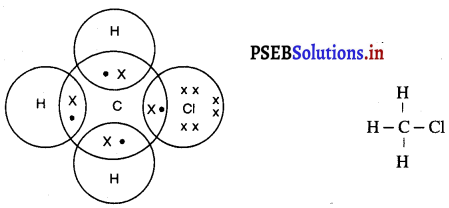




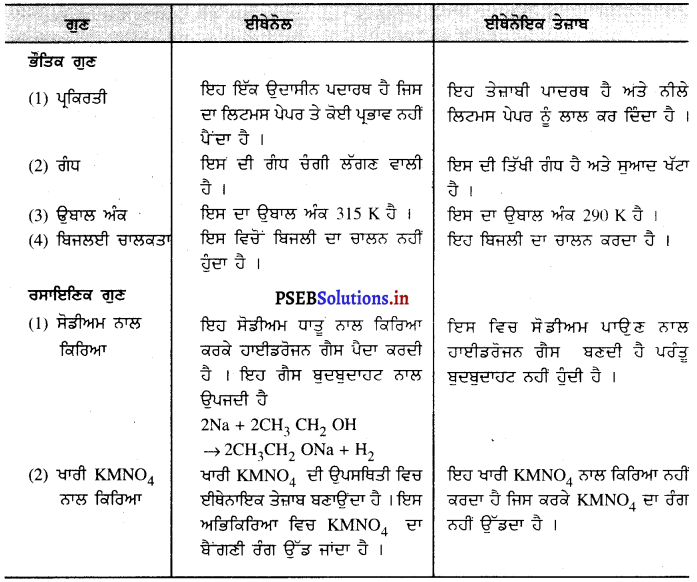

![]()



![]()
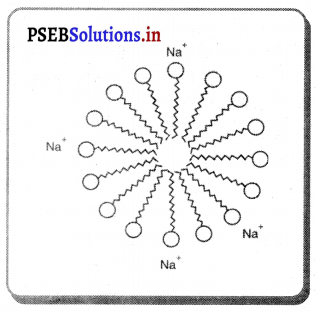
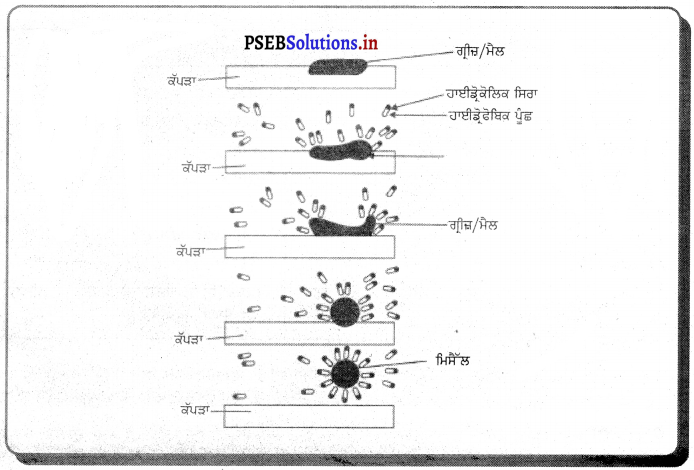

![]()


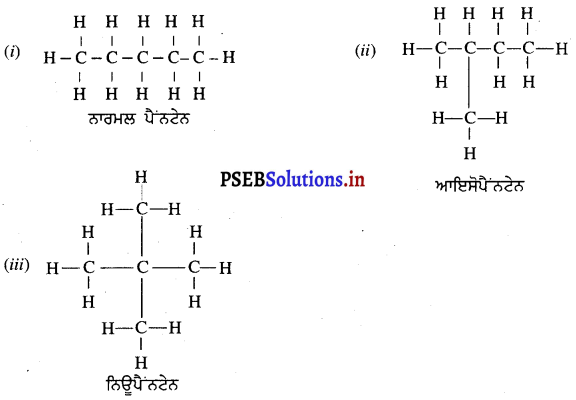
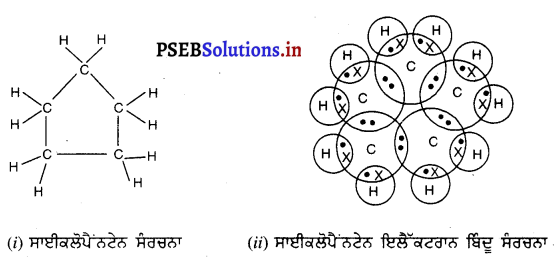

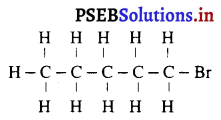


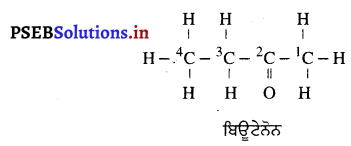

![]()
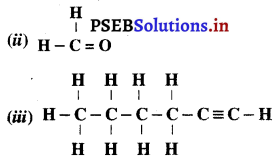


![]()
